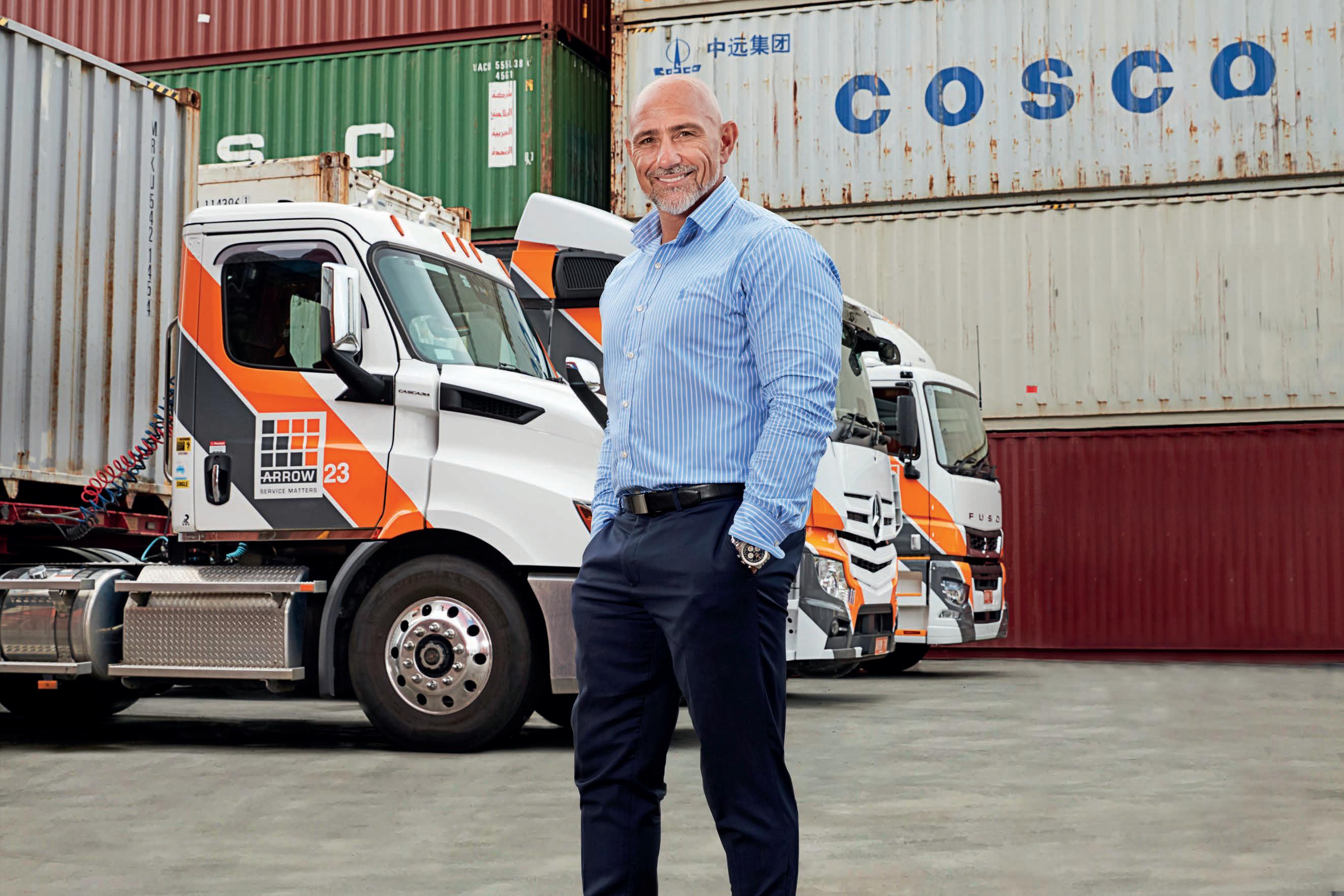

Arrow Transport Logistics Into Parts Unknown MAGAZINE Delivery Magazine inside: Pages 78-85. ® April 2023 ISSN 1838-2320 9 771838232000 03 APRIL 2023 $11.00 THE PEOPLE & PRODUCTS THAT MAKE TRANSPORT MOVE INDUSTRY Carrier: Wollongong Crane Trucks Feature: Easy Truck Rental Showcase: EWD & Fatigue Management Personality Profile: John Saint INNOVATION Fleet: Hazell Bros High Productivity: Recycal Test Drive: Hino 700 4x2 Delivery: Ford F-150










People talk about being in the “building game” but it’s no game, it’s serious business. And you need a serious truck to handle bigger payloads. Isuzu Ready-to-Work trucks can carry around a tonne more than a typical ute, most only requiring a standard car licence. So if you’re ready to get serious, head to isuzu.com.au or visit your nearest Isuzu Truck Dealer now. Warranty is subject to the conditions outlined in the IAL New Vehicle Warranty. For further information please visit isuzu.com.au or contact your local dealer. Features shown are available across Isuzu 4x2 Ready-to-Work models only. FSA/ISZS946 READY-TO-WORK RANGE Playtime’s over. Visit twusuper.com.au/insurance




























































































MEET THE TEAM
Australia’s leading truck magazine, Prime Mover, continues to invest more in its products and showcases a deep pool of editorial talent with a unique mix of experience and knowledge.
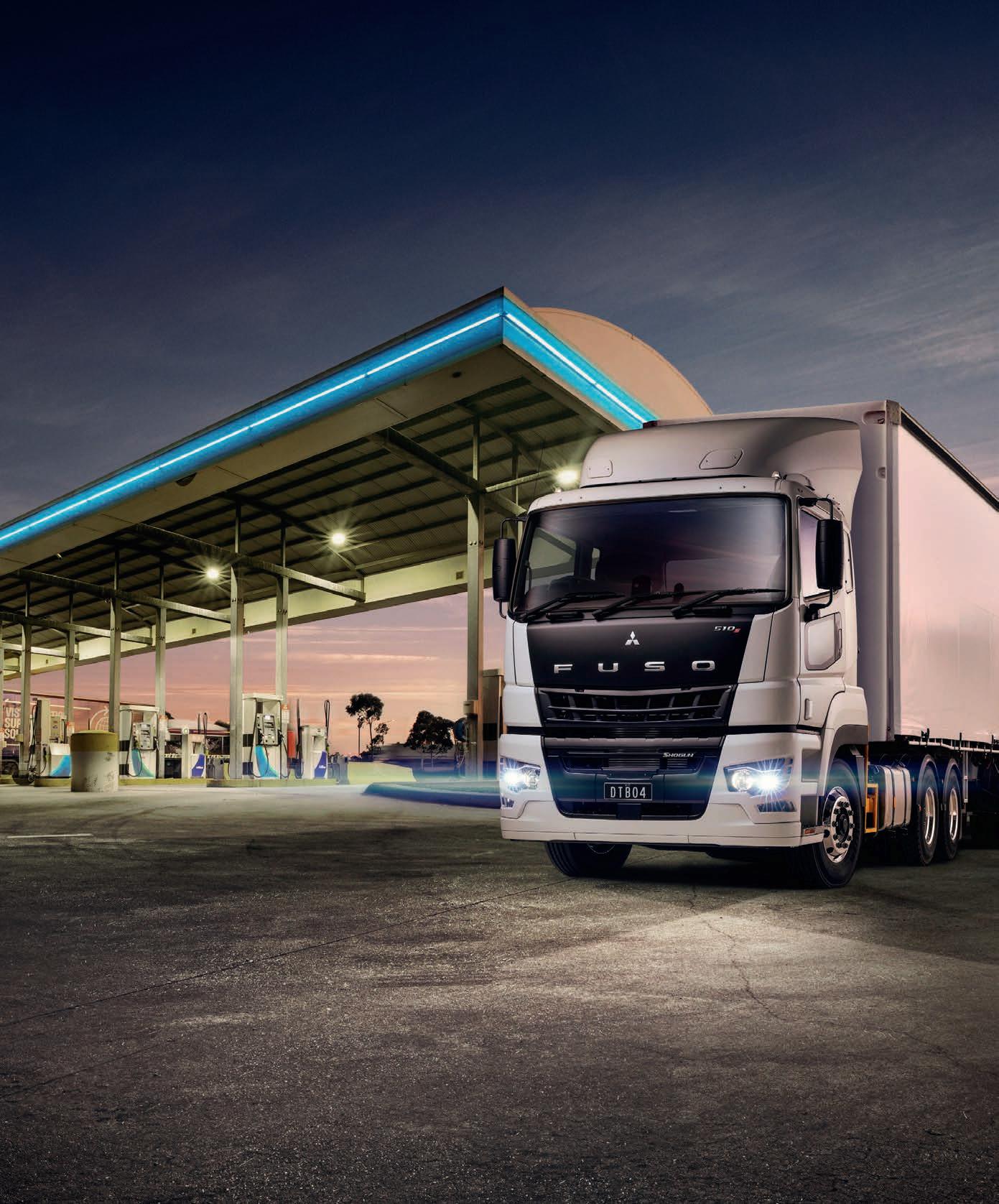

John Murphy | CEO
John has been the nation’s foremost authority in commercial road transport media for almost two decades and is the driving force behind Prime Creative Media becoming Australia’s biggest specialist B2B publishing and events company. Committed to servicing the transport and logistics industry, John continues to work tirelessly to represent it in a positive light and is widely considered a true champion for the growth of the Australian trucking and manufacturing industry.
William Craske | Editor
Over the past two decades William has published widely on transport, logistics, politics, agriculture, cinema, music and sports
He has held senior positions in marketing and publicity for multinational businesses in the entertainment industry and is the author of two plays and a book on Australian film history. Like many based in Melbourne he is in a prolonged transition of either returning or leaving.


Peter Shields | Senior Feature Writer
A seasoned transport industry professional, Peter has spent more than a decade in the media industry. Starting out as a heavy vehicle mechanic, he managed a fuel tanker fleet and held a range of senior marketing and management positions in the oil and chemicals industry before becoming a nationally acclaimed transport journalist.
Peter White | Journalist

Having recently completed his Bachelor of Media and Communication (Media Industries) degree at La Trobe University, Peter brings a fresh perspective to Prime Mover. Invaluable experience obtained during his time at upstart, La Trobe’s newsroom, has been supplemented by direct industry experience in a Council placement. Peter is looking forward to contributing to the magazine’s image as the leading publication for commercial road transport with his developed skills.



Ashley Blachford | Business Development Manager
Handling placements for Prime Mover magazine, Ashley has a unique perspective on the world of truck building both domestically and internationally. Focused on delivering the best results for advertisers, Ashley works closely with the editorial team to ensure the best integration of brand messaging across both print and digital platforms.
ceo John Murphy john.murphy@primecreative.com.au editor William Craske william.craske@primecreative.com.au managing editor, Luke Applebee transport group luke.applebee@primecreative.com.au senior feature Peter Shields writer peter.shields@primecreative.com.au
business Ashley Blachford development ashley.blachford@primecreative.com.au manager 0425 699 819
art director
Blake Storey blake.storey@primecreative.com.au
design Kerry Pert , Louis Romero, Tom Anderson
journalists
Peter White peter.white@primecreative.com.au
Anjali Behl anjali.behl@primecreative.com.au
design production
Michelle Weston manager michelle.weston@primecreative.com.au
client success Salma Kennedy manager salma.kennedy@primecreative.com.au
head office 379 Docklands Drive, Docklands VIC 3008 enquiries@primecreative.com.au
subscriptions 03 9690 8766 subscriptions@primecreative.com.au
Prime Mover magazine is available by subscription from the publisher. The right of refusal is reserved by the publisher.
Annual rates: AUS $110.00 (inc GST).
For overseas subscriptions, airmail postage should be added to the subscription rate.
articles
All articles submitted for publication become the property of the publisher. The Editor reserves the right to adjust any article to conform with the magazine format.
copyright
PRIME MOVER magazine is owned and published by Prime Creative Media. All material in PRIME MOVER magazine is copyright and no part may be reproduced or copied in any form or by any means (graphic, electronic or mechanical including information and retrieval systems) without written permission of the publisher.
The Editor welcomes contributions but reserves the right to accept or reject any material.
While every effort has been made to ensure the accuracy of information
Prime Creative Media will not accept responsibility for errors or omissions or for any consequences arising from reliance on information published. The opinions expressed in PRIME MOVER magazine are not necessarily the opinions of, or endorsed by the publisher unless otherwise stated.
Arrow Transport Logistics Into Parts Unknown Delivery Magazine inside: Pages 70-77. APRIL 2023 primemovermag.com.au ® April 2023 THE PEOPLE & PRODUCTS THAT MAKE TRANSPORT MOVE Carrier: Wollongong Crane Trucks Feature: Easy Truck Rental Showcase: EWD & Fatigue Management Personality Profile: John Saint High Productivity: Recycal Delivery: Ford F-150
www.primemovermag.com.au
JOB
JOBCOMMANDDONE RESPECT


demanding business demands a powerful truck. And with 510hp at your command, there’s no ignoring the 13 Litre Shogun 510 – the most powerful Japanese HD truck in the land.
Truck
THE FUSO SHOGUN 510 A
Since power belongs in safe hands, every Shogun comes with the world-leading safety features you’d expect from the Daimler
group. Add the peace of mind of a 5yr/500,000km warranty and the only stops you’ll be making are the ones you want. TO FIND OUT MORE ABOUT THE FUSO SHOGUN 510 VISIT FUSO.COM.AU
COVER STORY
“The drivers weren’t given much choice and very quickly, whatever the initial preconceptions, have accepted them. The feedback has been overwhelmingly positive in the right application.”






70 34 44
56 68
PARADIGM
SHIFT
Prime Feature Stories
FLEET FOCUS
34 Into Parts Unknown
As a relatively young business, Arrow Transport Logistics has blazed a trail that even the most elite start-ups would be at pains to replicate.

40 Lifting the Lid
Along with the straightforward jobs, the capability to resolve seemingly impossible challenges is an important offering from Wollongong Crane Trucks.
48 Making Milestones
Hazell Bros has turned to UD Trucks for new Quon 8x4 agitators it has recently activated in the various major projects it undertakes statewide in Tasmania.
TRUCK & TECH
52 Paradigm Shift
The first delivery of Hino 300 Series Hybrid Electric trucks have been accepted by Brisbane-based Easy Truck Rental, a new player poised to be a market leader in emissions reduction.

56 Large and in Charge
Commercial vehicle maker, Scania, currently has three battery electric vehicles in Australia for local assessment.
TEST DRIVE

70 This Sporting Life
A familiar sight at Australian motor sport events is the Hino Sports Deck which has become an integral part of the Supercars circus.
Regular Run
08 From the Editor 10 Prime Mover News 32 Mindset 64 EWD & Fatigue Management Showcase 74 Personality Profile 76 Prime Movers & Shakers 78 Delivery 86 ARTSA-I Life Members 88 Truck Industry Council 89 Victorian Transport Association 90 Peter Shields’ Number Crunch
52
William Craske Editor

An opportunity, when it presents itself, to acknowledge the herculean efforts of supply chain workers over the last few years best not be passed up. It takes rare fortitude to work long hours in a high-pressure job. To do that same job for several years, seemingly under siege, through what must have felt like a constant deluge of inventory takes an exceptional kind of soul. Some 1200 of these souls were informed by their employer just last month that the same job, the one they turned up for through lockdowns and social distancing and border closures and daily testing for the better part of two years, no longer exists. For the employees of Scott’s Refrigerated Logistics, who were part of the vanguard charged with keeping our supermarket shelves stocked when shortages of essential goods across the nation were a very real and present concern, such an ending would be no less consoling having finally made it to the other side of all that.
Judging by the heartfelt response of the wider community to the news Australia’s biggest refrigerated
Riders on the Storm
commercial carrier, had gone into administration, and then, without having found a buyer, liquidation, their efforts have, at least, not been in vain. CEO Nick Capp said it marked a devastating event for the cold chain industry but also, most importantly, for the people that made Scott’s Refrigerated Logistics what it was. “The team did not deserve this ending. As a broad comms to our peers in the industry and beyond, I would recommend you work aggressively to capture the Scott’s talent seeking new opportunities on this platform,” he said in a statement on LinkedIn that has garnered overwhelming support from industry. “I would love to reference their contribution to the business and the character and values they brought to their jobs every day.”

Endorsements don’t come any better.
To have endured the dark days of COVID policy and the tidal effect it had on ordaining additional barriers on industry, as it dragged on like fingers down a chalkboard, remains an achievement not just worthy of tribute. It’s a legacy deserving of national recognition. Let it be so.
Ernst Jünger wrote the book on crisis management. That book is the remarkable memoir, Storm of Steel In it he notes, “In war you learn your
lessons, and they stay learned, but the tuition fees are high.”
It might not have been war, as many a divisive political figure likened it, but COVID or at least the analogy for a great many businesses waking with its hangover, isn’t any less true, no matter how you soft-pedal it.
Industry, for the most part, has rallied around the people at Scott’s. Media too. For those paying off mortgages, as interest rates continue their steady climb, it’s likely of little comfort. No time is a good time to lose a job. There’s confidence, however, in the labour market that many of these people will be swiftly absorbed by competitors and adjacent companies desperate for talent. Border Express, Linfox and other major carriers, have already expressed interest in taking on many of the redundant Scott’s staff. Let’s hope it’s a quick process. If road transport does one thing well, perhaps, above all others, it’s providing the means of a rapid response to overcome sudden, disruptive challenges.
8 april 2023
BUILT FOR TOMORROW, DELIVERING TODAY.
THAT’S THE HINO
TRUST HINO TO BRING YOU HOME.


Why choose Hino to be your reliable transport solution provider? Our commitment begins by drawing on 80 years of design innovation and experience globally. We build every new model on the time-honoured principles of Quality, Durability and Reliability. We continue to set the standards for safety, performance, efficiency, and comfort, while harnessing technology that can help make sustainability a reality. We then promise to be your long term business partner through Hino Advantage, by offering a suite of business solutions aimed at reducing costs and minimising downtime. So, no matter how you’re driving Australia forward, we have the heritage, ongoing support, and next-generation of transport solutions available to help bring you home. You can trust Hino to deliver, now and into the future. Visit hino.com.au

XAVIER_HINO39638
> B-triple approved for ACFS operation in Brisbane
ACFS Port Logistics has been given the green light to run a B-triple on the Port of Brisbane. The high productivity vehicle can carry three 40-foot containers. With the successful trial run complete, the B-triple, pulled by a Mercedes-Benz Actros 3565, is now approved for full time operation. It follows a substantial period of design, collaboration and trialling with relevant logistics stakeholders to ensure it met with all necessary safety and transport standards.
At present Brisbane is the only port in the country committed to utilising the 42-metre-long B-triple combination.
The combination travels a daily circuit of just under 20 kilometres in a radius that encompasses the main stevedores.
It is anticipated the B-triple combination will, on average, increase productivity and efficiency by 33 per cent per trip with a further reduction of carbon emissions per container by an estimated 33 per cent.
The new Actros was recently part of a 50 truck delivery back in October. ACFS National Fleet Maintenance, Compliance Manager Alan Guest said the 650-horsepower prime mover pulls the triples beautifully.
“It’s a great concept and brilliant for us and brilliant for the port,” he told Prime

Mover





get numbers to ship quicker. On a stack run we will need to get 400 containers onto the ship in no time. This B-triple will make a big difference in that regard.”
Guest has appointed geofences, using MTData, on all trucks including the new B-triple.
In a statement issued online ACFS Port Logistics said it would be working with the terminal operators at the Port of Brisbane to ensure that the vehicle configuration is widely accepted, in order to achieve the above stated benefits.

> Volvo electric truck trials announced





Two electric Volvo trucks will soon hit the road for trial purposes according to the Government of Queensland. The trial includes the use of two Volvo battery-powered, three-axle prime movers, operating at a gross weight of 44,000kg.
“We’ve given Volvo Australia the green light to trial heavy duty battery electric heavy vehicles in Queensland,” said Premier Annastacia Palaszczuk. “These trucks can move up to 44,000 kg and they generate no emissions.”
Transport Minister, Mark Bailey, said the trials will see Volvo bring the latest zero-emission technology to
Queensland’s roads. “We know reducing transport emissions will play a key role in achieving net zero emissions in Queensland by 2050, and this trial is an important step towards that,” he said in a media conference. “The introduction of battery electric heavy vehicles provides opportunities to also bring vehicles with the latest safety technology features and emissions performance to our shores.”
The Volvos feature the industry’s latest safety features, including lane keeping assist, blind spot detection, passenger corner camera, dynamic steering with
accommodate, as is Australian Amalgamated Terminals,” the company said.
DP World and Patrick discussions were reportedly progressing well. Hutchison, at present, is not in a position to adopt the new B-triple configuration. Planning first commenced in June, 2022, when Andrew Rankin from Port of Brisbane and Wayne Jenkins from ACFS started a conversation about continuous improvement.
stability assist, under-run protection, collision warning with emergency braking and electronically-controlled brake systems.
According to Bailey, they are one of the safest vehicles on Australia’s roads. “Volvo have got a worldwide reputation in terms of road safety and it’s great to see them being a trailblazer here in terms of the Queensland and Australian market, around trialling electric trucks to get a sense of how they work in the Australian context,” he said.
“This is the latest gear in heavy vehicles and it’s going to be here on Queensland roads.”
PRIME NEWS
10 april 2023
PRIME NEWS
Mercedes-Benz Actros 3565 with three 40 footers.
































































































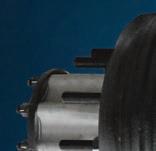

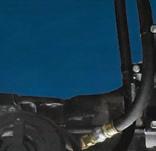









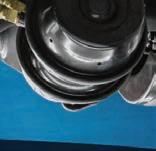






THE NEW D 190 FULL TIME PUMP HAS ARRIVED For more information contact Dana on 1300 00 DANA or visit us at www.Dana.com.au Strength • Power • Endurance ENGINEERED & BUILT IN AUSTRALIA
Hino announces 2022 best dealers
they do, and this award is a very fitting tribute to their efforts.”
CMI Hino Adelaide also won the Service Excellence Award.
The accolades didn’t stop there for SciFleet Hino Gold Coast, which also won the Sales Excellence (Regional) title for the second year and the Service Excellence (Regional) title.
“This award has been 12 years in the making and wasn’t something we dared to dream about, but it is nice to receive,” said Sci-Fleet Hino Gold Coast Dealer Principal Craig Andersson. “I am incredibly proud to receive award on behalf of the hard-working team at Sci Fleet Gold Coast.”
Metropolitan Dealer of the Year, while SciFleet Hino Gold Coast won the Regional Dealer of the Year title.
“After a tumultuous few years which saw last year’s event hosted virtually, it was important for our dealers to gather together and celebrate all of the achievements in 2022,” said Sam Suda, President and CEO of Hino Australia. “It

Nathan Chatfield, General Manager of CMI Hino Adelaide paid tribute to his team when accepting the award for the fourth time.
“We are a very proud, long term Hino dealer – Hino is in our blood and our DNA,” he said. “The CMI Hino Adelaide team is such a wonderful group of people who work incredibly hard at everything
> End of an era for Australia’s biggest cold chain carrier
After entering voluntary administration, Scott’s Refrigerated Logistics, the country’s biggest integrated coldstorage logistics group, has failed to find a buyer.
Operating a massive fleet of over 600 prime movers and rigids, the firm had provided refrigerated trucks and warehouses for businesses including Coles, IGA and Aldi. It is understood the supermarket giants are looking to shore up supply chain in wake of the recent collapse that will cost at least 1200 staff their jobs.
Scott’s also had a sizeable share of cold storage in Australia, a sector worth around $1.2 billion.
The business posted $542.9 million in
consolidated revenue for the 16 months ending June 2021. Spiking fuel costs, flood events, labour shortages and the lingering effects of COVID-19 on industry proved too big an obstacle for the business as it tried to overcome reported losses of $7.3 million.
In an effort to shed the debt-heavy logistics business, former parent Eagers Automotive sold Scott’s to private equity firm Anchorage Capital Partners in June 2020 for nearly $75 million. A $70 million asset-backed funding facility secured via investment firm Gordon Brothers to assist Anchorage also failed to help turnaround the business.
KordaMentha were appointed as receivers but failed to find a buyer
For the second consecutive year, CMI Hino Adelaide, Jacob Hino (AlburyWodonga), Sci-Fleet Hino Brisbane, Sci-Fleet Hino Gold Coast and CMI Hino Melbourne were recipients of the prestigious President’s Award and were joined by Barry Maney Hino (Mt Gambier), which received it for the first time.
“The 2022 recipients demonstrated excellence in all aspects of Parts, Sales and Service and I congratulate each dealership team for their efforts during 2022,” said Suda.
despite reports Lindsay Australia and Linfox had shown interest.
Minister for Infrastructure, Transport, Regional Development and Local Government Catherine King said the government was disappointed with the news of Scott’s collapse.
“Our thoughts are with the workers and their families at this time of uncertainty,” said King. “We have been following the situation closely in recent days and are grateful to those supermarkets who have been working constructively with unions and with the administrators and receivers to help minimise the impacts of this situation on our cold supply chain.”
Scott’s assets were being apportioned for sale in the coming weeks.
PRIME NEWS >
12 april 2023
PRIME NEWS
Nathan Chatfield, Sam Suda and Craig Andersson.
> Purple Quon launched to support female recruitment
Followmont Transport has unveiled a purple themed truck in celebration of International Women’s Day. The new 14-pallet UD Quon has been painted purple as a mark of endorsement for women’s equality. A tagline “embracing diversity in transport” with a giant W faded into the background features on the curtains. Managing Director, Mark Tobin, said the truck is dedicated to the women of Followmont Transport and acts as a travelling billboard to promote diversity in the road transport industry.

“We are very fortunate at Followmont to be surrounded by so many talented women, who all contribute to make our business the great company it is today,” he said.
“It doesn’t matter if they have been here for their whole career, or they are only new, the passion and enthusiasm they bring to their roles does not waver.
“We all enjoy working as a team and we want to spread the word to have more females understand the different career opportunities available to them in transport.”
With the transport industry not always top of mind for female job seekers, the campaign aims to change people’s
career paths on offer. Local PUD Driver for Followmont, Kellie Hayden, featured in a video to support the events message. In it she explained how starting with the company was the best decision she has made.
“I got my truck licence four years ago and drove past Followmont every day for three years, and then six months ago I got the opportunity to join the team, and I’ll never change that,” she said. “I would highly recommend the transport industry to any female and would tell them to just come and give it a go.
In partnership with Commonwealth
> Driver health boosted by new partnership
A new partnership between Healthy Heads in Trucks & Sheds (HHTS), Prime Creative Media (PCM) and Australian Truck Radio (ATR) has been announced. As part of a joint statement PCM and ATR said they were proud to support HHTS for the great work it continues to do within the transport industry.
“People who work in the road transport, warehousing and logistics industries have long faced challenges relating to mental health and wellbeing.
Stigma surrounding mental health is a component that leads to poor uptake of existing resources and support services, such as Employee Assistance Programs (EAP). As a result, the sector is ranked the lowest of 19 sectors in Australia when it comes to thriving workplaces,
according to Superfriend’s Thriving Workplace Study in 2021. HHTS Chief Executive Officer, Naomi Frauenfelder, said the stigma around mental health in this sector is a key risk factor and barrier for help-seeking.
“As such, the primary objective of many of our resources and programs is to drive a reduction in mental health stigma and improve access to information,” she said.
“This invaluable partnership with Australian Truck Radio provides a medium for us to connect directly with those on the road and the broad range of people in our industry working 24/7 to keep our supermarkets stocked, our cars fuelled, and our packages delivered,” said Frauenfelder.
hosted industry operators, suppliers, and partners, all coming together to not only celebrate women in transport, but to act as champions and brainstorm how to attract more females into industry.
Lauren Pulitano, Vice President, Government Sales & UD Trucks Australia, the official MC for the event, was thrilled to take part in the handover.
“I was truly honoured when Followmont approached me to lead the celebration, seeing everyone come together shows we are all ambassadors and I feel proud to know our industry is in good stead,” said Pulitano.
Getting the word out to drivers on the road through Australian Truck Radio was important according to Prime Creative Media CEO, John Murphy, who said PCM was proud to be working with HHTS.
“It is a great way to reach a large number of those working on the road and they can listen anywhere and anytime,” he said. “We can also share where they can obtain the resources available to assist on their road back to better mental health.”
The partnership aligns with PCM’s values of growth and humility by supporting HHTS and the support it provides those in need in essential service roles.
Prime Creative Media is the parent company of Prime Mover
primemovermag.com.au 13
John Coombes, Mark Tobin & Lauren Pulitano.
> Followmont poised for expansion
Followmont Transport continues to grow and is extending its services through acquisition. Following the recent acquisition of North Queensland based, Bradco Transport, Managing Director, Mark Tobin, commented that the business is looking into other areas that offer a strategic solution for their customers.
“Followmont has a clear business and growth strategy, seeing us target acquisitions that add value to our customers, progressively growing and ensuring service levels are maintained,” said Tobin.
Working with Bradco owners since October last year, Followmont’s Senior Executives, identified the opportunity to leverage Bradco’s existing network and provide additional infrastructure for their
produce service.
This approach has reportedly resulted in 80 per cent growth for the FNQ Solutions arm of Followmont and has meant they have been able to assist their valued customers in their own business growth and begin to build solid foundations with new customers.
Tobin said the venture had been on the cards for some time as they have a close relationship with the Bradley family. “I have the upmost respect for Ken and everything he has achieved with his family and through his career,” he said. “So after many discussions on his retirement, I knew Followmont would serve his customers well, carry on the partnerships he had created and also offer future growth for Followmont’s existing customers.”
> Adelaide DAF dealer makes mark
Kenworth DAF Adelaide has been named the 2022 DAF Dealer of the Year. It marks the first time the Kenworth DAF Adelaide has taken home the top prize since its introduction in 2002.
The DAF Dealer of the Year award was presented to Kenworth DAF Adelaide Managing Director, Jonathan Crawford. The award acknowledges dealer performance across all areas of the DAF business and recognises excellence in truck sales, parts sales, service, finance, and overall customer support — all areas

in which Kenworth DAF Adelaide excelled throughout 2022.
Kenworth DAF Adelaide is situated on a large 12-acre site, boasting the latest, state-of-the-art truck sales, truck rental, service and parts facilities making it one of Australia’s most advanced truck dealerships.
Andrew Hadjikakou, PACCAR Australia’s Managing Director, presented the Dealer of the Year trophy, congratulating Crawford in person.
“In a year that still showed remnants of the
Followmont’s successful model has seen the company sustainably grow year after year and future proof their business through their property portfolio.
“Our property is actually the backbone of our business,” said Tobin. “We developed Bootooloo Property in 2017 with the intention of owning our own assets, controlling our future, and driving organisational agility.”
The significant real estate portfolio allows Followmont to leverage its property plan and maximise return on investment.
Since July 2016, Followmont has invested over $180 million in its fleet, network infrastructure and property and has plans to invest up to $230 million more in the coming years.
pandemic and presented challenges due to global supply chain issues, Kenworth DAF Adelaide continued to not only exceed expectations, but also demonstrated the team’s drive to deliver an excellent customer experience in service and support to our DAF customers,” said Hadjikakou.
Crawford was delighted his team won the award.
“Despite a challenging year, the result is worth it,” he said. “I couldn’t be more proud of the entire team across our three locations for going that extra mile every day. To win feels like a well-deserved reward and one that certainly belongs to every member of the team.”
He added the award also belonged to Kenworth DAF Adelaide’s great customers, who continued to place their faith in the dealership to support their business.
“The strength of our relationship with the PACCAR team certainly contributes to this success. I want to thank everyone at PACCAR for their highly valued levels of support,” said Crawford.
Kenworth DAF Adelaide, also known as CMV Truck Centre, is part of the CMV group.
PRIME NEWS
14
PRIME NEWS
Michael Long, Jonathan Crawford, Andrew Hadjikakou and Mike Dozier.



> Arrow Transport appoints new Group General Manager
As part of its expanding operations, Arrow Transport has promoted Barbara Karipis to the role of Group General Manager. The business has expanded in recent years to operate out of the five major ports around Australia. In light of this expansion, the company has identified the requirement to have a high performing head office.
To lead Arrow into its next phase of growth the board saw it necessary to appoint the right Group General Manager. It certainly did not have to
look very far.
Karipis, who had previously worked alongside Arrow Managing Director Craig Webster at Chalmers for nine years, was brought over in 2017. Since then, she has handled operational accounts, established and managed backroom offshore functions, set up and managed Arrow’s centralised invoicing team and held the role of Chief Financial Officer. It’s no surprise the appointment came from within, given Karipis strong
> Hyzon previews locally built hydrogen truck
Hyzon Motors unveiled today its Heavy Rigid truck platform, an Australian locally designed and built Hydrogen Fuel Cell Electric truck. Hyzon is developing its Heavy Rigid truck as a global platform, adaptable for international markets, with a multitude of vehicle use cases, such as garbage compactors, tilt trays and flatbed trucks.
The development of the Heavy Rigid program in Australia has allowed Hyzon Motors to tap into the rich resources of highly skilled local Australian engineering and technical knowledge, the hydrogen truck maker said in a release it issued today, as it looks to build a team, process, and product for Hyzon’s global and domestic market. President of International Operations, John Edgley, said the announcement was a ‘real game changer’ for Australia and New Zealand.
“We are building our zero emission heavy vehicles right here in Australia, using local skills, employing local people, and collaborating effectively with our colleagues across the globe”, he said. “Our vehicle development process is following a path of design, build and validation to make use of resources that are available in Australia and provide an opportunity to train new engineers and technicians.
“Incorporating global market requirements and standards into our design philosophy has allowed the vehicle to be easily adaptable not only to international markets, but also with a multitude of use cases.”
Hyzon Motors Inc. President and interim CEO, Parker Meeks, welcomed the milestone announcement as an important step in building the company’s manufacturing capacity globally.
“Hyzon’s core fuel cell technology
history of exceptionalism the company said in a statement. Customeroriented, Karipis also played a key role in the development of the company’s internal operating system, AOS. “With her natural leadership skills, industry knowledge, customer focus, true passion for the business and its success, a work ethic second to none, I think its fair to say she appointed herself,” said Craig Webster, Arrow Managing Director. “And I could not be happier.”
has a distinct competitive advantage which will allow us to innovate and introduce high-performance vehicles that support the transition to net zero,” he said. “Hyzon’s Australia and New Zealand team has led the way on the design and development of our Heavy Rigid platform and are recognised as a global leader within our business.”

Hyzon’s Heavy Rigid truck is expected to hit the road in a number of commercial trials throughout 2023 in both Australia and New Zealand.
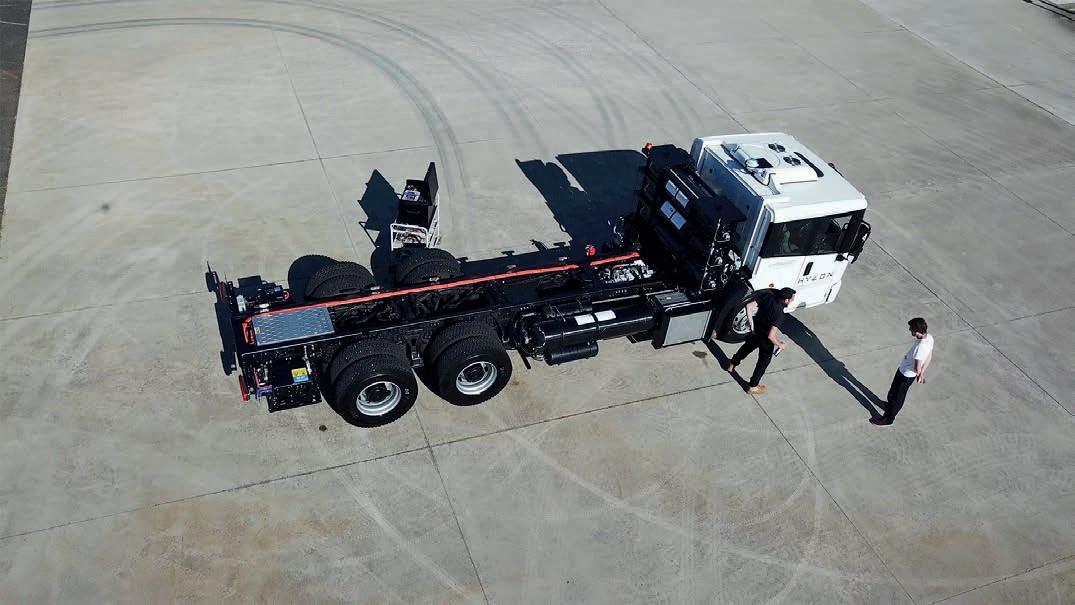
PRIME NEWS 16 april 2023
PRIME NEWS
Hyzon’s Heavy Rigid fuell cell truck at a launch in Melbourne.
Optimize your fleet with data-driven insights and AI powered by the #1 global telematics provider.
One platform for connected and sustainable fleet performance.
Geotab’s AI-driven platform transforms real-time data from any source into actionable insights that provide measurable business value, help reduce fleet’s emissions and costs while improving operational efficiency. Optimize your fleet’s performance and stay ahead of the competition.
geotab.com.au

> Australia Post deploys first Volvo Electric truck
Australia Post has taken delivery of its first Volvo Electric vehicle. Part of a sixmonth trial, the Electric FL utilises four batteries to achieve an energy capacity of 265 kWh.
The Volvo has a range of up to 300 kilometres depending on application with a payload of up to 5,500kg. An electric driveline provides 425Nm of torque, which is delivered to the rear wheels via a 2-speed automated transmission.
Electric FL maintains a full suite of active safety systems including Autonomous Emergency Braking. The Electric FL also achieves the rigorous Swedish BOF10 crash rating which surpasses current European crash test standards. “It’s very rewarding seeing these vehicles go into service after so much hard work ensuring they are the right fit for both our market and the applications they are being put into,” said Tim Camilleri, E-mobility Manager, Volvo Group Australia. “These vehicles are
proving themselves day in and day out around the globe.”
Camilleri made a point that Volvo doesn’t experiment on its customers.
“We work with them to deliver the right zero emissions outcome for their business and that means advising on utilisation and charging as well,” he said. “In this case the FL Electric is an excellent fit for Australia Post.”
The trial, according to Australia Post Divisional General Manager South, James Dixon, demonstrates Australia Post’s commitment to innovation and sustainability.
“We have worked hard to help reduce our carbon emissions over the last decade, including by adopting low and zero emission vehicles where possible with the largest fleet of electric delivery vehicles in Australia,” he said. “The truck has been in service for a couple of months now and is performing well,” said Dixon. “We will continue to push electric vehicles into our fleet whenever
we can to help reduce emissions wherever we can.” Volvo Trucks Australia has had Medium Duty battery electric trucks operating successfully in Australia since mid- 2021. With the assistance of the National Heavy Vehicle Regulator, Transport and Main Roads QLD, Volvo Trucks Australia has recently been given the green light to begin local validation of Heavy-Duty electric trucks on Queensland roads at weights of up to 42,500kg. These vehicles will have the latest heavy vehicle safety features such as lane keeping assist, blind spot detection, passenger corner camera, dynamic steering with stability assist, underrun protection, collision warning with emergency brake and electronically controlled brake systems.

Originally purchased for Melbourne, the Volvo FL Electric is now based at Australia Post’s Redbank Plains Distribution Centre on the outskirts of Brisbane.

PRIME NEWS 18 april 2023 PRIME NEWS
Volvo Electric FL.
More power, same great truck
The 11L Quon just got even better with its latest enhancements improving its already outstanding performance.
The upgraded driveline features an, improved ‘GH11 Engine’ with increased horsepower and torque, and the legendary ESCOT 12-speed automated manual transmission is now even better with new software enhancements that have to be tried to be believed.
These upgraded features have the added bonus of delivering an even smoother ride for comfortable driving with minimal fatigue.
For 50 years, UD Trucks have delivered ultimate dependability. No wonder this is the truck Australia trusts.
Going the Extra Mile
To find out more, contact your UD Trucks dealer on 1300 BUY A UD or visit udtrucks.com/australia


Follow us on


THE
TRUSTS
TRUCK AUSTRALIA
> Daimler regional dealer takes home top honours
An Albury dealership has taken out the prestigious Daimler Truck Australia Pacific Dealer of the Year Award for 2022. At a gala event held in Melbourne, Daimler Trucks Albury was honoured for the way it had reinvigorated the Mercedes-Benz, Freightliner and Fuso brands in its region. Daimler Truck President and CEO, Daniel Whitehead, presented the award to Daimler Truck Albury Dealer Principal, David Warren.
“Daimler Trucks Albury represents a remarkable success story, having thrived since David Warren and the team took hold of the reigns in early 2020,” he said. “A highly respected local, David leads a highly motivated team [and] raised customer support to remarkable levels,” Whitehead continued, before acknowledging Daimler Trucks Albury as a clearly deserving winner.
The Daimler Trucks Albury team is the sister store to another successful dealership in a key freight corridor: Daimler Trucks Wagga.
Both Daimler Trucks Albury and Daimler Trucks Wagga recently
achieved Elite Support certification, a dealership initiative that delivers the highest levels of customer experience.
“We know our Daimler Truck customers really appreciate the outstanding support delivered by these two dealership teams,” said Whitehead.
Daimler Trucks Albury also took out the Mercedes-Benz Trucks Regional Dealer of the Year and Freightliner Regional Dealer of the Year awards.
> Hino expands hybrid electric range
Hino Australia has confirmed its Hybrid Electric Built to Go range will be available in Hino dealerships from July 2023. For the last 15 years, Hino has led the way with low-emission trucks in Australia with more than 700 Hybrid Electric trucks currently on Australian roads.
Rising fuel prices and an increased focus from customers wanting to minimise their environmental impact has seen sales of Australia’s only Hybrid Electric light-duty truck soar according to Daniel Petrovski, Department Manager – Product Strategy for Hino Australia.
“The introduction of the new Alloy Tray and TradeAce Built to Go models to our Hybrid Electric range offers customers a high quality, cost effective and versatile drive-away solution that can reduce business operating costs from day
one,” he said.“Not only do our Hybrid Electric models meet Euro 6 exhaust emissions standards, but recent realworld trials comparing the proven Hino Hybrid Electric truck against a traditional diesel equivalent revealed a 22 per cent reduction in fuel use and CO2 emissions.” Greater savings are achievable depending on the application of the vehicle and how it is driven.
Hybrid Electric customers will also reportedly benefit from a reduction in maintenance costs.

The Hino 300 Series Built to Go Hybrid Electric TradeAce models are fitted with a Hino Genuine aluminium tray, ladder racks and a Hino Genuine premium Bullbar (Wide Cab) or nudge bar (Standard Cab).
The 300 Series Alloy Tray range features the same base aluminium tray body
The Fuso Regional Dealer of the Year Award was presented to Daimler Trucks Sunshine Coast, while the Fuso Metro Dealer of the year Award was awarded to Sydney’s STM Trucks and Machinery.
Daimler Trucks Gold Coast won the Mercedes-Benz Trucks Metro Dealer of the Year, while Daimler Trucks Perth was announced as the winner of the Freightliner Metro Dealer of the Year.

specification as the TradeAce models but without the ladder racks and nudge/ bullbar. The 300 Series Hybrid Electric Built to Go range includes the 616 Standard and Wide Cab 4.5 tonne GVM car-licenced models through to the 716 Wide Cab with a 6.5 tonne GVM.
“The new Hybrid Electric Built to Go models will be of particular appeal to tradespeople and small business operators who are seeking a versatile drive-away solution that can reduce operating costs from day one,” said Petrovski.
Like all Hybrid Electric models, the new Built to Go models will feature Hino SmartSafe, which features advanced driver-assist technology that takes an active focus in protecting the lives of all road users.
PRIME NEWS 20 april 2023 PRIME NEWS
David Warren with Daniel Whitehead.
Reduce paperwork, save time and money with an NHVR approved EWD solution
Live Fatigue Dashboard
Get real-time fatigue information for each of your drivers to better understand work hours and their availability to complete jobs.


Reduce Inaccuracies
With a proactive approach to managing compliance, you no longer have to wait days to manually check fatigue.
Real-time Driver Breakdown
Drivers gain access to instant fatigue work and rest hours calculated in real-time, letting them focus on the road ahead.
1300 111 477 TeletracNavman.com.au/EWD
> CEO role goes vacant as Kim Lindsay steps down
Chief Executive Officer, Kim Lindsay, has announced his retirement from Lindsay Australia. Lindsay, with the full backing of the Board, officially steps down on 30 June 2023. A central figure behind much of the growth of the business, Lindsay has given Lindsay Australia 20 years of uninterrupted and distinguished service as CEO.
Having worked for Lindsay Brothers Transport from 1974 to 1983, Lindsay went on to establish P&H Rural Supplies Pty Ltd in 1983. As Managing Director of PHRS, Lindsay was responsible for expanding the business from a small local operation to a major regional business, serving as the foundation for the current
Lindsay Rural division. Ever since P&H Rural Limited and Lindsay Brothers Holdings Pty Ltd were merged including its subsequent listing on the ASX in December 2002, Lindsay has served as Managing Director and CEO of Lindsay Australia. Under his leadership, Lindsay Australia has risen to become one of Australia’s largest transport companies employing over 1,500 employees. During his time as CEO, Lindsay Australia has grown from operating revenue of $144.3 million and EBITDA of $12.3 million in 2003 to revenue of $553 million and EBITDA of $60.1 million in FY2022.
The company is currently on track for a record year in FY2023 with EBITDA
> Viva Energy announces ‘outstanding’ FY2022 results
Market volatility and ongoing disruption has failed to diminish exceptional sales and earnings growth for Viva Energy. The owner of the Geelong Refinery and licencee of Shell fuels and lubricants has reported strong financial results across all parts of the company for FY2022. Retail delivered EBITDA of $249.6 million in FY2022, a 33 per cent increase on the prior corresponding period.
Sales volumes increased by 7 per cent to 4,515 million litres, led by the more regionally located Dealer Owned and Liberty Convenience networks which continue to benefit from the addition of new stores since FY2021. The Liberty Convenience network now stands at 94 stores.
Sales volumes growth increased by 9 per cent to 9,737 million litres, led by the recovery in Aviation and Marine and strong wholesale and agricultural demand.

New customer wins, high demand, and steady sales growth across its other commercial businesses also contributed to what the company called an “exceptional
commercial performance.”
The Alliance (Coles Express) network achieved weekly fuel volumes of 57.3 million litres in FY2022, 3 per cent above the prior year. In order to accelerate its strategy to transition to a fully integrated fuel and convenience retailer, Viva Energy announced the acquisition of the Coles Express convenience retailing business for $300 million last September. Completion of the sale is on track for the second quarter of FY2023.
Full-year dividends reported by the company as 27¢ a share were higher than initially anticipated.
The refining business benefited from a very strong refining margin environment driven by recovering global demand, reduced refining capacity from closures and outages, and supply chain disruptions according to Scott Wyatt, Viva Energy CEO and Managing Director.
“The inherent diversity within our businesses, with exposure to a broad range of sectors and products, is a core strength and competitive differentiation which has again served
forecast to be in the range of $68 million to $71 million.
“There is no question that Kim will leave Lindsay Australia wellpositioned to achieve the Group’s significant ambition of reaching annual revenue of $1 billion and EBITDA of $100 million whilst driving shareholder returns over the coming three to five years,” the company said in a statement. “The board will consider internal and external candidates in its CEO search and has retained a leading recruitment firm to assist with the process. After an appropriate break, the board will engage with Kim regarding an ongoing non-executive role with the company.”
us extremely well this year,” he said in a statement. “I am extremely pleased with the performance of our business and the progress we are making on our strategic priorities. We have retained a robust balance sheet for further growth, and are pleased to be able to return a dividend at the top end of our dividend policy.”
This year, for Wyatt, represents a major step forward in building a leading convenience business through the acquisition of the Coles Express convenience retailing business.
“The convenience market presents considerable non-fuels growth opportunities which we intend to pursue through this acquisition, as well as improving the general operating efficiency by bringing our fuel and convenience businesses together under one operation,” he said. While fuel demand continued to be impacted by changes in mobility and working modes, expectations were for it to remain robust.
The Geelong Refinery delivered EBITDA (RC) of $517.9 million in FY2022, a more than five-fold increase on the prior year.
PRIME NEWS
22 april 2023
PRIME NEWS
8% Better! The future is lean and green.
While no one can predict the future with absolute certainty, we’re confident it’ll be brighter with the new Scania Super. Our new powertrain has already gained a reputation for not only providing the smoothest drive on the road but also being the most fuel efficient in it’s class. Our new 13-litre platform, which now extends to 560hp, delivers a fuel saving of at least 8 %* allowing you to increase your fuel efficiency while also reducing greenhouse emissions. But it doesn’t stop there. As with our new V8 engine family the Scania Super 13L engine can also be run on B100 biodiesel**, further reducing your CO2 emissions by up to 80% with no adverse impact on engine performance.
So if you’re ready to meet the commercial and environmental challenges of today and tomorrow, you’re ready to meet the all new lean green Scania Super.
Contact your nearest Scania Account Manager or go to www.scania.com.au to find out more.

 *The new Scania Super powertrain, with the combustion engine as its centrepiece, will deliver a fuel saving of at least 8% compared to Scania’s current 13 l engine (DLU). The comparison is made for long distance operations. **Applies to 13-litre 460hp & 500hp and 16-litre 590hp only.
*The new Scania Super powertrain, with the combustion engine as its centrepiece, will deliver a fuel saving of at least 8% compared to Scania’s current 13 l engine (DLU). The comparison is made for long distance operations. **Applies to 13-litre 460hp & 500hp and 16-litre 590hp only.
On their first day the apprentices were welcomed by Cummins’ Director of Operations, Ben Lister, who shared his hopes and aspirations for their program of learning. During the twoweek program, the apprentices were introduced to Cummins leaders, staff and customers. They also had the unique opportunity to attend site tours at the
The 79 apprentices will be located across
Cummins Training Manager, Kate Evans, told Prime Mover that the Apprentice Program was created to maximise the diversity of Cummins’ future technician talent pool.

“Our 2023 intake recently participated in a two-week onboarding program in Melbourne, demonstrating our commitment to inspiring and
> Isuzu regional dealer claims top prize


Isuzu Australia’s Dealer of the Year award has gone to Ballarat Isuzu. In an impressive feat, the regional Victorian dealer also claimed awards for Service Dealer of the Year and Sales Dealer of the Year for 2022.
Isuzu’s Dealer of the Year Award recognises outstanding achievement in customer support and all facets of a dealership’s business, including sales, service and parts, with the performance of all 35 dealerships in the Isuzu dealer network across the country assessed via the Dealer Evaluation process. The final gong in the 2022 Dealer of Year Awards went to another regional dealership, the Gippsland Truck Centre, which took out the Parts Dealer of the Year award.
IAL Director and Chief Operating Officer Andrew Harbison said the Ballarat Isuzu team had put in a stellar effort to take out the overall award as well as the sales and service accolade.
“Dealer Principal Ian Deacon and everyone in the Ballarat Isuzu team
really knocked it out of the park this year,” said Harbison. “On behalf of IAL I’d like to offer our congratulations and appreciation of the determined and consistent effort of the team – thank you to each and every one of you.”
Ian Deacon, Ballarat Isuzu’s dealer principal, has previously accepted Isuzu Dealer of the Year Awards in 2020, 2018, 2017 and 2016.
“It’s truly an honour to be recognised as the Dealer of the Year again, especially given the stiff competition we’re always up against,” said Deacon. “The team in
encouraging our apprentices to reach their full potential,” she said. “The apprentices undertook HSE training, practical technical training on engines, and visited sites such as our Laverton branch, Cummins Filtration and the PACCAR factory. This gave them insight into the breadth of opportunities within the industry.”
According to Evans, these activities ensured the apprentices had the opportunity to network with staff across various functions of the business.
“The program also included a presentation from one of our customers, which helped them develop an understanding of how important our customers are to the success of our business,” she said. “The program managers shared an overview of possible opportunities to the apprentices and how they can turn their passion into a thriving career.”
service and sales have been working really hard, they’ve gone above and beyond. It’s been really exciting to set records for sales volume and service growth. It’s been a really big year for Isuzu and a great year for the dealership as well.”
Harbison said both Ballarat Isuzu and Gippsland Truck Centre demonstrated the drive, innovation and commitment to customer service that have allowed IAL to achieve 34 years of consecutive market leadership.

IAL Head of Network Development Ella Letiagina added her congratulations to the 2023 Dealer of the Year Award winners.
“The annual Dealer of the Year Award is an opportunity for IAL to give back to our hard-working dealer network, who continue to support the Isuzu brand with outstanding customer support, and superior results in sales, parts and service,” she said. “It’s wonderful to see such performance. Both teams have done incredibly well.”
PRIME NEWS PRIME NEWS
24 april 2023
The Cummins new apprentices.
Ella Letiagina, Ian Deacon and Takeo Shindo.


Kenworth Dealer of the Year announced
meeting these expectations but have also gone above and beyond in providing the highest standards of customer service and professionalism,” he said.
“Caboolture’s continued investment in its people and facilities is exemplary, offering customers the latest products and services and industry know how, all the hallmarks of a leading PACCAR Dealer and setting an excellent example for the industry.”
Humbled to be accepting the award, newly appointed Caboolture Dealer Principal, Dylan Hurley, dedicated the award to outgoing Dealer Principal, Darryl Evans, thanking him for his leadership and overall contribution towards the success of the dealership.
Dealer of the Year for 2022. It’s the first time the dealership has been recognised by Kenworth with the prestigious award. The award was presented at PACCAR’s annual dealer event with Brown and Hurley Kenworth DAF Caboolture being announced victors among PACCAR’s 93 locations across Australia, New Zealand, and Papua New Guinea. During proceedings, the Caboolture dealership was also named Cummins Dealer of the Year for 2022.

Highly sought-after, the Kenworth Dealer of the Year accolade is awarded to the

service, truck sales, finance and leasing, parts support, and overall dealership performance.
At the awards ceremony, PACCAR Australia’s Managing Director, Andrew Hadjikakou, applauded the Caboolture dealership for their outstanding performance and unwavering commitment to customers.
“In an extremely competitive and challenging environment, customers continue to expect more from dealers. Brown and Hurley Kenworth DAF Caboolture have not only excelled in
> Industry calls for moratorium on road user charge
The National Road Transport Association has issued a statement in support of broader industry calls for a freeze on heavy vehicle charges in 2023-24. It’s part of a response, lodged by NatRoad, to the National Transport Commission’s (NTC) consultation paper and it aligns with the Australian Trucking Association (ATA).
“We are both asking for a freeze on charges next year and for increases in the two financial years after that to be limited to 2.75 per cent,” said NatRoad CEO Warren Clark. “We also agree with the ATA’s call for a lower remote area road user charge set at half the national
road user charge rate.”
Clark said continuing high fuel costs is just one of the burdens that trucking businesses are expected to absorb.
“Inconsistent and poorly communicated state border closures, purchasing COVID-19 related PPE, higher AdBlue costs and the impact of the previous government’s sixmonth fuel tax cut are all hitting our industry,” said Clark. “From 1 April to 18 August 2022, some 2,000 heavy on-road transport operators had to negotiate payment arrangements with the ATO because of the fuel tax Budget decision.”
“On behalf of the entire Caboolture team, it is with great pride that I accept this award, and we are especially honoured to be recognised as the top performing dealer by Australia’s leading heavy-duty truck manufacturer,” said Hurley.
“I would like to thank our dedicated team of sales, service, and support professionals, and it is great for them to be recognised for their outstanding efforts,” he continued.
“Thanks also to the team at PACCAR for providing incredible products that enable us to deliver for our customers and support them with their business needs.”
Clark said the existing heavy vehicle cost base is meaningless, as it uses state governments’ road expenditure figures without any audit or appraisal.
“It means spending is entirely driven by governments’ budget decisions with no direct link to industry needs or increasing productivity,” he said.
“It also leads to new projects being prioritised over road maintenance spending.”
Clark said Australia needs a more systematic approach to building, maintaining and funding resilient infrastructure so there is less need for emergency measures.
PRIME NEWS PRIME NEWS >
26 april 2023
Dylan Hurley, second from right joins Michael Long, Andrew Hadjikakou, Mike Dozier.
60 YEARS. WE’RE IN IT FOR THE LONGHAUL. MAKE HISTORY WITH MACK
Mack started manufacturing in Australia back in 1963, and since then, we’ve gone from strength to strength. Along the way, Mack Anthem has been a big part of our success, thanks to its outstanding performance in tough line-haul assignments. Anthem delivers maximum uptime, improved fuel efficiency, sophisticated safety and unbeatable driveability, and its powerful Mack MP8 engine is specifically designed for B-Double work. Plus, the smart mDRIVE automated manual transmission means changing gears is far more efficient.
Make your own history with Mack, and talk to your dealer today, or visit MackTrucks.com.au/Anthem

> Isuzu previews first EV lineup
Isuzu has launched its first factory produced battery electric range of vehicles. The brand’s Zero-Emission Vehicle (ZEV), the ELF EV, was introduced alongside all-new internal combustion trucks as part of its next generation lineup.
Launched under Isuzu Motors Limited’s ‘Choose your future’ banner, the new light and mediumduty product range aims to serve distinct distributor markets with a line-up of mixed product technology to address localised market demand, regulation compliance and geographic preferences.
“This is an important moment for Isuzu globally and here in Australia,” said Isuzu Australia Limited (IAL) Managing Director and Chief Executive Officer, Takeo Shindo. “This next generation of product defines the path for the continued success
foreseeable future,” he said. Isuzu’s long-time brand focus of reliability evolves with this landmark event to encapsulate creativity and innovation. The next generation of new light and medium-duty Isuzu truck models are scheduled for local release in Australia, in-line with updates to local Australian Design Rules (ADRs) for vehicle safety and emission standards. New exterior and interior design has resulted across the range with a focus on innovation and functionality. Operating pedals and a range of other touchpoints within the cabin have been optimised to provide an enhanced driving experience while new transmission options will apply across the range.
Isuzu’s newly launched safety suite, Advanced Driver Assistance System (ADAS), now includes multiple drive assist features that have
dramatically reducing the risk of an incident on the road.
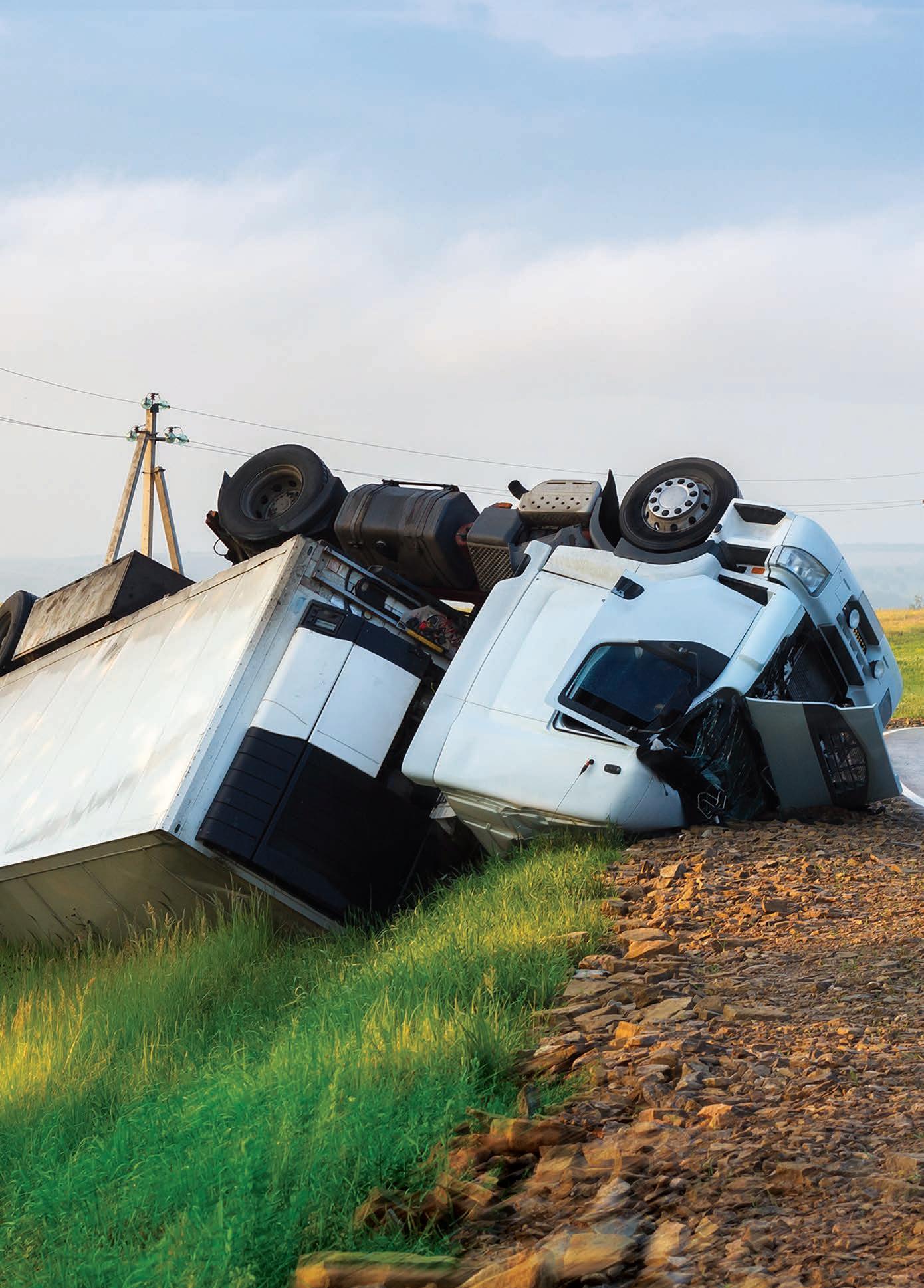
The Isuzu ELF EV is the culmination of intense research and development by Isuzu in Japan according to IAL Chief Operating Officer and Director, Andrew Harbison.

“What’s exciting about the announcement today is that the products revealed represent both the immediate and long-term prospects for our current and future commercial vehicle customers here in Australia,” he said.
“In its first iteration, this battery electric Isuzu truck is targeted at the built-up environment, fulfilling lastmile distribution duties. It will have an immediate and obvious impact in reducing urban transport emissions and contributing to greater quality of life through reduced noise and safety features protecting both the operator
PRIME NEWS PRIME NEWS 28 april 2023
Isuzu’s next gen range.
FATIGUE CAN BE FATAL
Did you know over 60% of Australian truck drivers experience fatigue while working and 1 in 10 fall asleep at the wheel?

Stay awake with Guardian; real-time driver fatigue and distraction technology, scientifically proven to reduce fatigue-related events by over 90%.
guardian.seeingmachines.com/anz
Statistics sourced from Australia’s 3-year Driving Health study
(drivinghealth.net)
truckstop chain. The acquisition, which is subject to regulatory and TravelCenters of America shareholder approval, will be for USD$1.3 billion in cash or $86 per share. TA’s strategically-located network of highway sites complements BP’s existing predominantly off-highway convenience and mobility business, enabling TA and BP to offer fleets a seamless nationwide service.
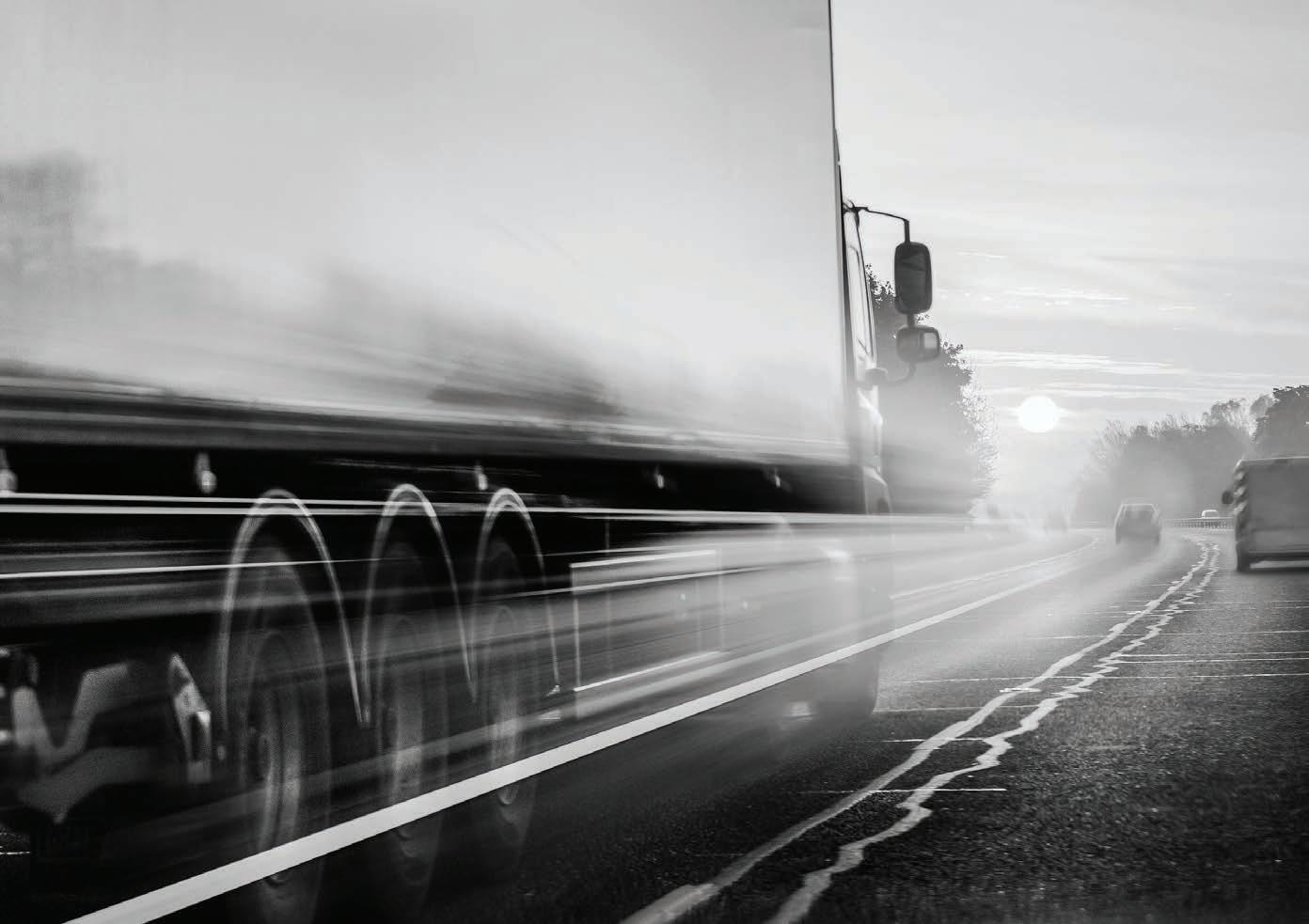

In a statement BP said the acquisition would enable its global scale and reach to bring advantages in fuel and biofuel supply. BP anticipates it will be able to provide greater options to expand and develop new mobility offers including electric vehicle (EV) charging, biofuels, renewable natural gas (RNG) and later hydrogen, both for passenger vehicles and fleets.
“This is BP’s strategy in action. We are doing exactly what we said we would, leaning into our transition growth engines,” said BP CEO Bernard Looney. “This deal will grow our convenience and mobility footprint across the US and grow earnings with attractive returns. Over time, it will allow us to advance
hydrogen, we can help our customers decarbonise their fleets. It’s a compelling combination.”
Convenience is one of BP’s five strategic transition growth engines in which it aims to significantly grow investment through this decade. By 2030, BP aims for around half its annual investment to go into these transition growth engines. Cumulatively that works out as an estimated $55-65 billion invested in convenience, bioenergy and EV charging between 2023-2030.
In January TravelCenters of America announced it had come to an agreement with Electrify America to offer electric vehicle charging at select TA/Petro locations with the first stations planned to be deployed in 2023. Electrify America is regarded as the largest open direct current fast-charging network in the US TA’s goal had been to install approximately 1,000 individual chargers at 200 locations along major highways over five years. The entire process of designing and developing the charging stations will be managed by Electrify
The BP acquisition is expected to bring around 280 TravelCenters of America sites, spanning 44 US states nationwide, into the BP portfolio. These sites, which average around 25 acres, offer a full range of facilities for vehicles and fleet trucks, including more than 600 fullservice and quick service restaurants, as well as truck maintenance and repair services.
Around 70 per cent of TA’s total gross margin is generated by its convenience services business, almost double BP’s global convenience gross margin.
“Subject to approvals, we look forward to welcoming the TA team to BP,” said Dave Lawler, Chairman and President of BP America. “TA’s amazing nationwide network of on-highway locations combined with BP’s more than 8,000 offhighway locations have the potential to offer travellers and professional drivers a seamless experience for decades to come.”
BP had announced the week prior its plans to invest USD$1 billion in EV charging across the US by 2030.
30 april 2023
GLOBAL NEWS
Trucks refuel at a TravelCenter in Missouri.
> DB Schenker to integrate MAN eTrucks next year
International logistics company DB Schenker and the commercial vehicle manufacturer MAN Truck & Bus have signed an agreement to integrate the new MAN eTruck. The company plans to add 100 new MAN eTrucks to its fleet by 2026. The first vehicles are to be handed over in the first half of 2024. By then the first MAN eTrucks will have likely been produced in a small series on the production line at the company’s headquarters in Munich. With the signing of the agreement, DB Schenker will be the first pilot customer for the first MAN eTrucks off the production line.
DB Schenker has indicated a desire to gain practical experience with the product as early as possible. This also includes setting up its own charging infrastructure, intelligent route planning and other digital services from MAN Digital Solutions such as

eManager, ServiceCare and MAN Driver App. MAN Transport Solutions will consult on route analysis, charging strategy, charging infrastructure planning and energy demand optimisation.
“We are very pleased to have our first customer for the new eTruck,” said Alexander Vlaskamp, CEO of MAN Truck & Bus. “The demand in the market for this fully electric vehicle is already enormous. The topic is now really picking up speed, also because more and more of our customers are setting themselves extremely ambitious decarbonisation targets. This has a direct impact on the logistics chains. However, we will only be able to achieve a sustainable mobility turnaround in heavy goods transport with the appropriate political support. This concerns, among other things, the rapid development of
the charging infrastructure and also the further design of the funding framework for the acquisition of electric trucks.”
DB Schenker is looking to build up practical experience with e-trucks as early as possible according to Cyrille Bonjean, Head of Land Transport at DB Schenker Europe.
“In this way, we can quickly create an offer for the economy to make supply chains more climate-friendly,” he said. “That’s why it was important for us to get the first MAN eTrucks. This brings us another step closer to our goal of being net zero on the road in land transport by 2040.”
The production of the future eTrucks has been prepared at MAN since 2021 in the MAN eMobility Center, as conventional diesel trucks and electric trucks will run off one assembly line during the ramp-up of electromobility.
Learn more at www.vworkapp.com •Maximised driver and fleet efficiency •Route Optimization to save time & reduce costs •Integrable with other business tools •Automated customer notifications •Electronic proof of delivery •Real-time data & reporting •Full transparency of all jobs 5,000 active users Over 400,000 jobs dispatched each month Customers in 10 countries Cloud-based job scheduling and dispatch software for transportation businesses
Managing Director of Nissan Australia. He started his role as the Vice President of Brand & Franchise Development for Hino Australia in early 2022.
MANAGING INDUSTRY TRANSITION
It has been an interesting business environment, and time, to join Hino. Although, it is my first role working directly in the truck industry, the fundamentals of success are the same as in other parts of the automotive business; customer relationships, good product and positive outcomes for our dealer partners.

Omnipresent has certainly been the supply and demand balance that is currently at play and the challenge that has created for us, and our dealers, in communicating delivery timelines.
I suspect the current pressures will remain through the remainder of 2023 and into 2024. Aside from that very short-term task, I’m enthusiastic about working with our customers on the transition required, and opportunity, to reduce CO2 within our industry. The fact is that the demand for road freight in Australia will continue to climb through the next decade — putting further pressure on the efficiency levels and CO2 performance. It is an area that I was at the forefront of as the CEO of Nissan during the beginnings of the passenger vehicle shift, and I can see the leading role that Hino will play in this transition on trucks.
Importantly, Hino has always been on the front foot when it comes to innovation around safety, reliability,
and quality. Now, we are uniquely positioned to step up to the plate on a greening of the truck fleet. This is especially so in the light-duty segment where most of the volume is. And it will be a transition that will take time, and to be honest, longer than many stakeholders care to admit. But we can start now and there are a range of ways to accelerate this transition. There is a real danger of being fixated on one solution. We can take steps now to make real gains on emission levels by driving down the age of our vehicle fleet and encourage operators to upgrade to newer, safer and more efficient trucks without the fears around range limitations and charging infrastructure, let alone the high purchase price of EVs. While the future may well be electric and/or hydrogen, it is exactly that, the future — currently, Australia doesn’t have sufficient infrastructure or policies in place to implement a wide-spread, significant transition to such vehicles. It will happen, and the OEMs are on the journey to enable this. At Hino, as part of the Toyota Group, we have access to the world’s largest R&D budget to help us develop solutions as part of this transition.
The question remains, what can we do now to reduce CO2 emissions within the truck fleet? As I have said, a younger fleet can help, as can the limited
32 april 2023
OEM MINDSET
Richard Emery
The pathway to a greener truck fleet in Australia is underway. In reality, the revolution so many have predicted is more likely to be an evolution.
adoption of EVs.
We believe strongly that a stepping-stone is our Hino 300 Series Hybrid Electric light-duty range — it is a strong solution for many fleets, and one that will reduce a fleet’s CO2 emissions from day one with no range limitation or recharging requirements.

Hino has led the way with low-emission trucks for over 15 years. Our Hybrid Electric range is driven by Toyota Group technology that is proven in nearly 20 million hybrid vehicles worldwide.
Compared to an equivalent diesel truck, a 300 Series Hybrid Electric significantly reduces customers’ fuel costs. Realworld trials comparing the proven Hino Hybrid Electric truck against a traditional diesel equivalent revealed a 22 per cent reduction in fuel use and CO2 emissions.
Greater savings are achievable depending on the application of the vehicle and how it is driven. We’ve also seen a reduction in yearly maintenance costs approaching 16 per cent.
The CO2 savings are substantial too: approximately 4 tonnes per year and 21 tonnes over a typical 5-year operational period.
We’ve certainly under-played our hand on this product to now, but that will change in 2023. You’ll see a concerted effort from Hino to present this truck as the viable solution for today.
In fact, it remains the only Hybrid Electric truck in the Australian market and its time has come. We are expanding our Hybrid Electric product range to include Built to Go products and have increased our production order
from Japan.
Higher fuel prices, increasing operational costs and a desire for a greener fleet have conspired favourably towards our Hybrid Electric and we are looking forward to working with our customers to show them a pathway to emission reductions and costs savings from day one, with a 300 Series Hybrid Electric vehicle on their fleet.
The next decade will be a fascinating and exciting period for our industry, with growth and innovation as we seek a greener fleet. The reality is, it will be an evolution rather than the revolution that many are predicting. I’m looking forward to this time immensely and know that at Hino, we’ll be playing an important and integral role in the industry’s future — as we always have.

SPONSORED BY
Hino 300 Series Hybrid Electric.
UNKNOWN INTO PARTS
As a relatively young business, Arrow Transport Logistics has blazed a trail that even the most elite start-ups would be at pains to replicate.

34 april 2023 COVER STORY
It was 2011. Craig Webster found himself at a crossroads. A serious decision weighed on him that was more than likely going to have a bearing on the rest of his life. He’d no sooner handed in his notice at legacy cargo transporter, Chalmers, where he’d been the general manager for nine years, before he started receiving calls from interested parties who pledged their support to whatever he had planned next. The problem for Craig was he had nothing planned next. It certainly wasn’t in port cartage and logistics. After sitting down for coffee with a large exporter, in which he outlined how they could best
resolve an issue he would have normally taken care of for them days earlier, he was soon posed the question. The exporter asked why not him.
“Given that I’d just told them I didn’t do that any longer I wondered if they’d misheard me,” he recalls. “Then they repeated the question, much slower. Just in case I had misheard them.”
That night he went home and punched some numbers into a calculator. Being familiar with the account he multiplied known volumes and set it down on an envelope to see how, with some objective distance from his mind, it looked on paper. It looked good. Then
in that very moment he was seized by fear. He gave it more thought. Starting his own business was one thing. Regretting not doing this, he soon found, was equally unnerving.
“It was that fear of not having a go that far outweighed my fear of failure,” he recalls. “To have a go and fail, I would rather that than never having a go. And in very basic terms that’s where the business was born.”
The name came about quickly. Craig knew he wanted something simple and easy for people to reference. Like the Batman logo. He kept thinking it was such a great brand. What he wanted was a single word, with no association with his family name. The idea was to build the brand, over the journey, so that when people saw the name it would instantly mean something. While on a drive through a Victorian beachside town approaching a sharp right turn Craig and his wife, Nicole, passed a cluster of road signs including an unmissable yellow and black arrow. She put forward arrow, as a possible name for the future company. It immediately stuck.
Arrow Transport Logistics & Quarantine Services, as the name suggests, provides a full offering in container cartage, warehousing, quarantine and biosecurity inspections.
The fleet operates nearly 40 PBSapproved vehicles with 95 prime movers and over 400 trailers. As a major Daimler Truck customer, it runs all three vehicles in the stable relying primarily on the Mercedes-Benz Actros, supported by Fuso Shoguns and Freightliner Cascadias, both of which are more recent additions. Expansion into

primemovermag.com.au 35
Arrow Transport Logistics runs the latest vehicles in the Daimler Truck range.
Brisbane at the height of the COVID ordeal, when container movements were at a peak, warranted an injection of new trucks. Arrow had initially placed an order for 84 Mercedes-Benz Actros units to cover the additional demand. But with componentry shortages playing havoc with supply chains and Arrow moving into the Perth and Adelaide markets, they couldn’t wait. Daimler
Truck found around 20 of the Fuso and Freightliner units in addition to five refurbished Actros prime movers or ‘rebirths’ that had been traded back in and sold for a fraction of the price as an interim measure until stock
was replenished.

“The performance of these rebirths has been excellent,” says Craig. “The drivers, transport managers and fleet manager could not be happier with them.”
The Shoguns have been the surprise packet. Driver feedback has been unanimously positive, particularly in the correct application, which turns out is sideloader work on the port. A shorter wheelbase for turning in the restricted spaces and the need for enhanced visibility that the Shogun ergonomic cab view also anticipates, have proven popular in Brisbane and Melbourne where these vehicles are now active.
“As an around town, drop trailer sideloader workhorse the guys are saying they’re great,” says Craig. “The drivers weren’t given much choice, and very quickly, whatever the initial preconceptions, have accepted them. The feedback has been overwhelmingly positive in the right application.”
On the heavier applications the Actros is the preferred prime mover and is assigned A-doubles both near the wharf and interstate. In 2014, Arrow was the first carrier to operate A-doubles outside the port precinct in Melbourne, having been approved to run them to Leongatha, 137 kilometres away in
36 april 2023
Craig Webster.
country Victoria.
“That was the start of our institution of PBS gear,” recalls Craig. “Those two units continue to do that very run today.” A-doubles, for Arrow, now trek far and wide including on linehaul duties between Melbourne and Sydney, and another route Sydney to Brisbane.
“If rail goes down or there’s shipping issues, people need stock urgently,” says Craig. “We’re forever running A-doubles between those states.”
As a high engine hour, low kilometre carrier, Arrow relies on its buying power when it comes to measuring fuel. Every yard has its own fuelling station.
“We just try and buy our fuel in bulk and buy at the right price,” he says.
“They move it around from a supplier perspective.”
Around 2017 Craig saw a requirement to move interstate. Seeing what was happening in the market made it imperative. Freight forwarders were buying out the competition. Importers were also consolidating by acquiring other importers.
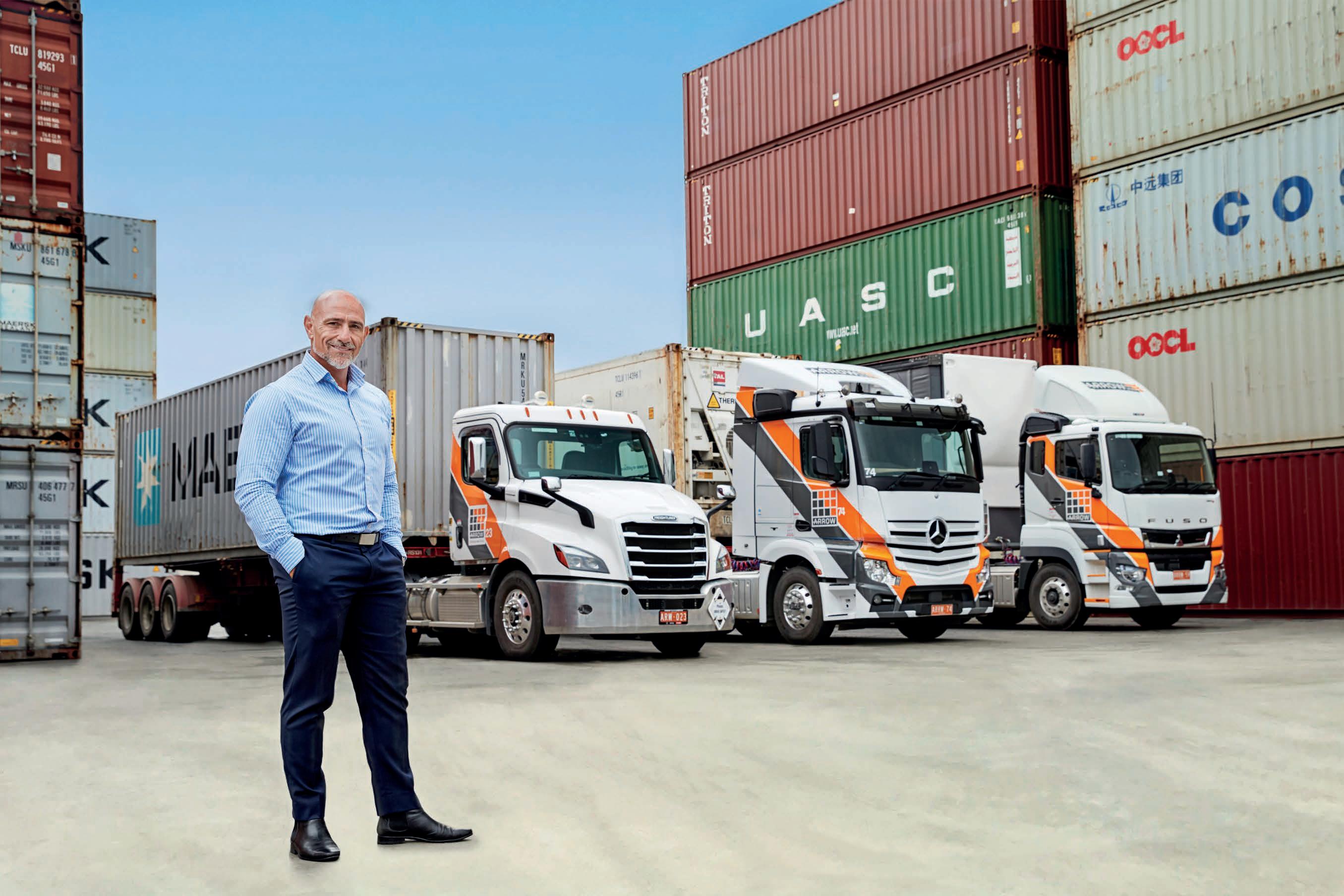
“We could service customers in Melbourne as hard as possible, work diligently on relationships but all of a sudden that relationship at a local level got lost because decisions were
being made at a national level looking for a national solution” recalls Craig. “It became evident we needed to start expanding our footprint.”
With Qube and ACFS the only true national carriers in the segment at this point, there was demand in the market for an alternative. Craig was determined to make it Arrow. Sydney, a tough market to break into, was the first move. Here they acquired Sydney Sideloaders, whose owner Chris Divas, “a bloody superstar” in Craig’s words, still works for Arrow today as the NSW State Manager. A new 55,000m2 site in Chullora, adjacent to
primemovermag.com.au 37
“As an around town, drop trailer sideloader workhorse the guys are saying they’re great,” says Craig. “The drivers weren’t given much choice, and very quickly, whatever the initial preconceptions, have accepted them. The feedback has been overwhelmingly positive in the right application.”
Craig Webster
Arrow Transport & Logistics Managing Director
of Sydney.
Another new facility is also underway at the Port of Brisbane, where Arrow is already the fourth largest carrier. Completion is expected to happen midyear.
“Our growth up there has been significant,” says Craig. “The new facility on island is going to provide the market with every service our industry requires.” Brisbane, as the host of the 2032 Olympics will likely remain a key growth hub for the business. An event of such magnitude entails various projects like stadiums, housing and roads, all of which will require product entering through the port.
“On top of our core daily volume in Brisbane there will be further growth to contemplate on the back of the games,” says Crag. “This will all start before we
Melbourne and Sydney and started using its existing network of customers. Craig had employed a couple of experienced locals, who worked for him previously at Chalmers, while permanently relocating some high performing staff from Melbourne. The results now speak for themselves.
“The team has gone gangbusters up there,” says Craig. “They do a consistently amazing job.”
Having secured several significant national accounts, Arrow had, by August last year, entered Perth. Before the end of 2022 it had an office in Adelaide. Now it controls its own destiny nationwide by being able to service its own client base on the east coast from those new markets.
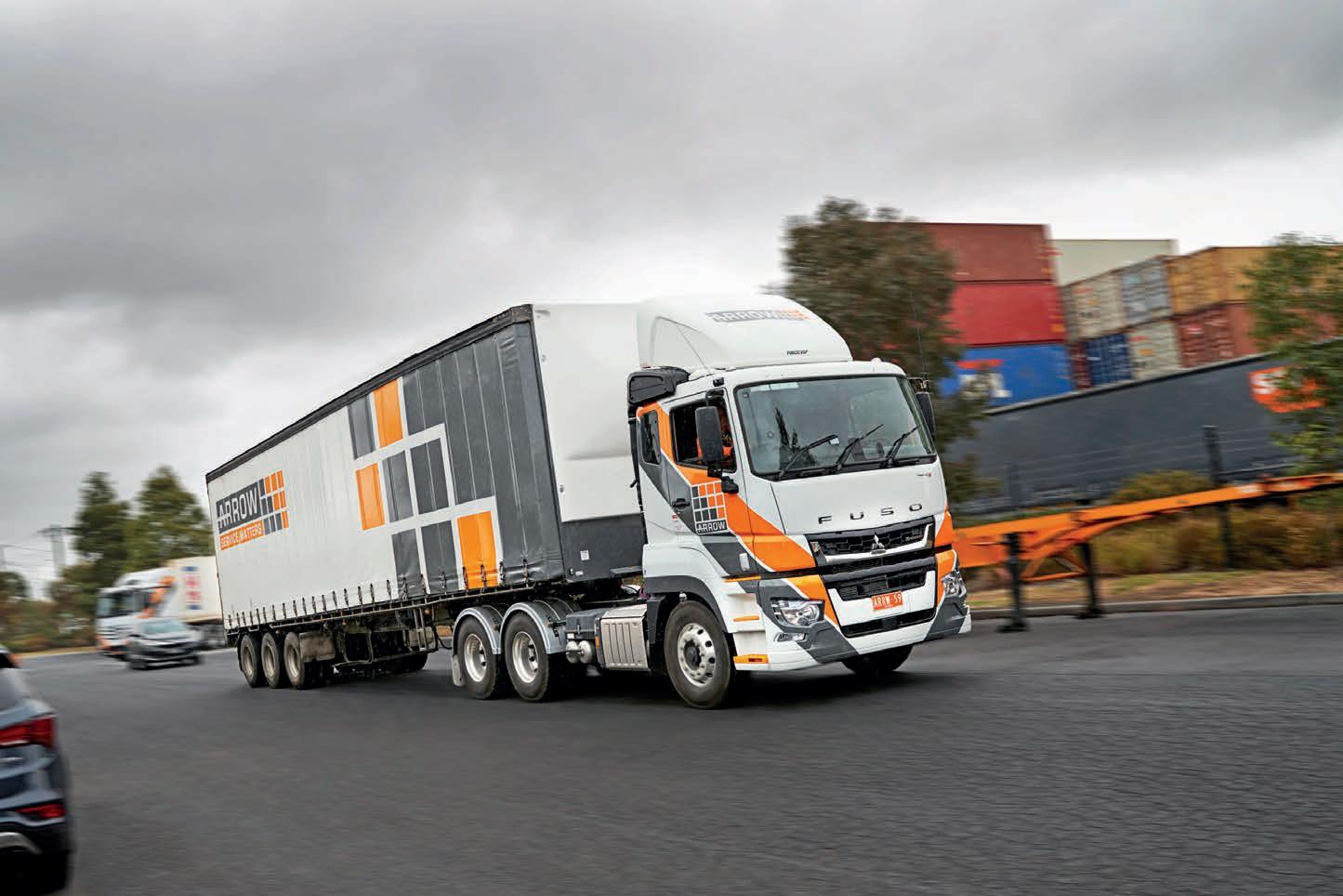
Nevertheless, challenges abound. Dwell times of containers have snowballed.
warehouses at capacity, the required market rate for container storage has nearly doubled in the last two years. That’s been driven mostly by the containers of importers sitting in a yard for too long according to Craig, who says the issues are threefold in their repurcussion.
“Warehouses remain full following an extreme backlog over COVID when record volumes of containers were arriving at port and importers were struggling to find the labour required to unpack” he says. “Instead of unpacking ten a day, sites were unpacking five a day. When there is labour available, a decision is made to use labour for unpacks or processing outbound orders. In addition to labour, we now find importers are facing a never-ending pallet shortage.”
38 april 2023 COVER STORY
Fuso Shogun in Melbourne.
Through its internal operating system, Arrow provides its customers with monthly reporting on what their average dwell time of container in-yard or at-site is. Supply chain managers can respond accordingly. Instead of wasting time scrutinising the shipping department or the transporter they can zero in on the warehouse to find the root cause of the blow out.

“It’s one of many measurement tools through AOS that can fast-track our customers as to what their pain points may have been,” explains Craig. “That way they can do something about it, reducing their cost and improving service to their customers.”
Over the last two decades Craig has kept a mental book of the shortcomings of wharf-cartage operational systems available and in use. In his mind he created a picture of what the ultimate systems capability and functionality
COVID, the team at Arrow bit the bullet and employed a CTO and in-house developers to build its very own system, now known as AOS.
“Not only is there the transport integrant in port logistics but we need to interface with terminals, empty parks, quarantine and customs,” says Craig. “You need to gather information from many sources to make the right decisions on the planning of loads factoring varied customer requirements.”
Always developing, testing and releasing new features, Arrow now runs AOS across all states. Its customers which include freight forwarders, direct importers and exporters, and DC managers, have access to a live dashboard with key metrics such as demurrage alert, delayed deliveries with updated ETAs using live data from Google maps, containers available requiring customers clearance or EDOs, down to a basic dashboard item showing
what his staff see, the customer also sees. “There is no-where to hide on our performance,” he says. “We’ve also built it to give us visibility of what we need which includes, not just the whereabouts of a truck but details on where containers are dropped and how long containers have been at site.” Should a container be marked emptied, it will change colour codes on the AOS display. Staff are then made aware that a particular container is prioritised over another one.
AOS was built, unlike many other transport operating systems, with an Application Protocol Interface.
“It means we can do true two-way communication with any other system,” says Craig. “The investment in AOS is providing our customers with solutions. Each time an importer/exporter or forwarder sees the system they notice it addresses immediate pain-points within
Three of the 95-strong prime mover fleet Arrow operates nationwide.

Truck mounted cranes are a specialised sector of the transport industry which continues to grow due to their flexibility for applications such as transporting and lifting roof trusses into position at building sites and moving heavy industrial machinery. With decades of experience Wollongong Crane Trucks (WCT) has built a portfolio of around 1,200 customers, mainly in the Illawarra and NSW South Coast regions, and specialises in resolving problems associated with moving awkward loads to and from difficult-to-access locations with precise positioning.
As land values rise, residential and industrial subdivisions are getting smaller, resulting in tighter access for equipment such as mobile cranes. In order to use a mobile crane to do the lifting work, factors such as road closures and traffic controls add extra layers of complication and significant cost. Crane trucks are generally more compact and can operate from footpaths and nature strips or can negotiate a property’s driveway to gain better access.
Darren Mortimer followed his father Jimmy into the crane truck industry and eight years ago Darren’s daughter Orlane

changed her mind about joining the police force and came to work for the family company and gained her Certificate II in Business Administration and then went on to achieve her Diploma. While studying, she also worked in the office and went out with Darren a few times each week to look at different jobs and scope out the most appropriate way to perform them.
“As we were getting busier, I started learning more about the regulations associated with lifting heavy items,” says Orlane who has progressively assumed a larger role in the overall management of the WCT operation. “She’s served her time and she took over the phone from me in late 2021,” says Darren. “It’s a bit unusual having a female in a male dominated industry such as this, and Orlane can answer any question relating to what we do. Very seldom does she need to come to me for advice and our customers love how she gets involved and gets things done.”
A positive economic effect of the COVID pandemic has been the increasing number of homeowners installing backyard pools and spas. The pre-Christmas rush in December 2022 involved a total of approximately 50 spas, with two of the
crane trucks delivering a combined 16 spas in just one day.
“With pools and spas, we’ll do a site inspection to determine the reach required,” explains Darren. “We find we can do most of those jobs with our crane trucks and if it’s out of our league we’ll refer them onto a mobile crane company.”
In such circumstances WCT still often provides the transport function with a pick-up from the spa retailer’s warehouse followed by a delivery to the customer’s property. Orlane has her own six tonnetruck. She often uses it to pick up a spa from the warehouse and deliver it to site to coincide with the mobile crane being set up.
The pool and spa side of the business provides consistent work and many jobs can be quoted at a fixed price which, if compared with contracting a mobile crane, is far more economical for the client.
Wollongong Crane Trucks are often called in to solve access problems involving the delivery of furniture items such as lounges and refrigerators via windows or balconies in high rise residential buildings due to the purchasers not taking into account the dimensions which can be accommodated
primemovermag.com.au 41
Along with the straightforward jobs, the capability to resolve seemingly impossible challenges is an important offering from Wollongong Crane Trucks.
lathes and positioning them accurately within a building structure. Electrical substation equipment is another busy sector for WCT along with the occasional boat salvage exercise. An unusual yet essential service WCT is sometimes called upon to provide is the removal of dead horses.

“Not our favourite type of job but if a horse passes away in a paddock it’s up to the owner to get rid of it, therefore we pick it up and take it away to be disposed of,” says Orlane.
The WCT fleet consists of a number of brands, each chosen to best suit its role in the diverse range of applications the company performs. Currently there are eight trucks with two new additional units on order. Isuzu is the dominant brand, along with UD. Most have a tray length between 7.2 and 7.5 metres with a couple of the flat tops fitted with 9.5 metre decks. The 8x4 Volvo FM prime mover rated at 500hp is the most recent addition and usually tows the drop deck trailer. A new Fuso rigid is currently on order as is a Volvo 10x4 five axle rigid which is to be fitted with a ‘big’ crane capable of a

42 april 2023 FLEET FOCUS
WE’RE WITH YOU FOR THE LONG HAUL.
BRISBANE TRUCK SHOW STAND 305
SEEUS AT THE MAY 18TH - 21ST2023
With heavy duty knowledge, professional service and a leading range, NAPA
Auto Parts
is far more than just automotive.
From our wide range of heavy duty Auto Electrical, OE Replacement Alternators and Starter Motors, Air Conditioning, Lubrication, Service Parts and Braking to smarter technologies and efficiencies, we’re keeping you ahead of the curve. Our branches are located on the National Land Transport Network. We are working with you to have the parts where you need them, when you need them. We are as committed to your business as you are.

Visit napaparts.com.au/locations for your nearest branch.
Scania trucks and innovative PBS combinations play a major part in the Tasmanian operations of leading metal recycler Recycal.
EVERGR
Based in Melbourne, Recycal is a family owned business headed by Doug Rowe and embraces the firm commitment to provide the best metals recycling service for its customers across Australia. Recycal has an inventory of more than 10,000 metal collection bins with capacities ranging from one cubic metre to 42 cubic metres. Far removed from the ‘junk yards’ of the past Recycal operates from modern state of the art facilities and the trucks
employed reflect the professionalism of the overall operation. Recycal operates a diverse fleet of over 75 vehicles ranging from small trucks with tailgate loaders to multi-trailer combinations including Tasmania’s first 35-metre Type 1 Road Train. A Scania R 620 V8 with 3,000 Nm of torque is used for hauling the combination on the Hobart to Launceston route between Recycal’s southern depot at Brighton, on Hobart’s northern outskirts and Launceston where Recycal operates a shredder as
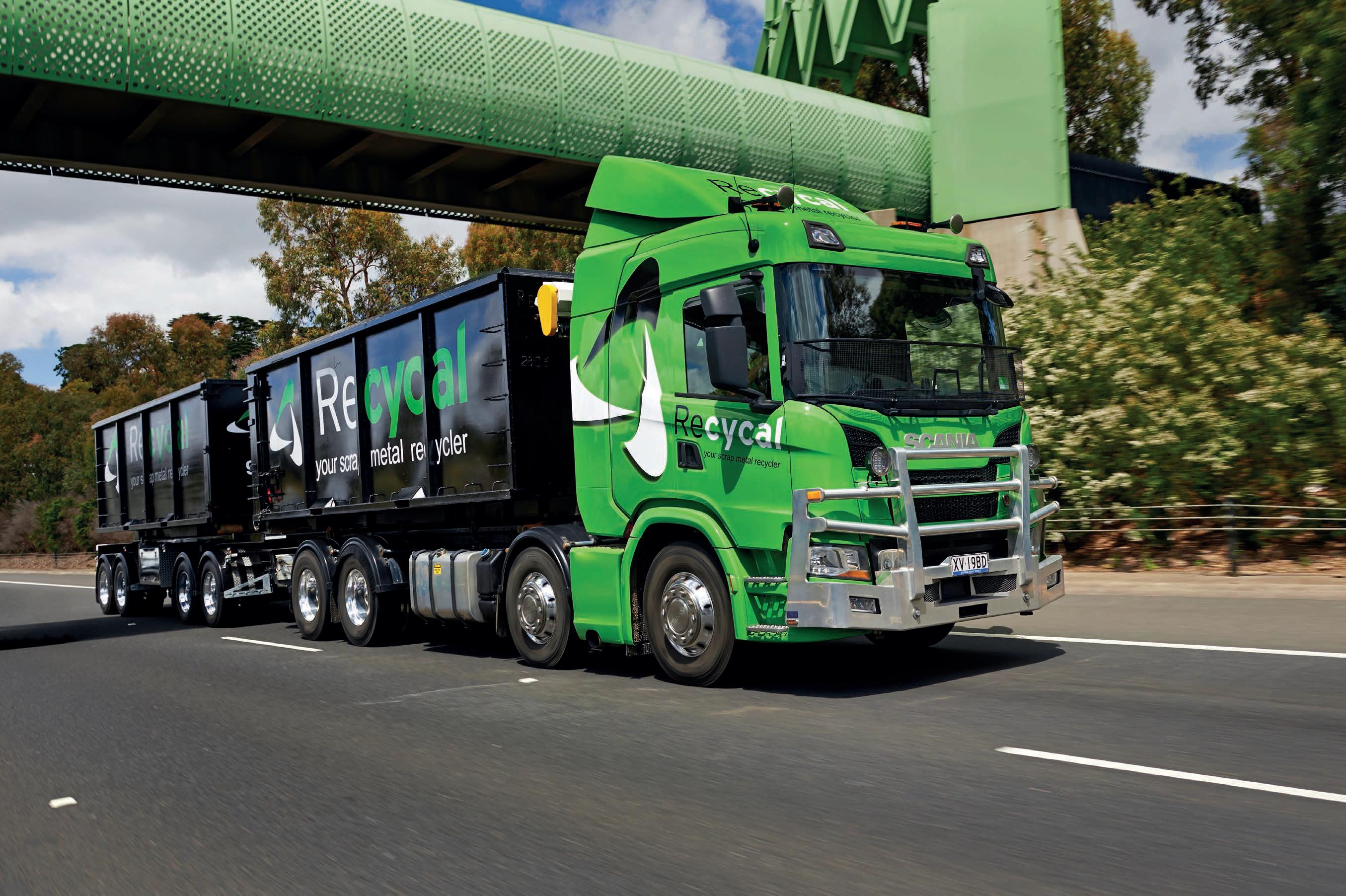
44 april 2023 FLEET FOCUS
PBS-approved Scania R 620 V8.
EEN MACHINES
part of its recycling operations. Recycal has embraced a strategic relationship with 190-year old Launceston business Castings Tasmania, which has evolved from its beginnings in 1833 as Johns Perry Castings. The foundry became part of the Recycal Group in 2019.
Recycal is committed to supplying the quality steels required by the foundry and utilises cutting edge technologies such as portable x-ray guns to identify and sort scrap metal into various grades to match the requirements of
the foundry.
Tefco trailers, manufactured using Hardox 450 steel, form the trailing components of the roadtrain which has a gross vehicle mass rating of 92 tonnes. Prior to commencing the operation of the efficient truck and trailer combination, Recycal went through a detailed 12 month approval process involving the Tasmanian Department of State Growth, the National Heavy Vehicle Regulator and every town and province on the route. The combination
is currently restricted to 85 tonnes gross mass while several bridge upgrades are being carried out. Among the many benefits of this combination is the reduction of truck movements which leads to significant reductions in fuel usage and exhaust emissions.
At the current limit of 85 tonnes gross the 16-litre V8 is returning 1.25 km per litre, using 310 litres of diesel per round trip. Recycal has on-site fuelling facilities at all of its sites so there is no need for other than standard sized truck-

primemovermag.com.au 45
mounted fuel tanks.
Kym Lawrence is the regular driver of the 35-metre-long combination. He is the recipient of the NTI Professional Driver of the Year Award — an award that recognises his exceptional driving performance, as rated by the Scania onboard Driver Support System, as well as being nominated by his colleagues for being a safe and efficient driver.

“I was surprised and honoured to be presented with the award,” Kym says. “It is nice to be recognised for the job you do, day-in and day-out.”
Another Scania R 620 is utilised to haul a different combination, a 30-metre A-double which takes two 30-tonne containers to the wharf at Bell Bay every day. The containers carry fist-sized pieces of shredded metal and are loaded using a radial stacker incorporating an automated weight measurement system which shuts off loading and moves on to the next container when it reaches 27.5 tonnes. A second weight check is carried out once the doors on each container are shut and the Kalmar reach stacker is used, again, to check the weights using a pad scale. When the containers are loaded onto the skel trailers they are checked a third time using one of the three on-site multi deck axle weighing weighbridges.
main purposes.
“We have to do a State Road declaration before they leave our yard,” says Rob Massey who is Recycal’s Tasmanian Operations Manager based at the company’s 15-acre purpose built recycling facility located in Rocherlea near Launceston.
“We also buy and sell material based on the weights,” he explains. “It’s no benefit to us overweighing because we’re not going to get paid any more than what we legally carry. So we get the three weight checks in the yard and then we have air bag scales on the trailers as well.”
Recycal operates a number of Scania hook bin trucks in Tasmania. These are fitted with full air suspension including for the steer axles. Recently, Recycal has ordered an 8x4 twin steer, bogie drive rigid from Scania which will be powered by the top of the range 770 horsepower V8 and will be coupled to a six-axle dog trailer.

In the meantime, there is another 620 horsepower V8 hook truck towing a sixaxle dog trailer which is PBS-approved to 72 tonnes GVM and accommodates three 6.5-metre hook bins.
“It looks like a B-double on the road but it’s actually a truck and dog,” says Rob.
“At 26 metres long it has the same pivot points as a B-double, but more wheels because of the twin steer setup.” Limited to 90kph the innovative combinations might be overtaken on the highways by many other vehicles but that doesn’t concern Rob or his drivers.
“With all this new equipment you’ve got to take a deep breath, slow down and get rid of the AC/DC from the sound system and put some classic rock on and just cruise,” says Rob. “There’s no need to thrash through gears or operate roaring engine brakes.”
The remarkable Scania Retarders prove their worth on long descents such as Hobart’s Southern Outlet highway.
“You just keep clicking that thing down and at stage five it drops a gear,” says Rob. “As the Scania driver trainers say: you’re driving via your hands and
46 april 2023 FLEET FOCUS
Kim Lawrence.
Recycal buys and sells materials based on weights..
fingers nowadays.”
Recycal has been a regular purchaser of Scania trucks for some years with more than 30 of the Swedish brand now in the combined mainland and Tasmanian fleets. The trucks are on Scania repair and maintenance contracts and Rob is comfortable with handing those responsibilities over for Scania’s local

authorised service agents to determine the servicing schedules.
“We’ve never had any issues with drive trains and they email me every week with a running tally on what’s due so we can plan around them being serviced,” says Rob. “These trucks have been faultless to be honest, and their drivetrains are bulletproof. We might have a rare airline
leak and that’s about all.”
Rob also receives a detailed report from Scania every week on each truck’s fuel consumption and most of the drivers get enthusiastically competitive in trying to maximise their efficiencies. Achieving good driver scores on a consistent basis using the Scania driver support system also leads to reduced costs per kilometre on the repair and maintenance contracts.
Recycal is recognised as a leading innovator in the management of scrap metals which has positive implications in fields such as sustainability and environmental care. Recycal’s development and adoption of innovative transport solutions using Scania trucks is a reflection of the organisation’s commitment to excellence.
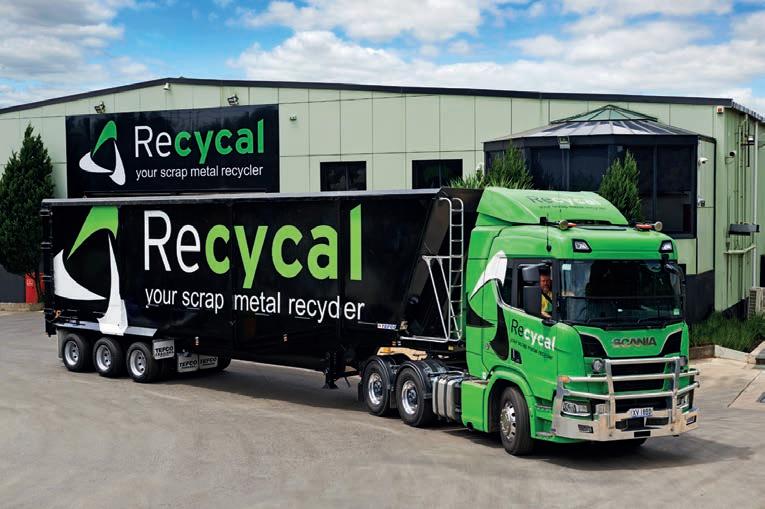
primemovermag.com.au 47
Most of Recycal’s drivers compete on best fuel consumption.
MILEST MAKING
Hazell Bros has turned to UD Trucks for new Quon 8x4 agitators that are primed for the major projects it undertakes statewide in Tasmania.
As far as infrastructure projects go, there is none bigger currently in Tasmania than the Bridgewater Bridge. The 1km long structure passing over the River Derwent in Hobart will involve hundreds of workers, dozens of heavy vehicles and millions of dollars — $786 million projected to date.
Regarded as the largest ever investment in a single transport infrastructure project in Tasmania’s history, the Bridgewater Bridge, funded by both Federal and Tasmanian Governments, is a once-in-a-generation project that has required significant strategic thinking

and planning.
The fact that the Hazell Bros’ concrete division has been entrusted as one of the key suppliers to the contract, is testament to the longstanding good reputation it holds in Tasmania. Founded in 1944 by brothers Donald and Rowley Hazell, primarily as a transport business operating in Southern Tasmania, Hazell Bros now operates quarries, concrete batch plants, a civil construction business, and an asset and industrial services division. It also operates a civil construction and plant hire business in Queensland, based out of Burleigh Heads on the Gold Coast and employs
over 100 people at Port Pirie in South Australia, working in materials handling at the smelter. The aspirational plans of the company to grow and diversify over the last eight decades have certainly born fruit.
“Our quarries are supplying to road projects all across the state,” says Mary Mickan, Business Improvement Manager. “We’ve got our business as-usual projects, our industrial markets area and some big projects taking place in Devonport.”
The business is partnering in a joint venture with Brady Marine on constructing the new marine facilities for Tasports in addition to working closely
48 april 2023 FLEET FOCUS
Concept of the new Bridgewater Bridge project.
ONES
with Tasmania Irrigation on the Don Irrigation project. Working with the main contractor, McConnell Dowell, Hazell Bros’ concrete division will be supplying and delivering the concrete.
On the Bridgwater project, it will provide trucks and materials up until March 2024 when the new bridge is scheduled for completion. The existing Bridgewater Bridge, first opened in 1946, must be raised for any vessel higher than 2.2 metres on an average tide. As this bridge has reached the end of its functional life, the risk of failures during operation of its lifting span have increased, particularly while the new bridge’s foundations are
being built close to it. If it fails to close properly it has the potential to impact traffic travelling on the National Highway between Hobart and Launceston.
Last year new trucks were scouted by Hazell Bros with this project looming and four new UD Quons have been purchased, making them the first of the brand not only for the company but

also, at least in the heavy vehicle category for the Japanese truckmaker, to enter the state.
As part of the civil construction arm, two new UD Quon 8x4s are now adding value with the first deployed to Hobart. The second is operating in Launceston where it will be joined by a UD Quon 6x4 pulling a superdog combination

primemovermag.com.au 49
The Kyokuto mixer.
The Quons are the first heavy vehicles for UD to land in Tasmania.
later in the year. Launceston is also where the trucks land before they are floated to Hobart for painting and fitting at the main workshop site, sometimes before being brought back. A third workshop is based in Burnie. An alignment with Webster Trucks through an existing Mack connection utilised for their tipper and dog applications, helped facilitate the order from UD. The 8x4 variant in the fleet has, historically, been associated with Kenworth, notwithstanding some sub-contractors. Hazell Bros Northern Tasmanian Concrete Business Manager, Christian Lawrence, sought to explore new avenues with the latest purchase to meet future contractual demands. Having a background as a mechanic in heavy vehicle workshops, made UD, for Christian, a strong choice to meet benchmarks such as rig stability, fuel usage and onboard safety systems.
“We’d done research on a few bits and pieces and as we happened to be looking at the UD Quon, some units were

Ordered in September last year, the vehicles were delivered by late December and in service for Hazell Bros the first work week of 2023. As a mechanic Christian already had some familiarity with the Volvo product, a platform that UD shares much architecture.
“Those safety aspects we saw as an advantage moving forward,” he says. “All in all, so far they’re going really great.”
The new Quon 8x4 fulfills leads of up to 100 kilometres in a day. On these journeys the Lane Departure Warning System and Blind Spot Information System are necessary advantages when running at 28-tonnes with a payload of up to 6.8 cubic metres of concrete depending on the type of mix. The business nominally is oriented to the Cesco mixer product. For the new Quon, Christian opted, instead, for a Kyokuto mixer unit imported from Japan. That has produced a lower centre of gravity of an estimated 170mm.
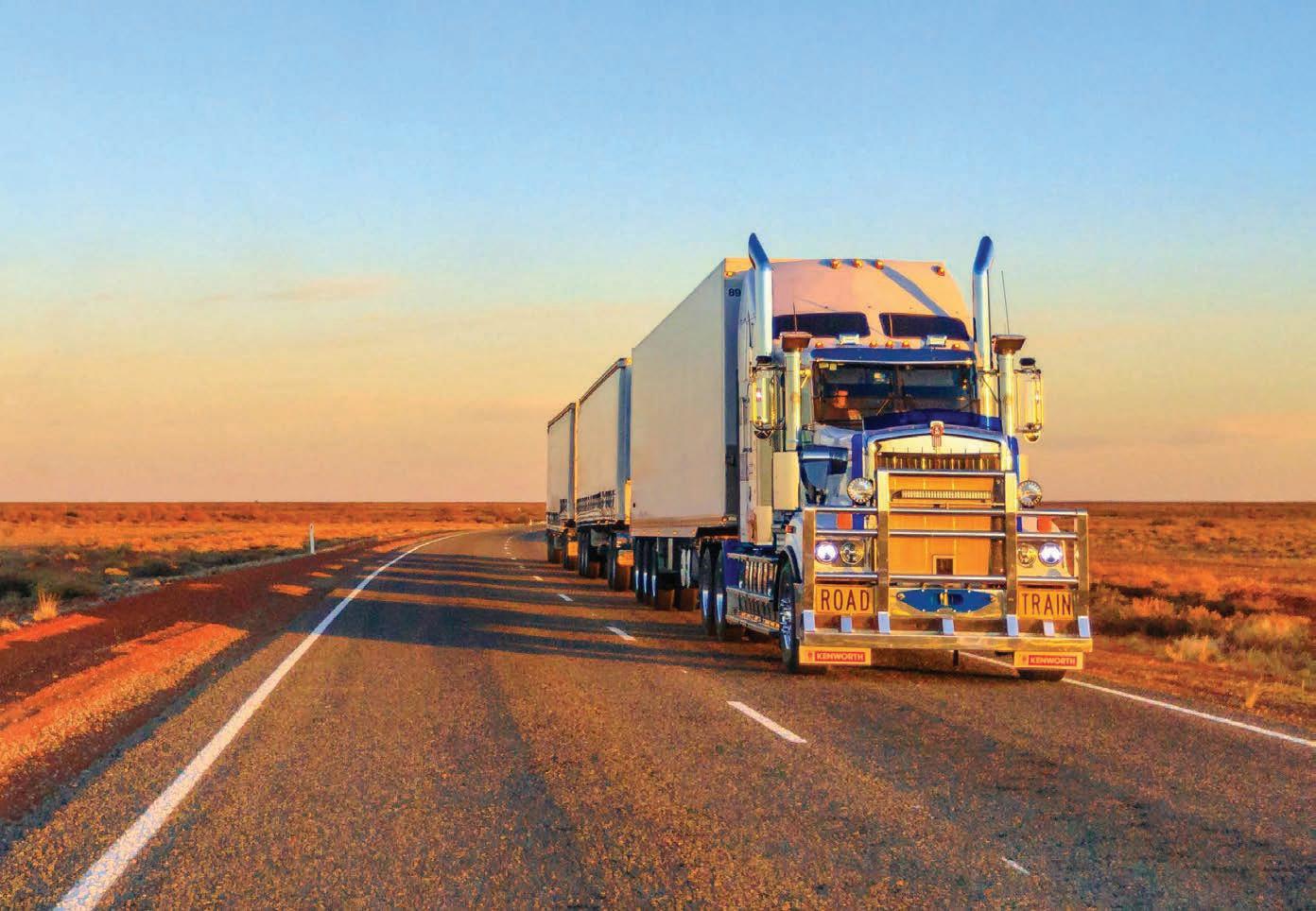

“Couple that with the obvious stability
a really stable truck,” he says. “That’s showing some real benefits for us at this stage.”
In the civil construction wing, the business runs around 70 agitator units. Those numbers include minis and contractors. The external work on the trucks is carried out at the Hazell Bros Hobart Workshop so that all the process, when it comes to auxiliary items and attachments, remain the same.
“Certainly, power-performance is good. One of the first comments from the driver made to my counterpart down south was the truck pulls really well, straight from the get-go,” says Christian. “When compared to an 8-speed manual paired with a 320-horsepower engine, they go well straight off the bat. That was pleasing to hear.”
The drivers have welcomed the multimedia unit in the Quon as it has helped deliver additional efficiencies.
“They’ve got all their maps and where they need to be on the screen,” says Christian.
FLEET FOCUS
New UD Quon 8x4.
“As someone who grew up around the trucking industry here in Australia, and is still close to it, I love what I do both here in Australia and overseas with the industry. I know just how important it is for truckies to have a voice in this huge mobile community that carries the nation 24/7. What Australian Truck Radio is building is a really great thing for the trucking industry. I very much look forward to contributing and supporting what they do at Australian Truck Radio, which I reckon will make a real difference to hard- working Aussie Truckies.”

 Jayne Denham Singer/Song Writer
Jayne Denham Singer/Song Writer






For advertising opportunities contact melissa.beutel@primecreative.com.au or call +61 422 103 119
YOUR NATIONAL STATION 24/7 Scan and LISTEN NOW Visit us on www.australiantruckradio.com.au
www.jaynedenham.com
PARAD
The entrance to the Marine Corps Officer Candidate School is adorned with a sign that reads, “Ductus Exemplo.” From Latin it translates to “Leadership by Example,” and this essentially underwrites the ethos of Easy Truck Rental. The opportunity to explore a post-diesel road transport future was enough to convince entrepreneur, Jon Hui, to recently get involved in the burgeoning truck rentals sector. As the Managing Director of Easy Truck Rentals, Jon is an advocate of what he calls consolidation disruption, wherein several businesses are consolidated into one using alternatives to internal combustion vehicular technology as the
point of difference.
Open for business in August 2022, the fledgling start-up raised capital through investment partners with a goal that the business eventually, within the next three years, moves to a green fleet model. The first four Hino Hybrid Electric 300 Series units of a much larger order with Sci Fleet Hino, were introduced into the fleet recently as part of this long-term goal.
“We play our part in driving the transition from diesel to hybrid-electric and then eventually to full EV,” explains Jon. “It’s our mission.”
The plan for the business is to have a large, mostly flexible fleet of hybrid and electric trucks, perhaps the largest in
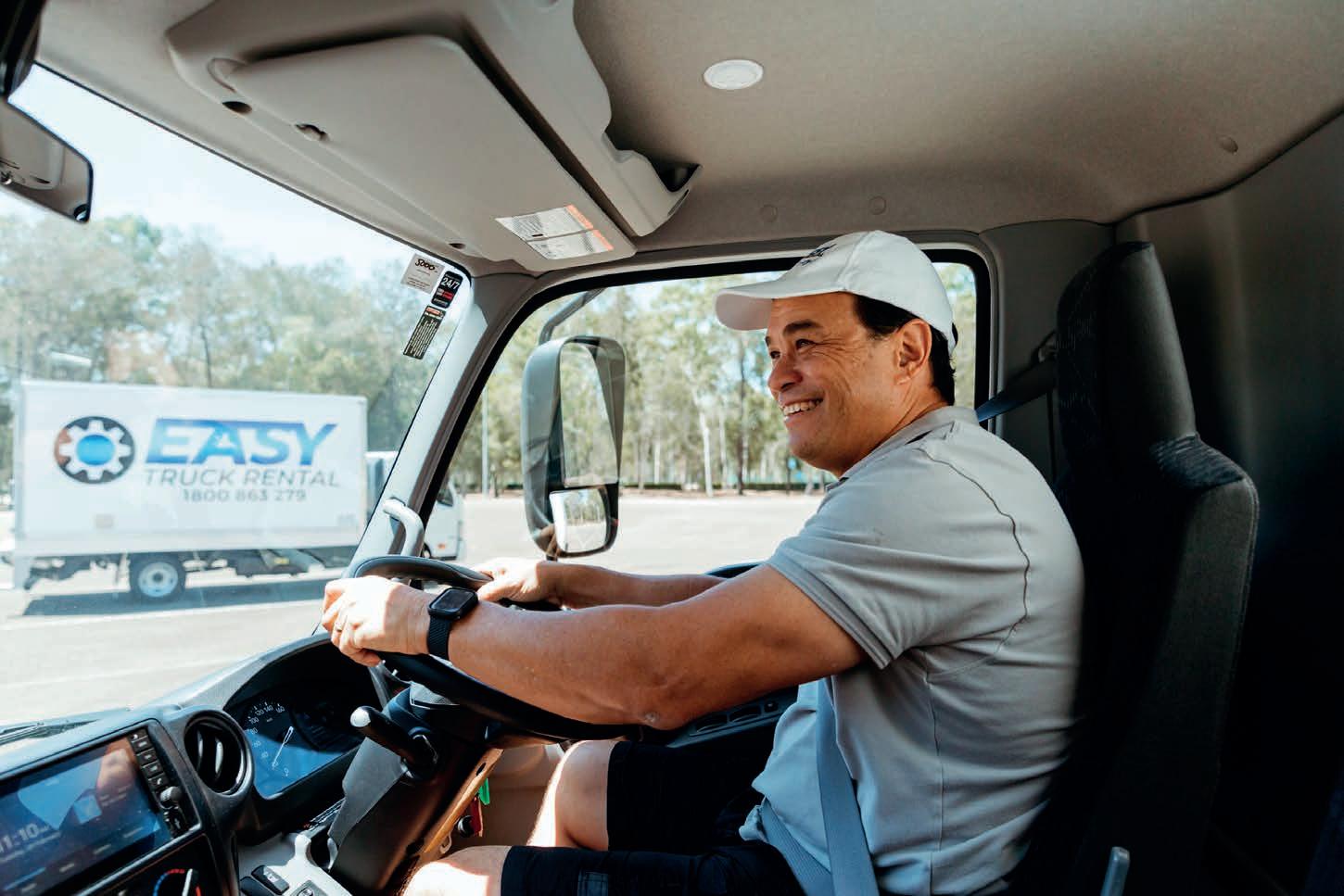
52 april 2023 TRUCK & TECH
The first delivery of Hino 300 Series Hybrid Electric trucks have been accepted by Brisbane-based Easy Truck Rental, a new player poised to be a market leader in emissions reduction.
Jon Hui takes a Hino 300 Series Hybrid Electric for a spin.
IGM SHIFT
Australia in good time. This, of course, will mean, having to scale the business up fast.
“In effect we will eventually introduce and begin to transition toward a tech business in the logistics and transport space. Trucks and vehicles we have on the fleet are just a means to that end,” Jon says. “We want to develop and enable platforms with a green focus.” At present, Hino offers the only hybrid electric-diesel truck in the local market. It was the first Japanese manufactured light-duty truck in Australia to meet Euro 6 exhaust emissions standards. The technology is given to the moment. Many improvements have been made to the parallel electric-diesel hybrid
driveline since it debuted in the local market. The result? Significant reductions in fuel consumption and efficiency gains that all flow to the allimportant bottom line. In terms of what is presented, Jon says that the Hino 300 Series Hybrid Electric and traditional diesel trucks look and drive the same, meaning there is no need for peripheral charges and other additional costs to implement the technology. This makes them familiar and easier to market to customers who might be looking to cut down on emissions and are still on the fence with Full EV commercial vehicles. To date, Jon has been active with roadshows and secured a couple of pilot programs with government bodies as
part of delivering proof of concept. As a conservative industry and a critical part of the overall supply chain, road transport is naturally resistant to disruptive change. This accounts for much of the hesitancy towards electric vehicles according to Jon. With this in mind, the Easy Truck team is investing to build a platform to drive the change to EV.

“Talking to OEMs they say that if potential customers trial the vehicles, there’s a good chance that they will add them to their fleet,” Jon says. “Few smaller to mid-size companies want to be the first to invest the Capex into EV commercial and find out that they went too early and have supply issues.

primemovermag.com.au 53
LCD Multi Information Display with battery charge gauge.
Especially when margins for last mile delivery can be thin.”
EV truck uptake will likely drive the changes through a B2B model. At least that’s the idea, in which the hybrid and electric truck option is introduced into fleets with key strategic relationships built over time. Through this mechanism it will become more common to have EV on fleet. It’s how the market starts to shift in a wholesale way according to Jon.
Progress is being made. Easy Truck Rentals has recently started proof of concept agreements with industry recruitment company, Dynamic Solutions Australia and national storage provider, Kennards Self Storage.

“The customer needs to go through a paradigm shift to adopt EV,” says Jon. “A hybrid electric is still a 20m3 Pantech. For now, they just see a standard truck with a battery and a fuel tank with a
hybrid electric driveline.”
Hybrid Electric trucks after all, go to fuel stations like a conventional ICE vehicle.
Jon believes there will be a tipping point soon whereupon take up of hybrid truck technology will accelerate not unlike what happened with hybrid cars.
“I don’t see a program rolling out 1,000 fast chargers everywhere for the trucks soon, a bit more take up and software compatibility is needed,” he says. “You can’t take an EV truck down to a car charging station and charge it like you can a Tesla.”
Charging infrastructure will come in time. The four Hino Hybrid 300 Series vehicles on the Easy Truck Rental fleet have provided Jon, who has driven them, with major learnings. His initial expectation, he admits, was that they would be more like a hybrid car.
“I realised that the electric component of the hybrid electric truck actually operates
as a supplementary power supply,” he says. “Essentially the engine is going all the time and the battery selectively sends supplementary electric power to the drive motor to minimise fuel use under acceleration.”
Electricity is collected during deceleration and stored in a nickel metal hydride battery, which is not dissimilar to the technology on 15 million Toyota hybrid vehicles in use worldwide. On the Hino 300 Series Hybrid Electric the power control unit manages the battery, inverter, engine control unit and DC-toDC converter. This was only redesigned three years back with an emphasis on weight saving, resulting in a notable loss of 28 kilograms. Despite reducing the battery size, it still retains its 6.5 Amp Hour (AH) rating.
For Jon, there was a whole education required around that. Another discovery he made is that the big savings and the
54 april 2023 TRUCK & TECH
Operations General Manager, Mark Dunton with Jon Hui.
efficiency gains are largely in stop-start, and metropolitan routes.
“If you’re driving from Brisbane to Melbourne the hybrid system doesn’t need to do a lot because the diesel engine is already in its most fuelefficient operating state,” says Jon. Around town, however, is where the hybrid really comes into its own. With the vast majority of 3.5-tonne and 4.5-tonne trucks being used for last mile delivery and DIY self-drive rentals, Jon is confident the Hino 300 Series Hybrid Electric is going to be successful in this segment. Hino’s own sales from last year attest to this. The Hino 300 Series Hybrid is its fastest growing model over that 12-month period.
“On short haul, with all the stopping and starting, moving up and down hills, the hybrid system recycles so much otherwise lost energy and puts that back into the driveline,” says Jon. “The regenerative technology is very efficient, and this operates as an inbuilt generator continually attempting to capture the kinetic energy of the moving vehicle and fill the battery back-up, for use on takeoff and during acceleration.”
Two of the main selling points, for Jon,
are a reduction in fuel consumption and subsequent reduction in exhaust emissions — Hino Australia trials have revealed up to 22 per cent reduction in fuel use and a similar reduction in CO2 emissions.
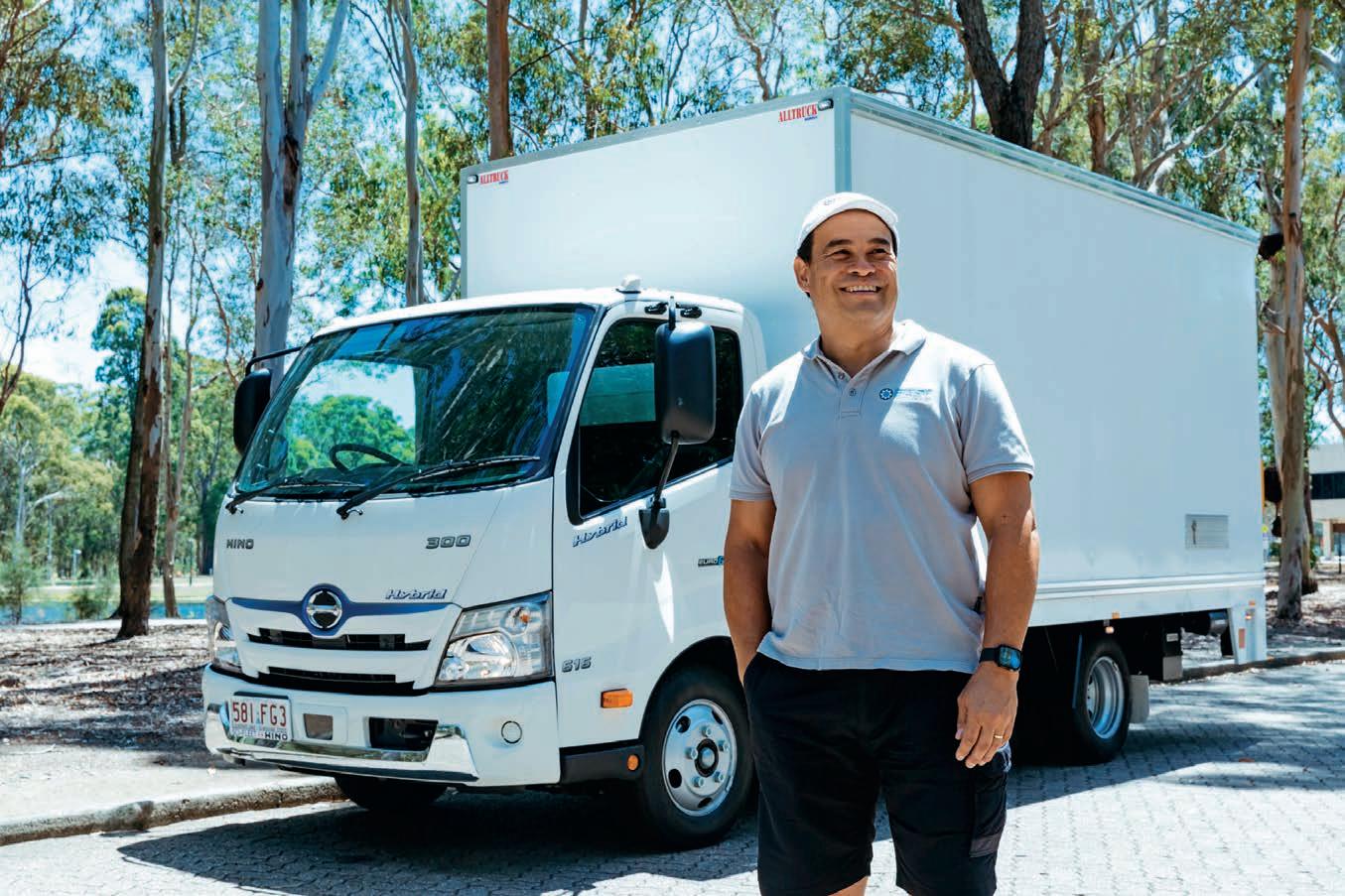
Easy Truck Rentals is soon to run a customer trial with a courier. It will encompass a 70-stop metro route over an eight-hour cycle.
“We’re testing the OEM claims at the
coal face” he says. “And so far, our tests show a hybrid truck does deliver notable
Because of its Euro 6 classification, hybrid is a logical extension for fleets chasing environmental governance metrics that can open doors for government contracts and to work with major corporations, given their requirements. Jon’s view on hybrid uptake in the retail short-term rental market has been softened somewhat, for now, as price remains a major driver of choice, particularly in that market.
“In time, Easy Truck Rental will be a national business with a well-earned reputation for having a respectable hybrid truck fleet and having got in early to drive the shift,” he says. Hybrid is also a soft landing to convert into EV. Drivers are free from the worry they might run out of battery mid-route. For fleet managers, renting a hybrid, Jon believes, offers an opportunity to ease into it.
“Get your drivers on side and sharpen your route planning,” he says. “Test for yourself the fuel efficiencies and see if you, too, get the benefits in reduced running costs.”

primemovermag.com.au 55
Jon checks his mirrors..
One of four Hino 300 Series Hybrid Electric vehicles now in the fleet.
Scania currently has three battery electric vehicles (BEVs) in Australia for local assessment.
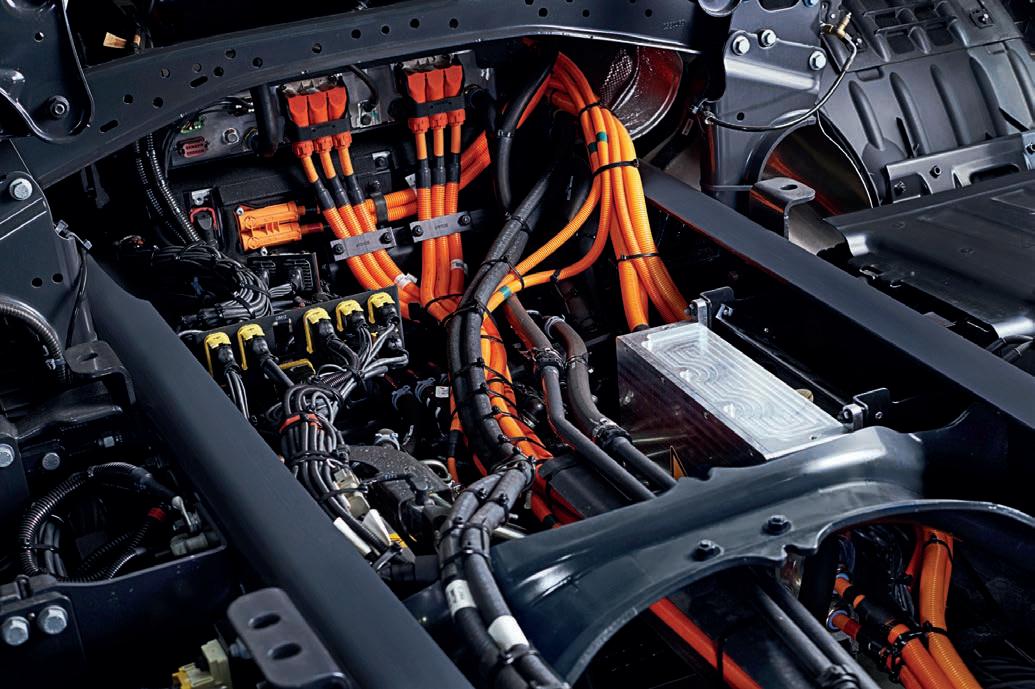
LARGE AND IN CHARGE

56 april 2023 TRUCK AND TECH
Scania has for many years stuck to the message that there is no silver bullet solution for the transport industry when addressing emissions reductions. Fossil-free fuels such as biomethane and biodiesel will play an important role for reaching the company’s environmental goals in parallel with electric vehicles. Scania has already imported several battery electric bus chassis, the first of which is being bodied by Bustech in Adelaide and will be trialled by the South Australian Department of Infrastructure and Transport within its route bus fleet.
Three Scania battery electric trucks have also been brought into the country, including two 6x2 units which are being trialled in the mining industry in Western Australia and have been equipped with Scania XT-style fittings at the front including steel bumpers and front under-run protection. The trucks are series production vehicles from Sweden, currently offered for general
sale in Europe in either 4x2 or 6x2 drive configurations. Similar to other forwardlooking manufacturers, Scania has seen a significant increase in interest in the concept of battery electric trucks, not only for last mile deliveries, but also for a wider range of applications. The purpose of this first batch of trucks is to determine where their abilities will be best employed in Australia. The shorter wheelbase 4x2 Scania currently in Australia is planned to be fitted with a distribution style body as soon as the currently overworked body builders can allocate the necessary physical and human resources to manufacture it. Rather than wait for that, we have taken the opportunity to have a brief test drive prior to the body being fitted. It has the benefit of providing ready access to the electrical architecture which would normally be hidden under a body. The electric Scania 25 P is based on the traditional P-series cab and chassis, with a mid-mounted permanent magnet electric motor drawing its energy from nine large
lithium-ion batteries with a total output of 300 kW/h. Recharging utilises a CCS type 2 plug-in connection with up to 130 kW / 200A DC charging. The battery packs are mounted outboard of the chassis on each side as well as under the cab in the area traditionally occupied by a conventional ICE engine and gearbox. Drive is to the rear wheels via a two- speed integrated automated gearbox.
The Scania 25 P can operate at a range of up to 250 kilometres, and the motor produces peak power of around 295 kW and 2200 Nm of torque, while continuous operation delivers approximately 230 kW and 1300 Nm of torque. There is also a facility to power a 60 kW PTO.

Equipped with Scania’s latest electrohydraulic steering system, the Scania 25 P provides excellent manoeuvrability on tight city streets, while braking can be almost completely handled via the regeneration system. This is operated in the same way as the Scania Retarder found on larger diesel Scania models by pulling backward on the right-hand wand on the steering column. There are five stages of retardation which provide extremely efficient stopping power although this is probably magnified by not having the weight of a body. Driving around the Melbourne CBD, the truck delivers almost silent operation which belies its impressive acceleration capabilities, although again exploited by the absence of the weight of a body or load.
The interior of the cab is essentially the same as ICE-powered Scania P-cabs and the evaluation vehicles include Advanced Emergency Braking, Adaptive Cruise Control, Scania’s rollover protection side curtain airbags, and Lane Departure Warning. There is also a large fridge mounted behind the seats. The instrument cluster has a battery charge meter instead of an engine tachometer. After two and a half hours of predominantly stop-start city driving the battery charge meter shows a remarkable 82 per cent remaining. Scania quotes a charging time of less than 100 minutes at the rate of 130kW.
“We have brought these first battery

primemovermag.com.au 57
Total output of 300 kW/h is powered by nine lithium-ion batteries.
electric trucks to Australia to evaluate their performance in local real-work environments, to see not only how they cope with our conditions, but also to experience and demonstrate the benefits of silent running and of course, zero tailpipe emissions,” says Scania Australia’s Director of Truck Sales, Ben Nye. “If operators can use ‘green’ energy to charge the batteries of these trucks, their carbon footprint would be extremely minimal compared with a traditional diesel truck.” By 2030, 50 per cent of the total vehicle sales volume is expected to be electrified. In Europe, Scania can provide a total package of operating solutions for customers keen to add a battery electric vehicle to their fleet. Using the electric solutions concept, Scania will ensure the vehicle can be charged, operated, maintained, serviced, repaired, financed and insured, along with long-term and continuous advice and guidance from Scania’s electrification experts. This solution is an all-in-one package and is tailored to individual operations.

Scania Australia’s holistic approach to its introduction of the BEV trials and its confidence in the future expansion of the electric vehicle fleet has been underscored by an award for the training regime it has already introduced nationally. The Heavy Vehicle Industry Australia 2022 Award for Safety Innovation recognises the foresight Scania has put in to preparing all levels of its business to deal safely with battery electric vehicle (BEV) systems and components that are to be a part of its future product line-up. The training involves all staff from cleaning contractors to the executive management team and is focused on ensuring there are no incidents involving electrical shocks at its companyowned workshops, and those of its authorised independent dealer network. “The training we have undertaken and continue to undertake ensures everyone knows how to be safe around batteries and BEVs in general,” says Scania Australia Managing Director, Manfred Streit.
“We hope that we can lead the way in demonstrating the safest ways to deal


with BEVs in workshops. There is no place for complacency with high-voltage electricity.”

TRUCK AND TECH
DO YOU KNOW A DRIVER OF CHANGE?

WOMEN IN INDUSTRY NOMINATIONS ARE NOW OPEN. Now is your chance to nominate an industry leader who you believe is advocating for positive change and deserves to be recognised.

WOMENININDUSTRY.COM.AU






THURS 8 JUNE 2023
The Women in Industry Awards recognise outstanding women leaders from across Australia’s industrials sector.


SPONSORED BY PROUDLY PRESENTED BY
Australia
MHD Supply Chain Solutions
COMMON
As part of its Destination Zero decarbonisation strategy, Cummins is taking practical steps now to reach net-zero carbon emissions by 2050 rather than waiting for more advanced technologies to be ready to deploy. This is clearly evident in the all-new X15 platform. The entirely new 15-litre platform, known as the X15D, will deliver the highest-ever outputs for a Cummins truck engine – up to 660hp backed up by massive peak torque of 2360 lb-ft — while achieving major improvements in fuel efficiency at ultra-low emissions levels the company said in a statement released last month.
“With the all-new X-series platform, Cummins is taking the internal combustion engine to a next generation level, capable of meeting future ultralow emission standards with a lowto-zero carbon fuel capability,” says Mike Fowler, Director of On-highway business for Cummins Asia Pacific. While there is no firm date for release of the X15D in Australia and New Zealand, an extensive field test program is now underway. In Australia it commenced back in 2021.
“The X15D will only be released when we are completely satisfied with its reliability and durability in meeting the harsh demands of the Australian B-double duty cycle,” says Fowler. One of the key features of the X15D is its dry weight reduction of 225kg compared with the current X15. A sculpted iron block and composite oil pan are among the weight saving features that result in the X15D having
the highest power-to-weight density in the industry.
“The unique power cylinder design enables much higher peak cylinder pressures – 20 per cent higher than the current engine – and that enhances power density and overall efficiency,” says Fowler.
Featuring the latest evolution of Cummins’ XPI (Extreme Pressure Injection) fuel system, the X15D will be offered with ratings of up to 660hp backed up by massive peak torque of 2360lb-ft.
The highest rating eclipses the current X15 peaks of 615hp/2050lb ft and will enhance Cummins’ engine downspeeding strategy for improved fuel economy.
“This strategy is about reducing cruise rpm for fuel economy gains while at the same time providing the grunt to meet both driver and trip time expectations,” says Fowler, who noted that peak torque extends over a wide band, from 1500rpm all the way back to 1000rpm. Cummins is continuing to advance the internal combustion engine technology it’s renowned for with further improvements in efficiency as well as compatibility with cleaner fuels like hydrogen, biodiesel and hydrotreated vegetable oil (HVO), also known as ‘renewable’ diesel.
Simultaneously, the company continues to innovate zero-emissions solutions like hydrogen fuel cell and battery electric technologies, spending around USD$1 billion per year on research and development.
The X15D is a key part of Cummins’
industry-first fuel agnostic platform which comprises diesel, natural gas and hydrogen internal combustion engines derived from a common base which facilitates high parts commonality.
The all-new 15-litre platform basically comprises one block and three-cylinder head options — a compression ignition head for diesel, and spark ignition heads for natural gas and hydrogen.
Internal combustion engines have a significantly lower upfront cost than fuel cell or battery electric installations, require little modification compared to today’s trucks, and provide familiarity for truck operators.
“The X15D will have the flexibility to operate on B100 biodiesel or renewable diesel to significantly reduce CO2 emissions further,” says Fowler. B100 biodiesel enables up to a 70 per cent reduction in carbon. Meanwhile using HVO renewable diesel can achieve decreases of emissions by up to 90 per cent. HVO (hydrotreated vegetable oil) has chemical and physical properties like those of diesel fuel, but its fossilfree composition and low carbon content provides a simple and efficient alternative to diesel. Importantly, HVO can be blended and used in any proportion with diesel which allows for ease of transition.
The natural gas and hydrogen versions of the internal combustion X15 – the X15N and X15H – are expected to become available in Australia in the next two to four years depending on successful field testing. “There’s a lot of interest in both engines,” says Fowler.
60 april 2023 TRUCK & TECH
Internal combustion engines are key to the decarbonised future many OEMs are working towards including Cummins.
WEALTH

primemovermag.com.au 61
The X15 agnostic platform for natural gas, clean diesel and hydrogen.
CHANGER GAME
Founded in 2008, vWork has been dedicated to improving fleet efficiency around the world by allowing users to easily manage all moving parts in field jobs, raise efficiency and reduce costs under the one platform.
Available on iOS and Android devices, the app lets users schedule and dispatch jobs, capture job details and signatures electronically, and track the progress of workers all through GPS. Essentially, vWork solves the problem of coordinating work and information with mobile teams. For example, its Three-way messaging SMS capability, launched in 2011, has allowed its customers to build stronger relationships with their customers in every operation. With Three-way messaging, customers can have three-way communication with the dispatcher and mobile worker and can respond in real-time to SMS text messages all in the one app.

According to vWork CEO, Roy Moody,
the feature has the potential to be a game changer for fleets interested in gaining an extra advantage.
“The benefits of these real-time updates to your business are that you can keep your customers in the loop at any time during the delivery cycle,” he says. “They can also be sent updates on how far off the delivery is, a map tracker to track the driver’s progress, and even a heads-up reminder sent via text or email the day before delivery.”
Additionally, dispatchers can view any SMS message against each job and can reschedule a delivery or re-route the mobile worker to the following job or delivery. This feature not only builds customer satisfaction, but it also saves businesses time and money in the case of lost deliveries or jobs that could not be completed the first time. Three-way messaging is just one of vWork’s many messaging tools which includes automatic email reminders, text
messages with maps to track estimated time of arrival (ETA) of drivers and portals that allow customers to selfbook jobs.
Route Optimization is a daily planning and scheduling tool in the app which has the capability to automate route planning to maximise worker and vehicle productivity. According to vWork, usage so far has indicated typical efficiency gains of around 20 per cent.
The online optimisation tool can automate dispatch decisions by working out the fastest and most efficient route for workers or vehicles to complete multiple jobs within a specified time frame –meaning the same work can be done in less time or with fewer trucks.
Route Optimization takes into account the driver’s hours, skills, locations and available capacity to create a set of routes that allows for the most amount of work in the least possible time. And, by matching delivery schedules against
62 april 2023 TRUCK & TECH
The vWork mobile application has transformed the global transport industry by bringing a series of innovative concepts to the daily lives of operators.
vWork helps solve the challenges of coordinating work to mobile teams.
capacity and constraints to build the most efficient schedules, it calculates the lowest mileage for all workers or vehicles on a route as a collective group.
The way to actually achieve this benefit is fairly simple; users can simply draw a fence around jobs on a map and then select their resources, and the tool does the rest. Operators can also use it to work out how to use less trucks or workers to complete work in a defined timeframe.
When used with vWork’s optional Tags feature, Route Optimization can also automate the allocation of the most suitable workers or vehicles to complete complex jobs. Optionally, Route Optimization can also be completely operated by vWork’s skilled team. The Alerts feature, on the other hand, allows users to send automated email and text alerts with ETA and load information to delivery sites. The standard feature


enables operators to generate and send in-app notifications, emails and SMS messages to almost anyone when a trigger is activated by a job activity or event. Alerts is also easily tailored to meet unique requirements. Triggers and filters can be selected to generate alerts for what is needed most, and users can choose who will get the alert — either customers or people within the business.
Alerts can be created for almost anything in a user’s vWork account and can also have reports attached to them if needed. Users can also manage some aspects of a job directly from an alert, and using this tool, operators can access the job editor and customer information, view the job’s location on the map, duplicate the job, and open the alert configuration from an alert.
With Three-way-messaging, Route Optimization, Alerts and many other features all included in the vWork app, operators and fleets have the opportunity to completely transform their operations with the future of transport readily available.

primemovermag.com.au 63
In-app notifications can be triggered by job activity and events.
Route Optimization helps automate dispatch decisions.
STREETS AHEAD
Electronic Work Diaries and Advanced Fatigue Management are paving the way for better rest breaks.
Fatigue is one of the most highly regulated aspects of the transport industry, and for good reason.
It has a huge impact on drivers’ on-road decision making. When fatigued, drivers have delayed reaction time to hazards it’s because their focus and concentration are impaired, rivalling the effects of excessive speed and driving under the influence.
It’s easy to understand why compliance with Chain of Responsibility and fatigue management policies is essential to protecting drivers and keeping our roads safe for all users. There’s a high price to pay for breaking the rules. But it can be challenging for operators to monitor
drivers’ work diaries according to Leigh Farrow, Teletrac Navman Transport Solutions Specialist.

“Paper logbooks aren’t timely, which means operators are often reacting to issues after they’ve already happened,” he says.
“Which isn’t very practical and safe.”
Electronic Work Diaries (EWDs) and the newly available Advanced Fatigue Management (AFM) rulesets within EWDs make creating and complying with flexible work and rest arrangements, according to Farrow, a whole lot easier.
EWDs are a voluntary digital alternative to written, paper-based work diaries.
Teletrac Navman EWDs are NHVRapproved. In fact, it was one of the first to

be approved in Australia.
Leigh outlines how Teletrac Navman’s EWD can work for transport businesses.
“With a real-time dashboard of fatigue information and driver hours, powered by the AI delivered in TN360, Teletrac Navman’s software platform, connects with multiple applications and digital tools for a streamlined fleet,” he says. “EWDs save time, help your business remain compliant with complex fatigue management laws, and empower the driver to understand their capacity and manage their own rest breaks – without the risk of losing or damaging written diaries.”
The device in each vehicle lets drivers view their current status, rest break calculations and available work hours on an in-cabin device. They receive real-time notifications before a rest break is required, making it easy to stay safe and plan rest as needed. By making it easier for the driver and management to see when drivers need a break, they help to reduce injuries and incidents that result from driving while fatigued.
“They also let back-office staff monitor journey progression to get everyone home safely at night,” says Leigh. EWDs are a helpful tool now recognised for Advanced Fatigue Management. Their benefits, what’s more, have been taken up a few notches. The NHVR recently approved the inclusion of AFM rulesets within the Teletrac Navman EWD solution. “AFM rulesets allow you to propose your own hours as long as the fatigue risks of those hours are offset by sleep, rest and other management practices in a compliant fatigue risk management system,” says Leigh. “What does this mean for you and your drivers? Increased flexibility to meet
64 april 2023 EWD & FATIGUE MANAGEMENT SHOWCASE
EWDs help to empower drivers.
your individual business needs and added empowerment for drivers, giving them more room to decide to rest when they’re tired and drive when they’re fit.”
It’s easy to comply with these new rulesets because EWDs allow drivers to record exactly what they do — meaning managers can step in if a driver isn’t taking their compliance rest breaks.
Not only does this improve driver safety, but it also gives businesses an efficient, competitive edge. The upshot? Operators can better use the driving hours available to cover new routes or complete routes more effectively than their competitors.
“You can attract and retain experienced drivers and simplify processes, reducing confusion and compliance stress for you and your drivers,” says Leigh.
To that end, an EWD can set fleets up for success by providing better support of its drivers.

While fatigue management technology can transform a fleet into a safe, compliant, and efficient operation, the question remains: how do you get drivers on board? Drivers should feel confident using the application from the beginning, so creating space for training before EWDs are rolled out is important according to Leigh. “This ensures drivers have the best experience possible while out on the road,” he says. “Change can be hard to approach, but our team can help make the transition easier.”
A common concern shared with Teletrac Navman from drivers is that someone will tap into the EWD system and access their records. They need not worry according to Leigh who explains the platform is secure, with only authorised officers able to see the last 28 days’ worth of data once the driver has passed over the device in enforcement mode.
“We have numerous training and information guides that can help managers and drivers answer concerns like these and navigate the platform to help ensure your success,” Leigh notes. “In these guides, we work through how to log in, identify the work and rest screens, monitor compliance and more, along with a driving checklist.”
support, Teletrac Navman can organise on-site training to work through any issues. To make life even easier for drivers on the road, Teletrac Navman is in the process of developing a mobile app for the EWDs. It will likely be available in the second half of 2023 and will be compatible with both iOS and Android. Rest breaks might be another thing to think about while trying to get deliveries ticked off and operations moving, but they’re essential to keeping our roads
“EWDs make it easier for everyone, especially with new AFM rulesets,” he says. “Drivers have more control over their rest and active hours, and as a manager, you can easily oversee your whole team and receive alerts when the next rest breaks are due.”
Leigh adds, “It’s a proactive and efficient solution that enables you to stay compliant and stay ahead of the competition while giving you the peace of mind that your team is safe.”
primemovermag.com.au 65
Teletrac Navman provides training guides to help drivers and managers.
TURNING POINTS
collection,
As the supply chain recovers from three years of market turbulence its value in everyday life has never been more apparent. The management by freight carriers of key and varied metrics across the network, is no less important, including the now commonplace business practice of data analysis. From its capture, integration and optimisation, data is fast transforming the world we live in and with it the supply chain. Within the next ten years that transformation, will have entered another phase. Drivers are likely to have some form of biometrics monitoring their health. Internal safety reporting by private companies will go directly to relevant government agencies. Meanwhile, the surface has barely been scratched when it comes to the potential of geofencing for matters of safety and security. Geotab, a global powerhouse in telematics with over 40,000 customers in 150 countries, is working towards this next phase.
When compared with other markets, its presence in Australia has been relatively nondescript. That’s about to change. In February, the company announced it had signed a deal with Logmaster, an Australian provider of Electronic Work Diary (EWD) and fatigue compliance management systems. The partnership marks a major milestone in Geotab’s investment cycle in the Australian market, where EWDs are fast becoming
part of major industry reforms for commercial vehicle drivers. As a voluntary alternative to the written work diary, an EWD monitors and records the work and rest times of a driver. In addition to reducing red tape for drivers and operators, EWDs offer another avenue to deliver insightful real-time data in which fleets can better manage their own compliance. Under a completely new production strategy spearheaded by Sean Killen, Geotab Vice President Latin America, Asia & ANZ, the company has embarked on a collaborative marketing model bolstered by what it describes as deep product integration.
“Australia is such a great market and we’re really going to shake it up,” he says. “Given the changes taking place and the scheduled shutdown of 3G by Telstra, the market is enthusiastic about Geotab expanding in Australia.”
The experience and expertise of Geotab in the heavy vehicle sector combined with Logmaster’s commitment to safety compliance has created high expectations for a Long-Term Evolution (LTE) enabled telematics solution in Australia. The bigger carriers, in response to this, soon will need to commit to a telemetry platform that, almost certainly, is going to shape how they operate over the next ten years.
“There is an urgency in the market at minute,” says Sean. “If you are a major carrier with thousands of vehicles in your fleet a big decision needs to be made relatively soon on who to partner with for the next phase. They don’t want to do this twice.”

To that end, Sean estimates that there are over 300,000 vehicles out there that will have to flip hardware over to LTE. Installing telematics in a vehicle is not something a fleet wants to have to do repeatedly, should they get that decision wrong.
Billion-dollar companies have ambitious strategic visions on where they want to go that Geotab, as an active partner with many Fortune 500 companies in other regions, can align with.
“That’s the type of customers that we really focus on because they’re sophisticated enough to get the value from the data and what it can do for their business,” says Sean. “Australia will lead on this side of the world in how

66 april 2023 EWD & FATIGUE MANAGEMENT SHOWCASE
A global leader in data
Geotab, processes billions of data points, making it the biggest telematics company in the world. It has big plans for Australia.
Sean Killen.
fleets are using the data to transform their businesses.”

A privately owned company itself, Geotab turns over about $500 million a year in revenue. At present, it has 750,000 trucks connected to it around the world and processes an estimated 100,000 data points a second. The Logmaster EWD brings with it the entire Geotab ecosystem to the local market, making it one of the most feature rich transport management platforms in Australia. Along with meeting the EWD Standard of the National Heavy Vehicle Regulator, the Logmaster product enables the user to log all shift data including start, stop, rest break and finish times, while providing real-time alerts for managing breaks. Log activity can also be shared with multiple companies. Managing fatigue is consonant with the management of inefficient driver behaviour, which not only delivers operator compliance but also improves performance and productivity.
EWD, according to Sean, will be an

primemovermag.com.au 67
Major carriers like Toll will be faced with a big decision shortly.
Geotab Go GO9 hardware.
HIGH STAKES
and their impact
It’s widely understood that fatigue and distraction are the two biggest safety risks for employees and businesses in this sector. While a fatigued driver at the wheel of a passenger car can pose an immediate threat to other road users, their passengers and to themselves, with commercial drivers, operating heavier and more difficult to manoeuvre vehicles, the stakes are even higher. As some readers may already be aware, a proven solution to managing driver fatigue and distraction is the implementation of a Driver Monitoring System (DMS). But what exactly is a DMS? What are the different types of DMS and how do they work? And, most importantly, how can a DMS help reduce fatigue-related accidents?
Put simply, a DMS is vehicle safety technology designed to detect and alert a driver to dangerous behaviours such as distracted or impaired driving. That said, it’s important to differentiate between an ADAS and DMS. With the continued introduction of new safety systems and automated driving features in vehicles, it is not uncommon for people to believe DMS is the same as Advanced Driver Assistance Systems (ADAS). However, while both technologies support driver safety, they serve quite distinct purposes. As the name suggests, ADAS are designed to assist drivers and enhance vehicle safety. Evolving from the most basic of convenience features such as automotive transmission and cruise control, ADAS now support driver safety through collision warnings, automated
emergency braking and lane keeping assist to name a few. ADAS scan the external environment for potential hazards such as pedestrians and other vehicles, warn the driver, and in many cases, interact with semi-autonomous safety assist features. There’s another way of looking at it. Where ADAS is focused on the vehicle’s behaviour, DMS focuses primarily on driver behaviour. ADAS can control the car’s speed and keep it within the lane, but only in certain circumstances. This technology is currently incapable of handling many of the situations that are encountered in daily driving. This is why it is critical the driver remain engaged and prepared to take action.
DMS are specifically designed to identify and prevent driver drowsiness, distraction and other human states that can lead to dangerous or risky driving behaviours. Using advanced AI algorithms, a sophisticated DMS can
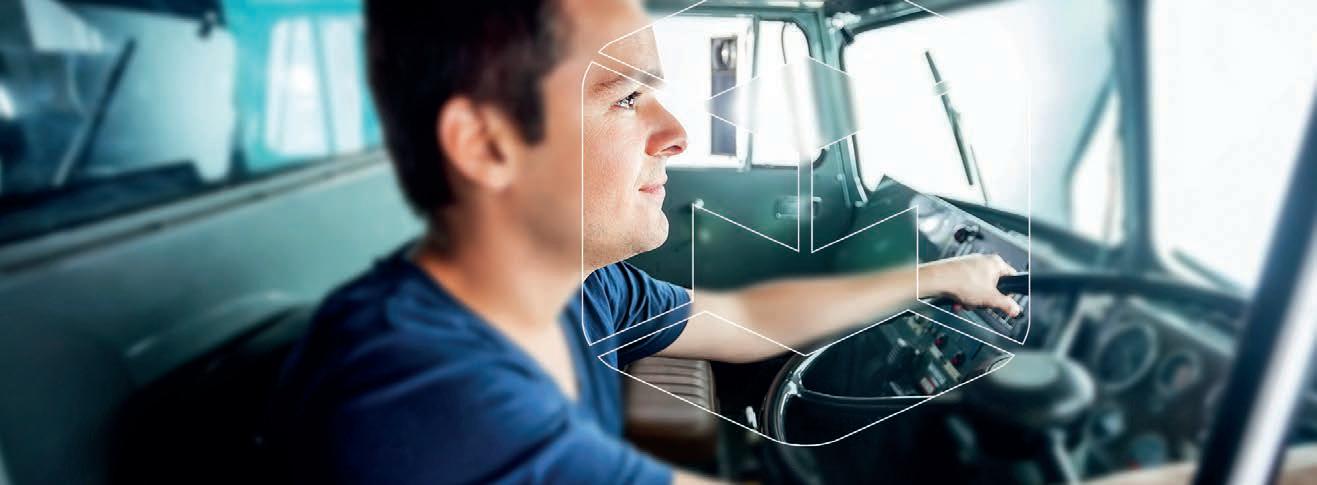

68 april 2023 EWD & FATIGUE MANAGEMENT SHOWCASE
Unpacking Driver Monitoring Systems
on safety.
A sophisticated DMS can prevent accidents before they happen.
effectively monitor a driver’s engagement level, provide real-time alerts and help prevent accidents before they happen.
“It’s worth noting that these technologies are separate,” says Paul McGlone, Chief Executive Officer, Seeing Machines. “DMS can and should be used to complement ADAS to enhance driver and vehicle safety, when fully integrated in the vehicle.”

But it’s worth remembering not all DMS are created equal.
The two most recognised types of DMS are those that detect whether a drivers’ hands are on the steering wheel and those that use cameras to measure driver attention and state. Camera-based DMS (known as ‘direct’ or ‘awareness’ DMS) face the driver and monitor their head and/or eye movement to detect where they are looking.
‘Indirect’ (or ‘control’) DMS include systems that detect vehicle behaviour (largely redundant in vehicles with ADAS) and those that detect the presence of hands on the wheel. While a hands-on-wheel approach may sound effective, it does have a few notable downsides.
Perhaps the most obvious is that just because a driver’s hands are on the wheel does not mean they are necessarily engaged with their attention on the road. Torque sensors (commonly used in hands-on-wheel DMS) are very simple and easy to fool.
Camera-based DMS can measure drivers’ visual attention state. They can detect when a driver is looking at the road, when they are not, and the last time they checked it.
“A driver with their hands on the wheel but their eyes off the road, is a driver who is woefully unprepared to take control,” says Paul. “While it’s now widely accepted that camera-based DMS offer the best way to support driver attention, there are also important differences among camera-based DMS.”
A major difference, according to Paul, is whether the system uses the driver’s eye or head movements to determine gaze
direction. A common misconception is that all camera-based DMS track eye movements to determine where they are looking when in fact, many DMS actually rely on head pose. Head pose is often a reliable indicator of where someone is looking, but not always. It can be an unreliable indicator, particularly when it comes to one of the most common and dangerous distractions when driving — using a mobile phone. Many drivers move their eyes independently to their head when interacting with a mobile phone, which presents an issue for a DMS that uses only head pose to infer distraction. This is a reason why the safest and most reliable DMS are those that can detect driver eye movements in addition to head movements. To wit, DMS is key to reducing road related trauma. A DMS is as critical to safety as the
three-point seatbelt implemented in the late 1950s, and random breath testing introduced in the decades following. Why? It is the only way to address, in real-time, long standing safety issues such as distraction and drowsiness. Using artificial intelligence, a DMS monitors a driver’s attentiveness and intervenes if it detects a fatigue or distraction event using visual, audible or haptic alerts. This technology is already being mandated globally. For example, Europe’s Vehicle General Safety Regulation (GSR) required all road vehicles from July 2022 to be equipped with new safety features, including an “attention warning” in case of driver drowsiness, among others. It’s only a matter of time before Australia catches up. So while it may not be mandated here today, why would you wait to protect your fleet?
primemovermag.com.au 69
Camera-based DMS can measure drivers’ visual attention state.
SPORTING THIS LIFE
A familiar sight at Australian motor sport events is the Hino Sports Deck which has become an integral part of the Supercars circus.
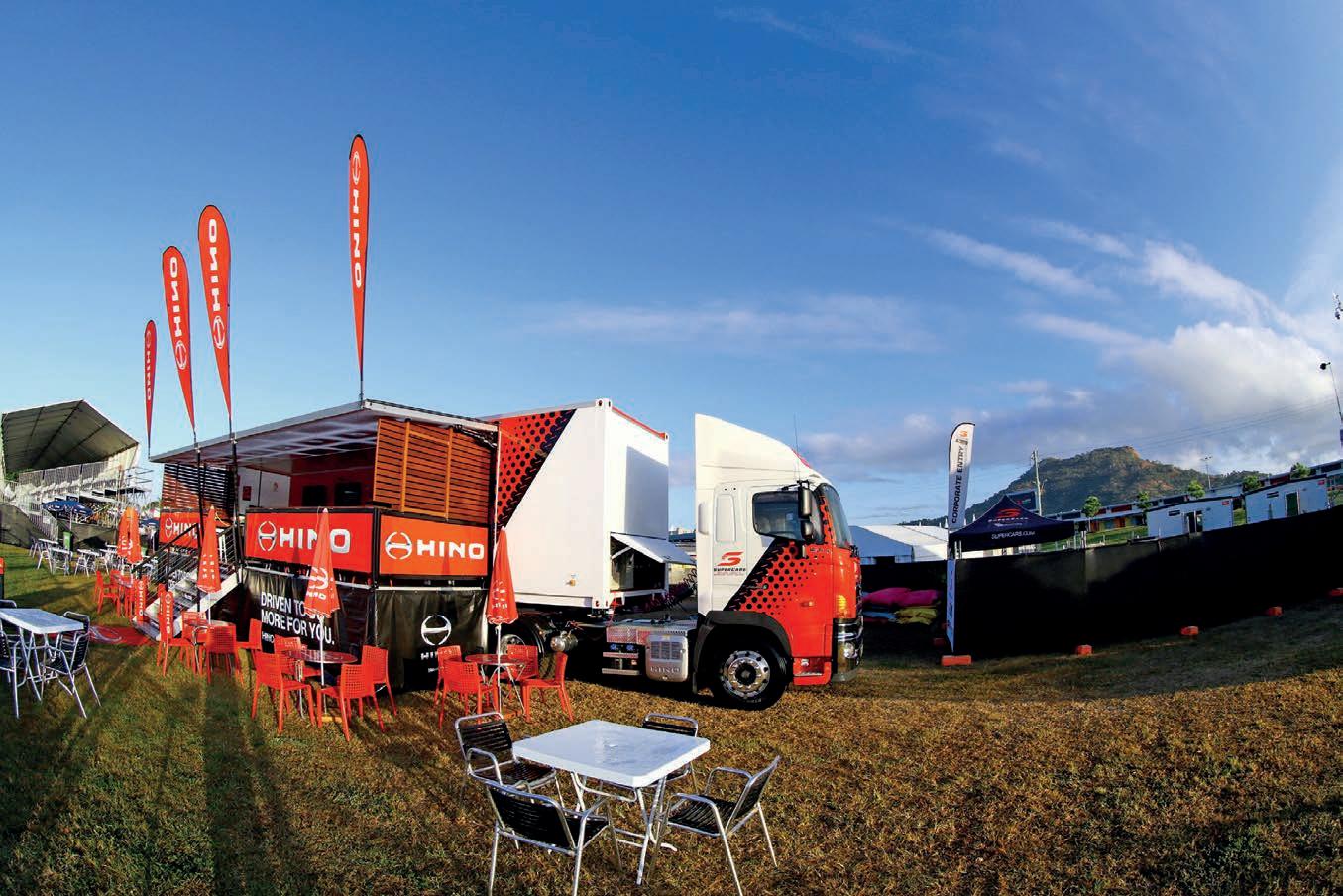
The Hino Sports Deck is based on a converted 40-foot shipping container and is a high profile feature of Hino’s ongoing sponsorship of the Supercars series. This latest version is an all-new unit, replacing the original which was

launched in 2016. Once onsite at a raceway event the Sports Deck unfolds, similarly to the fantastic characters from a Michael Bay Transformers movie, to provide a three-story hospitality venue complete with two 75-inch screens. For self-sufficiency, the Sports Deck derives
electrical power from a 7KvA generator with its own 200-litre fuel tank. The Sports Deck is towed by a Hino 700 Series SH1845 4x2 prime mover itself powered by Hino’s 13-litre 13C-BL engine which has peak power of 450hp (331kW) and 2157Nm of
70 april 2023 TEST DRIVE
Hino 700 4x2 with tri-axle skel trailer carrying a 40-foot container.
torque. The engine is well matched to the latest generation of the ZF 16-speed Automated Manual Transmission (AMT), the innovative two pedal TraXon TX 2441TO. There’s less than 20 tonnes of weight involved in dragging the Sports Deck to events around the country so the driveline is not at all stressed on a Sydney to Melbourne trip such as this. This is a ‘gentleman’s’ drive spread across two days with an overnight stop in nice accommodation at around the halfway point in Albury so there is no need to occupy the bunk or risk exceeding the limits of allowable log book hours. Simply drive the truck and enjoy it, even though the weather is not exactly ideal as we drive through some quite heavy showers along the way. Driver’s vision is good through the generously sized windscreen and the aerodynamic, electronically adjustable
heated mirrors and convex spotter mirrors, plus curb and front observation spotter mirrors, all of which are designed to remain reasonably clean despite the lousy weather. A reversing camera is located at the rear of the Sports Deck trailer which will come in handy not just during normal use but when setting up in the often-tight confines of motor raceways.

A 4x2 prime mover towing a tri-axle skel trailer with a 40-foot container locked onto the pins is a common sight around Australian port precincts or even delivering groceries to suburban supermarkets, but it presents such an unusual combination on the Hume Highway that two of Victoria’s finest can’t help but activate their hidden red and blue lights and invite me to follow them to the nearest rest area. After passing the alcohol test, the tongue
dragging drug swab and even a look back through the past few trips recorded in the logbook, the two gentlemen in blue reveal to me that they had harboured just the slight suspicion that I was hauling something which may not have been kosher. However, upon checking out that the container was actually the innovative Hino Sports Deck mobile promotional facility, conversation turned to the various merits or otherwise of their diesel 7-Series BMW compared with the petrol Hemi’s and LS engines so adored, and now missed, by Highway Patrol officers around the nation.
Back on the road, the braking performance of the Hino 700 is very impressive and features Hino’s Electronic Brake System (EBS) combined with the Hino Taper Roller brakes, which enhance braking
primemovermag.com.au 71
A reversing camera helps with tight access points at racetracks.
performance and reduces maintenance requirements and provide a good ‘feel’ for the driver. Standard auxiliary braking on 13-litre 700 Series models is handled by the genuine Jacobs Engine Brake system with the belt and braces addition of the ZF Intarder that is integrated into the rear of the transmission. The ZF transmission is controlled via a shift dial gear selector on the dash for Drive, Neutral and Reverse, and features a slow mode in both forward and reverse for improved manoeuvrability control such as when connecting trailers or backing up to loading docks.
The dash-mounted dial selector is complemented by a sequential type shift lever on the steering column which allows the driver to switch the transmission mode between automatic and manual, and manually select gears without having to take their hands off the steering wheel. The TraXon is equipped with an Easy Start system which holds the brakes and assists with smooth take-off after stopping on a slope.
The Hino 700 is equipped with the comprehensive Hino SmartSafe safety package. It incorporates a number of driver assisting technologies taking an active focus on protecting drivers, passengers and other road users and this latest version now includes the Driver Monitor (DM) which has been refined since we last drove a 700, resulting in zero false alerts being triggered throughout the entire Sydney to Melbourne trip.
Hino SmartSafe also includes a Pre-Collision System (PCS) with Autonomous Emergency Braking (AEB), Pedestrian Detection (PD), Lane Departure Warning System (LDWS), Vehicle Stability Control (VSC), the Reverse Camera and a suite of other standard safety features.

Hino has put a considerable amount of local effort into Hino-Connect, its nextgeneration advanced diagnostics and business intelligence system developed in Australia, which provides real-time

performance data tracking, remote diagnosis of vehicle faults and dedicated Hino-Connect specialist support. In the unlikely event of a severe fault the alert and possible remedy is sent straight to the driver via the multi-media screen on the dash, as well as an email to fleet manager and to a Hino-Connect specialist who will liaise with driver, owner and dealer to track and oversee the progress of the repair to get the vehicle back on the road quickly. This level of support delivers a high level of confidence when the trucks are out on remote highways.
Instead of the dolphin grey usually associated with Japanese truck interiors, the Hino has a contemporary interior trimmed with a balance of faux carbon fibre, silver and ‘earthy’ tones. The wraparound dash creates a cockpitlike environment for the driver who benefits from the comfort of the latest generation ISRI seat which has air lumbar supports and a myriad of adjustments. The redesign of 700 Series cab allows for additional adjustability in rearward seat travel. Combined with the tilt and telescopic steering wheel adjustments, it can provide the ideal driving position for drivers of
various shapes and sizes. The ride is further smoothed due to the cab being remotely mounted on four-point air suspension, resulting in less vibration, less road noise and consequently reduced driver fatigue without feeling that you’re on a boat wallowing on the waves. The interior temperature of the cab is maintained by automatic climate control, while the bunk is ADR42 sleeper compliant, and has interior light controls which can also be operated from the sleeper area.
The dash layout features large high contrast speedometer and tachometer, and a central 7-inch LCD MultiInformation Display that shows information such as the Hino SmartSafe settings, driving economy, gear selection and vehicle maintenance data and has Bluetooth and Android connectivity. The Hino 700 Series has been a game changer for the manufacturer by delivering a credible candidate for a Japanese truck in the Australian Heavy Duty sector, bolstered by an extensive array of safety features. It’s also a “drivers’ truck” due to its operational design, comfort and finish which make this inter-capital drive an easy and enjoyable experience.
72 april 2023 TEST DRIVE
The Sports Deck transformed
FLEET IMAGE & BRANDING

ADVERTISE IN OUR JUNE 2023 PRODUCT SHOWCASE ON TRUCK PRESENTATION.
BOOKING DEADLINE: 28 APRIL 2023
Branding around a business, according to marketing principles, should be unique, simple and consistent. Transport companies, trucks and the trailers they haul, are often rolling billboards in which to associate a company identity with a product. Adopting a distinct uniform approach to a business or fleet conveys an awareness that brand vision aligns with competency, customer service and growth. Polished extrusions, chrome stacks, robust bullbars, livery designs, windshield guards, tanks, wraps, lights, alloy rims, sun visors, stainless air cleaners, stylish interiors and shiny paint finishes all complete the picture of a healthy, safe and, well run business at the top of its game.
Prime Mover offers a unique opportunity to showcase the products and businesses who help make heavy vehicle operators iconic. First impressions do count. How does your business help commercial vehicle operators fly the flag on the highway?

Arrow Transport Logistics Into Parts Unknown MAGAZINE Delivery Magazine inside: Pages 70-77. APRIL 2023 primemovermag.com.au ® April 2023 ISSN 1838-2320 03 APRIL 2023 $11.00 THE PEOPLE & PRODUCTS THAT MAKE TRANSPORT MOVE INDUSTRY Carrier: Wollongong Crane Trucks Feature: Easy Truck Rental Showcase: EWD & Fatigue Management Personality Profile: John Saint INNOVATION Fleet: Hazell Bros High Productivity: Recycal Test Drive: Hino 700 4x2 Delivery: Ford F-150 ASHLEY.BLACHFORD@PRIMECREATIVE.COM.AU | 0425 699 819 TO BOOK IN PRIME MOVER CONTACT ASHLEY BLACHFORD NOW ®
SAINT PATRON
In the past 30 years at JT Fossey Trucks in Tamworth, John Saint has sold more than 3,500 new trucks with all but a few being single unit sales.
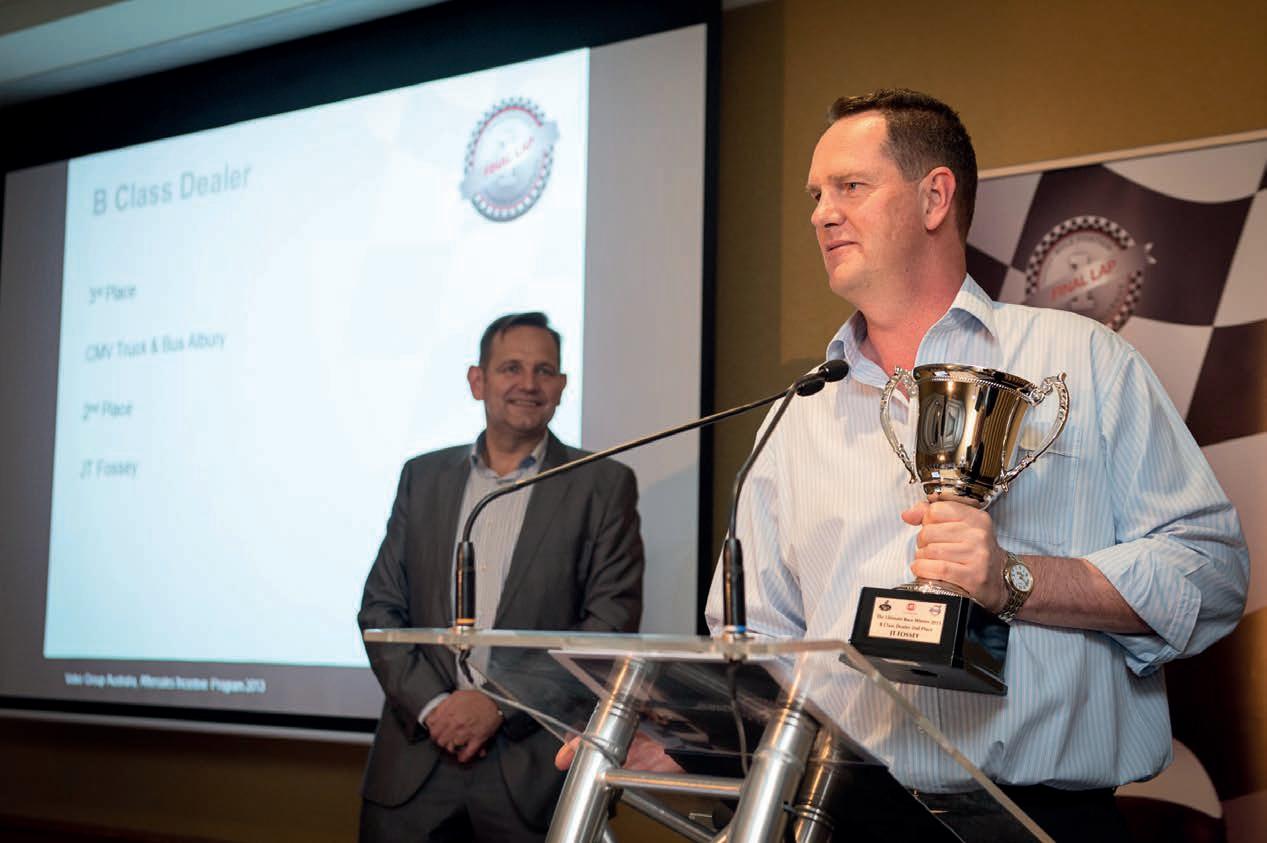
Prime Mover: Running a truck dealership is a demanding and complex job. What has kept you motivated for all this time?
John Saint: I genuinely love it and I still get a buzz handing keys over. This is a place where a lot of trucks work within the area, and to drive to Gunnedah or Armidale and see two or three of the trucks I’ve built out there earning money for the customers, who respect and look after them, makes for a very proud moment for me. A truck is a significant item that everyone sees, and we do see a lot of our trucks every day of the week.
PM: Are there extra challenges operating away from the capital cities?
JS: I’m fortunate that I’m based in rural Australia. We’ve got good honest fair dinkum people in our area who buy and operate trucks who also want to build solid long-term relations which is what we build our business on.
PM: Why did you pick sales as your career?
JS: I really enjoy meeting new people and helping them realise their future. A lot of items in our world were bought or obtained through a sales person. Sales people vary in the degree of interaction in a given product or service. I use the example of trucks because they are the basis of my selling experience and the industry that I
refer to in my sales story. If you are a sales person you enjoy interaction with others and you also enjoy seeing a completed transaction. Think of a conversation which starts about a product and ends in the sale. It’s a transaction between two identities resulting in the change of ownership. I enjoy the challenge and the test of my skills and knowledge.
In the truck industry I’ve found a long term relationship takes at least five years to develop and to be realised. It’s important not to push because if you put a good enough proposal forward, it will come back to you.
PM: Is the product you sell important?
JS: The product you are selling needs to be reputable, of sound quality and be
74 april 2023 PERSONALITY PROFILE
JT Fossey Trucks builds long-term relationships with the hardworking businesses in the Tamworth region. John Saint is the Dealer Principal.
John Saint recognised by Volvo Group in 2013.
represented nationally by other dealers, and globally by the franchise organisation. The truck industry is transient, so having locations throughout the country is particularly important to making sure the product is supported during normal servicing and breakdown situations. Dealership relations are extremely important in these situations. The product needs to be fit for the intended business and the job at hand. The specifications need to be right for the operation, image, driver acceptance, safety, economical operation, ease of service and repair and aftersales support.
PM: What do you consider is your key to success?
JS: Believe that you own the business —it’s your company, lock, stock and barrel. Stop doing the things you know you should not be doing and start doing the things you know you should be doing. The road to sustained successful selling depends upon the good and the right things you say and do every day. Time is a valuable tool, so make the most of it. Everyone wants to be successful and respected for what they do, and a good salesperson has to earn this.
PM: What do you see as the key factors in selling trucks specifically?

JS: I’ve always based my selling on getting to know the customer, things such as what
they need and what are the most important points for them and then designing a truck specification and formulating a deal around that. It’s understanding what they want, what they need to achieve, how long they want to use it for, and then building the truck to suit all of that. You can still make adjustments as you go along. Some of the conversations we might have during the sale process can be far from talking about trucks. It can be an historical overview about where they’ve been in their own operation and where they want to go. My reputation is built around people wanting security in their dealing, where they talk with someone who knows what they are doing, who can deliver what they want and then make sure they are going to be supported afterwards. It’s important that sort of grounding is in our sales strategy.
PM: Is that diagnostic process preferable to simply selling them a particular truck because you’ve got one sitting on the lot?
JS: That happens more often than you might think. People often over spec for what they really need to achieve, and this results in trucks that disappoint in terms of the expectations of economic and efficiency factors, as well as driver acceptance. There are a lot of things that go into the pot when we start talking about what truck to buy and can include having reference back to previous sales, customer testimonials, my own experience in the industry, and what
they believe they want from a truck. All those things go together and we design a truck specifically around each customer’s key requirements.
PM: Although you’re clearly at the top of the management structure, you don’t do it all on your own. What support do you have?
JS: It’s teamwork from day one! Unless they are on the same page in understanding their role in the team every day, it won’t work. Over the years I’ve learned a lot and I want to continue to do so, but I also want to help others who are in a similar situation trying to get established.
PM: What are important attributes for your dealership team?
JS: It’s important for all of our staff to have an understanding of why we are here and why we do what we do every day, and understanding that the customer is committed to our dealership for the product and support and that we need to deliver that back at the same level they have invested in us. We need our people to feel they are contributing. We share customer feedback both good and bad. Having a sense of urgency, having the required knowledge and having empathy for the customer are factors we work on every day. Our inductions for new team members are quite extensive so they get an immediate understanding about how it all works.
PM: You started your working life as a wool classer. If you hadn’t got into selling trucks, what might you have done?
JS: I’ve always wanted to buy a hotel. I’ve always wanted my own restaurant because I reckon I could create the point of difference which would attract people even if they don’t know why they are attracted. I believe that’s why I’m successful in my selling because I can find that point of difference.
PM: What’s the future look like?
JS: We’re going into a whole new world now with electric vehicles and hydrogen power and I think Volvo are well and truly out in front. It’s going to be interesting working with them.
primemovermag.com.au 75
John Saint at his Tamworth office.
SUNSET UNLIMITED
Roadtrains have an important role in livestock transport as do operators of more compact units such as Tamworth’s Mckyla Hull.
Diversity is important to the Hull family, as evidenced in their varied business interests which include pastoral operations including purchasing and selling livestock, a successful welding and truck body building business specialising in stock crates run by husband John, and a bespoke livestock transport service where the manager and lead driver is mother-of-three Mckyla Hull.

Mckyla and John buy and sell quite a lot of cattle. It accounts for a large share of the work for the truck which also transports, sheep and even goats for an increasing number of clients all over New South Wales, particularly in the New England district where the JM Pastoral Company is based.
Mckyla’s father Darren drove a livestock truck himself and in his current semi-retired situation occasionally accompanies his daughter on some of the longer trips. During quieter weeks the Fuso rigid may cover just 300 kilometres, but when business is busy up to 3,000 kilometres can be driven over a seven day period. The variations in the demand can often be affected by short-term weather conditions or current prices for livestock, which presents a challenge to offer steady employment to a permanent driver, so Mckyla looks after most of the operational and driving duties herself, with the occasional ‘two up’ trip with Darren.
The previous truck was a Fuso. It was purchased second hand and ultimately has travelled almost 800,000 kilometres, yet has presented no issues with the driveline and has never even required a replacement clutch to be fitted. Now equipped with a flat-bed tray, that venerable Fuso has yet to be fully retired and continues to deliver faithful duty as a farm truck and also delivering steel to the welding business.
The decision to purchase another Fuso was influenced by the exceptional longevity of the previous truck combined with the fact that the local dealer JT Fossey Trucks is literally just a few doors away from the welding business from which the
76 april 2023 PRIME MOVERS & SHAKERS
Mckyla Hull.
stock truck also operates. The business relationship works both ways as JM Welding manufactures stock crates for JT Fossey clients.
The new model is a Fuso 1627 Fighter, powered by a 270hp/784Nm 7.5-litre six cylinder engine coupled to a ninespeed manual transmission. Due to the remote locations where Mckyla often travels she wanted a straightforward truck which wasn’t overly complicated, along with the additional peace of mind which came with the Fuso’s five year/350,000 kilometre warranty.
“I don’t need a lot of technical features and I don’t need a half million-dollar truck sitting there,” Mckyla says. “Power windows are all I need, plus an air conditioner and a heater and I’m right to go.”
During winter that heater can prove to be essential equipment when Mckyla travels to locations such as Casino and Glen Innes where early morning temperatures can drop below minus seven degrees.
“The old truck never let me down, but it didn’t have a heater and my Nan actually made me a little lap blanket,” says Mckyla. Another feature she appreciates about the new Fuso is its good ground clearance.
“We’re driving in the paddocks quite a bit and we encounter lots of dirt, gravel and mud as well,” she says. “It’s a great little truck and for what I need it to do,
The new Fuso Fighter is equipped with a JM Welding 24-foot single deck antibruise steel stock crate featuring in-floor drainage and an effluent tank, a drop ramp and a rear sliding gate. It can carry around 80 to 100 sheep, or 35 smaller cattle (each weighing around 200kgs) or 18 larger cattle. Mckyla had to wait in line just like any other customer for John to manufacture the crate, but this provided them with the time to plan for the optimum design outcome.

The new crate is slightly shorter than the previous unit’s 26.5 feet which assists with negotiating the often, tight access conditions on some farms and at some livestock loading facilities.
Driving livestock vehicles requires a specific skill set to ensure the welfare of the animals in transit, as well as the need
to keep in mind the overall stability of the vehicle, often on less than first rate roads. “You can’t just hook into a corner, and you have to look well ahead up the road in case someone pulls out in front because you can’t just jam the brakes on,” says Mckyla.
This is the Hull’s first brand new truck so it was decided to make its appearance stand out from the usual plain white cab. The Fuso’s cab has been vinyl wrapped with graphics promoting the JM Pastoral business, while John’s welding operation receives some subtle, laser cut steelwork. “It’s like free advertising and the more people who can see me and what I do, the better,” says Mckyla. “This is our first brand new truck so when we did it I decided to make it nice looking and stick out with something different you don’t usually see, especially on a livestock truck. You don’t miss me.”
The metallic paint on the crate was actually applied by the paint supplier’s representative and matches the cab’s graphics.
The livestock industry, at large, has been traditionally male-dominated and Mckyla is proud of how far the industry has advanced in terms of inclusivity.

“I am most proud of making a path within an industry which can be extremely hard to access,” she says. “And doing it well and succeeding when many don’t. It’s still not where I would like it to be, but it has come a long way.”
Women, in Mckyla’s view, are usually
more responsible.
“It may take us a little longer to do certain tasks and we have to adapt because we are not as physically strong as many men,” she says. “We’re logical thinkers so we have to work our own way around doing things. If somebody sees me and thinks ‘Oh, I could do that’, that’s what I want. It used to seem like we had to work three times as hard to be recognised for what we do and be taken seriously. It’s taken a long time to get there and it’s such a good industry to be in I don’t know why people wouldn’t do it.” Over time, Mckyla has found the older males she encounters in the industry to be the most supportive.
“I thought they’d be the ones that I’d run into trouble with but they are super helpful and they’ll offer to assist but not be overly pushy but not because they think I can’t do something,” she says. “Most are very gentlemanly and they know I’m quite capable, but they offer to help because it’s the right thing to do.”
In addition to the responsibilities associated with three school-aged children, as well as John’s business, Mckyla appreciates her unique situation of being able to get out on the road and recommends it to other women in similar circumstances.
“I love it,” she enthuses. “The places you get to go, the sunsets you get to see and the amazing scenery. I get to see the country and get paid to do it. You can’t do that in an office.”
primemovermag.com.au 77
Fuso Fighter with JM Welding 24-foot single deck anti-bruise steel stock crate.
KINGS TRANSPORT BOLSTERS EV FLEET
Kings Transport has added two battery electric powered vans to its fleet. The Skywell EC11 E-Cargo vans will be servicing an IKEA contract.
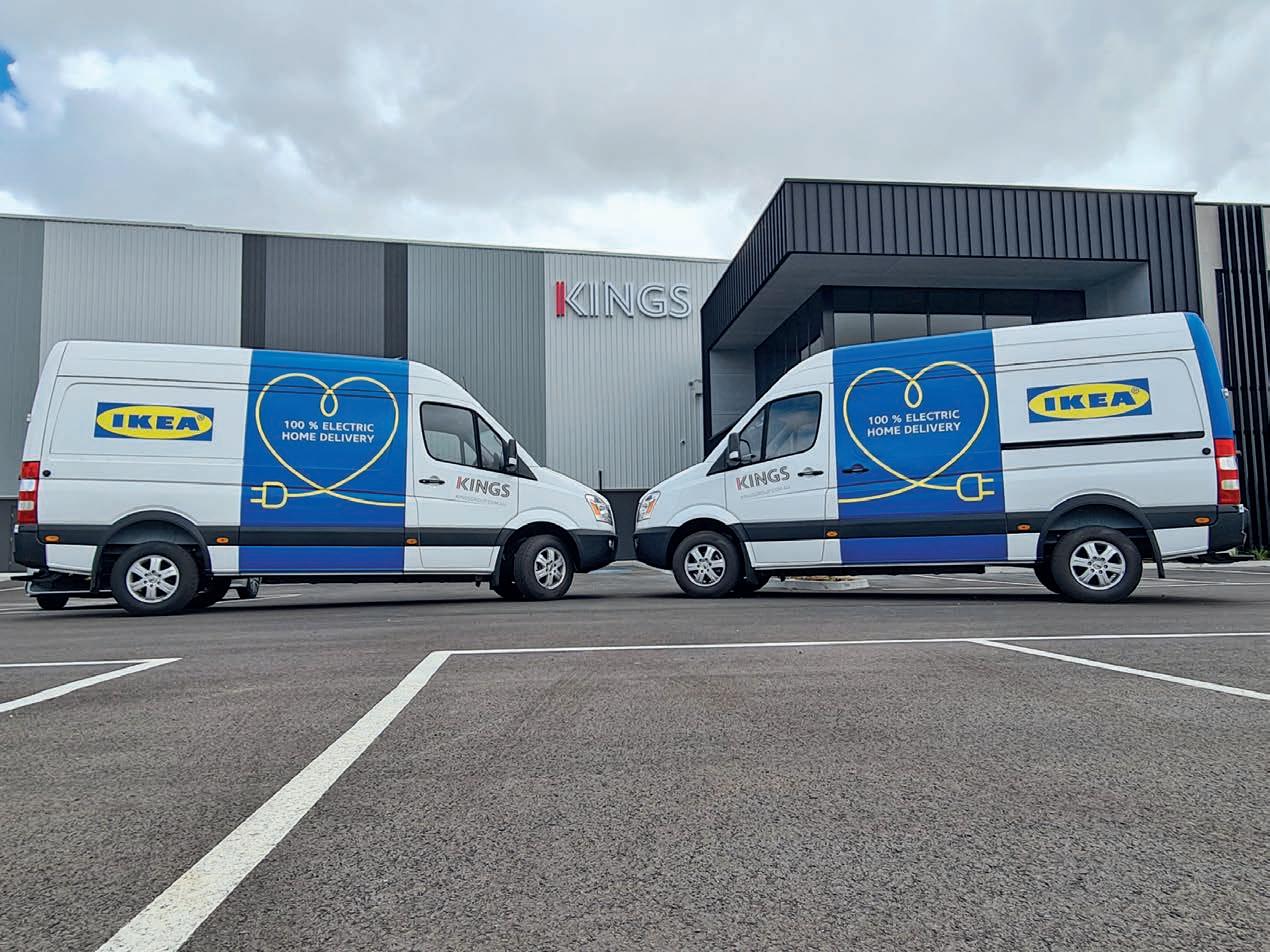
Reportedly offering the largest capacity of any commercial electric van in the Australian market, the Skywell units are considered particularly well suited for last mile delivery.
The vans are equipped with a 73.6 kWh battery, CCS Type 2 charging and a 22kw capacity AC onboard charger. A range of between 200-300km (based on load) offers sufficient route coverage for daily use.
Kings currently operates an EV fleet of seven vehicles including new Foton iBlue trucks, with more coming online throughout the year. These new
vehicles were part of Kings Group’s broader strategy to reduce the company’s carbon footprint as it moves towards more sustainable solutions in transport according to Barry Thompson, Chief Executive Officer of Kings Group.
“As a group we’re conscious of our environmental impact, so we’re working with CarBon to take the lead in the integrated logistics sector and transitioning to zero emission vehicles where feasible,” he said.
The vehicles were sourced through electric vehicle leasing company, CarBon, Australia’s first purely Electric Vehicle leasing, subscription and rental company, which was founded by CEO Scott Gillespie.
He said commercial vehicles were presently responsible for around one third of carbon emissions, so electrification at scale will play a significant role in helping to slow climate change.
“Transitioning to EVs insulates against regulatory dynamics, improves brand equity and importantly, zero- emissions vehicles are projected to reach total cost of ownership parity across multiple use cases in the next decade,” he said.
““If Australia is going to reach its 2030 emissions targets, commercial and fleet EV transition initiatives will be crucial to achieving those goals.”
Kings first committed to electric vehicles back in 2017.
NEWS 78 april 2023
Skywell EC11 E-Cargo vans.
SIXT EXPANDS RENTAL FLEET WITH IVECO
SIXT has expanded its commercial vehicle rental fleet through the addition of 45 new IVECO Daily 35S vans. The vehicles were purchased to meet the growing needs of SIXT’s long-term rental customers working in pick-up and delivery applications.
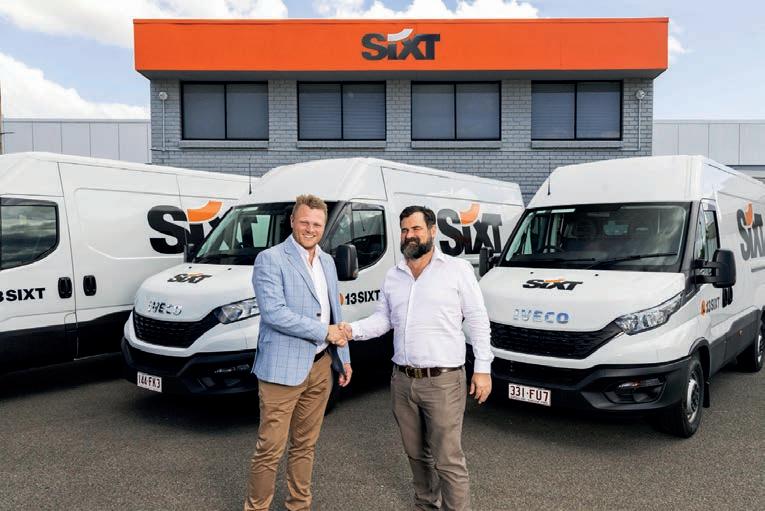
SIXT National Commercial Fleet Manager, Ian Moore, said the Dailys were a great fit for the fleet and the requirements of its clients.
“From a specification standpoint, the Daily offered an extremely close match to what we seek in a van,” he said. “The vehicles we select need to be practical and flexible to suit varying final mile delivery duties, and must also align with SIXT’s broader requirements around safety and emission performance. The Daily meets stringent Euro 6 emission levels and is also well equipped from a safety standpoint — it’s important we can provide these benefits to our customers as well as other road users.”
Powering each of the Dailys is IVECO’s 2.3-litre Euro 6 turbo-diesel engine, coupled to an eight-speed automatic transmission. The 12 cubic-metre vans come with a range of standard active and passive safety features, including
four SRS airbags, Advanced Emergency Braking System (AEBS) and IVECO’s ESP9 program — a suite of nine electronic driving aids.
According to Moore, a major consideration for SIXT is the comfort and user friendliness of its fleet, which was met with the new IVECOs.
“Users of the Daily will typically spend long hours at the wheel each day and often in city areas where there’s traffic congestion, so it’s vital that we chose a model that was comfortable
TRANSPORT INDUSTRY LEADER MOURNED
Former chief executive of VicRoads, Gary Liddle, has passed. Liddle, who served in the transport industry for more than 50 years, played a critical role in shaping the transport network in Victoria. He occupied various senior leadership positions at the Department of Transport, Planning and Local Infrastructure, ARRB, Austroads and iMOVE.
As a respected figure, Liddle was made an Officer in the Order of Australia (AO) in 2017 for “distinguished service to public administration in the Victorian transport sector through leadership in policy direction, infrastructure development, road safety and regulatory reform.” At VicRoads, where he was tenured for 40 years, he led major initiatives such as
the implementation of the Road Safety Strategy and the SmartRoads program. A mentor and friend to many in the industry, Liddle, according to Roads Australia, was known for his generous spirit and sense of humour.
“Many people found his always understanding and genuine approach made him a great leader of people,” the organisation said in an online statement.
Working with the Late Dr Alf Smith AM in the introduction of the world’s first fully integrated electronic tolling system, Liddle helped to change the way motorists paid tolls in Victoria, a development that had global implications.
He was a member of numerous industry committees and forums, including the
automatic transmission, a long list of driver appointments and car-like seating position, the Daily is simple to drive.
“Access to the cabin and load space is also good, which makes it less tiring for drivers who are regularly getting in and out of the vehicle to make deliveries.”
Commercial vehicles (CV) such as the Daily make up a considerable portion of SIXT’s fleet, and include utilities through to light trucks, tippers and mine spec vehicles.
Australian Intelligent Transport Systems Advisory Group and the Australian Smart Communities Association. He was also a member of the Advisory Board for the Intelligent Transport Systems World Congress, which brought together global experts to discuss the latest developments in smart mobility. Liddle’s passion for the transport sector and sharing his knowledge with the next generation was further reflected in his role as Enterprise Professor, Transport at the University of Melbourne. No stranger to controversy, he took responsibility for a controversial decision at VicRoads in 2010 after the organisation did not mark Remembrance Day for fear of offending people. He also held leadership roles with V/Line and Public Transport Victoria.
deliverymagazine.com.au 79
IVECO Australia Business Development Manager - Vans, Ben Osborn with Ian Moore.
HYUNDAI UNVEILS NEW STARIA-LOAD PREMIUM
Hyundai has announced its new STARIA-LOAD Premium Van, which will be arriving in dealerships this month. The two-seat STARIA-LOAD Premium Van will sit above the regular STARIALOAD Van, while the five-seat STARIALOAD Crew Van will continue as a single-grade model. Each variant is powered by a 2.2-litre CRDi turbodiesel engine, paired with an eightspeed automatic transmission and front-wheel drive.
Hyundai Motor Company Australia CEO, Ted Lee, said the STARIA-LOAD will be a new benchmark for the industry.
“We are pleased to introduce STARIALOAD Premium, which once again resets the safety standard in the commercial van segment with its new standard advanced driver assistance
systems,” he said. “STARIA-LOAD Premium’s new safety, style and convenience features, and the model’s passenger-car like comfort make it a uniquely attractive offering in the van market.”

STARIA-LOAD Premium offers additional standard features designed to enhance the model’s safety, style and convenience. These include a 10.25-inch supervision instrument cluster and a 10.25-inch navigation multimedia unit, LED headlights, 17-inch alloy wheels, automatic climate control, smart key with push button start, and a smart power tailgate. The Premium also gains additional standard safety technology in the form of a Blind Spot View Monitor (BVM) and
a High beam Assist (HBA) system. In ANCAP’s Commercial Van Safety Comparison analysis, STARIA-LOAD performed highly in each area to earn the first PLATINUM level of crash avoidance in the segment, with a score of 90 per cent and a five star rating. Completing an appealing package are additional exterior colour choices for STARIA-LOAD, to give customers new personalisation possibilities.
STARIA-LOAD Premium will be available in Abyss Black, Graphite Gray and Moonlight Blue, in addition to the existing Creamy White and Shimmering Silver options.
Pricing begins at $45,740 for the two-seat Van, $49,640 for the fiveseat Crew Van, and the new two-seat Premium Van at $51,240.
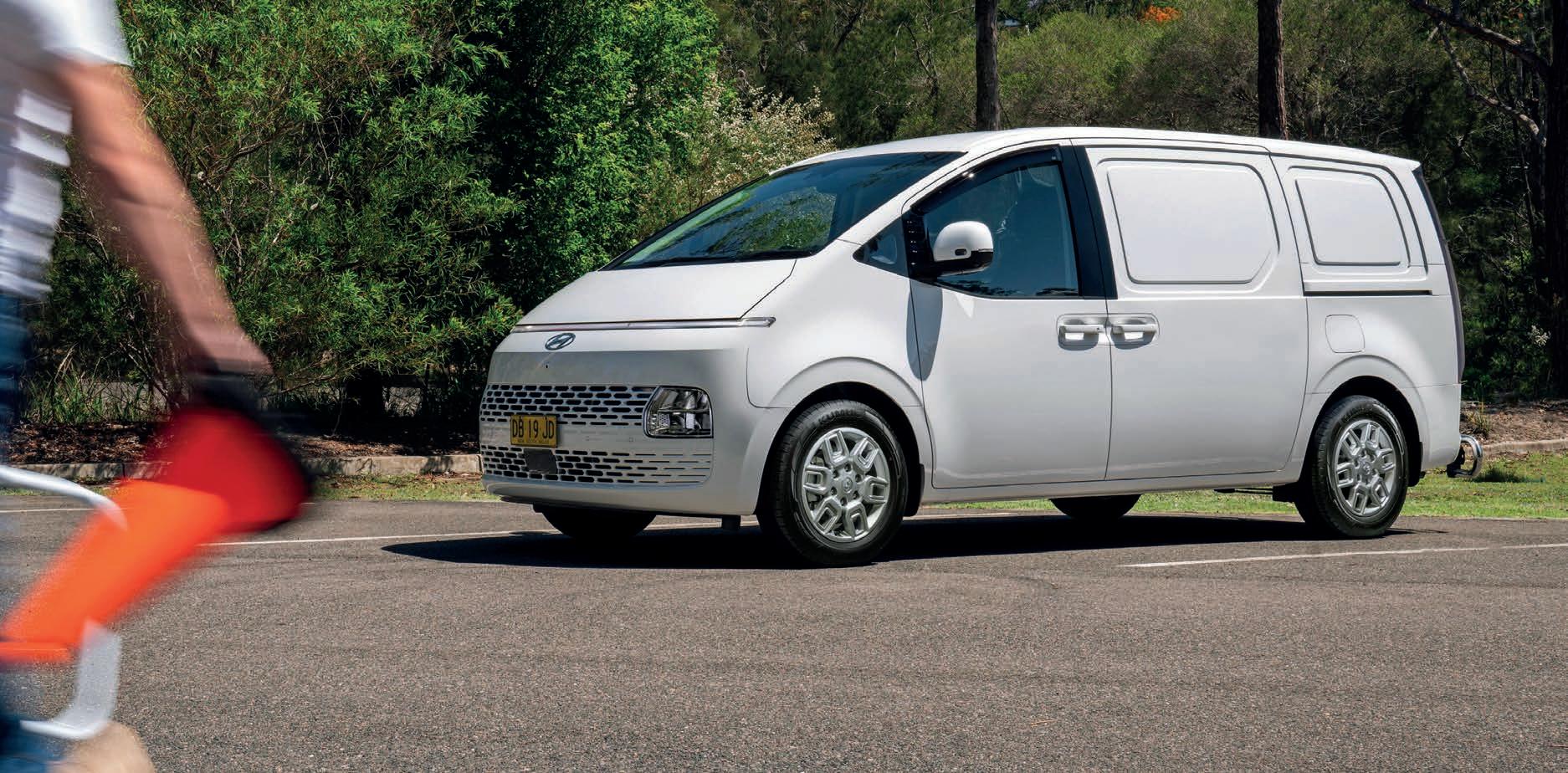
NEWS 80 april 2023
Hyundai’s new STARIA-Load Premium Van.
RENAULT TRAFIC

big space for big things
the longest loading length in its category: up to 4.15m best in class driving range

don’t miss out on the instant asset write off1. order today to lock in delivery before june 30.
renault.com.au
OVERSEAS MODEL SHOWN 1Subject to complying with statutory conditions. Eligibility for instant asset write-off depends on your specific circumstances. For more information on accessing the instant asset write-off, consult with your accountant or qualified tax professional before making a decision.
TALK ABOUT A REVOLUTION
Ram Trucks are joining the Battery Electric Vehicle (BEV) brigade with a plug-in version of the Ram 1500.

Amidst the over-the-top razzamatazz surrounding the US Super Bowl global telecast was a 60-second commercial announcing the all-new Ram 1500 REV (Revolution Electric Vehicle). It’s the first battery electric light-duty pickup truck from the RAM Trucks brand. North American residents were invited to register their interest and even order reservation for a $100USD refundable deposit. Unsurprisingly, this sold out within a week of the Super Bowl launch. Not a lot of technical details are available yet from RAM concerning the 1500 REV and more information is expected to be forthcoming over the following months in the lead up to the vehicle’s market release, which is scheduled for late in 2024, and the company already has high hopes for its success.
“The RAM brand has redefined the pickup truck segment before and will once again with the all-new RAM 1500 REV,” said Mike Koval Jnr, Ram brand CEO-Stellantis. “We believe in bringing the right range of powertrain solutions to our customers, and the RAM 1500 REV will be the first in a line-up of electrified solutions that will add to our current award-winning truck line-up. We are on an exciting electrification journey that will see RAM push past the competition in areas customers care about the most: range, payload, towing, and charge time.”
Expectations are that the RAM 1500
REV will operate on an 800-volt electrical system and have two electric motors driving all four wheels and a range of up to 800 kilometres. The smart money says it will probably have a towing capacity of 4,500 kilograms. Similar to the Ford Lightning F150, the space under the bonnet will be a ‘frunk’, as in a front trunk, offering secure weatherproof storage complemented by additional power outlets. RAM has also alluded to “range lengthening technology” being added at a later time.
An early preview afforded to CES 2023 attendees in Las Vegas, confirms the exterior retains fender flares and an accentuated Coke bottle shape for those familiar with RAM DNA while the face of the truck is animated and has new RAM badging and an LED ‘tuning fork’ headlight design. LED lights have also been integrated into the front bumper flares. The fascia has a skidplate and pivoting tow hooks that can sit flush. The LED taillights are also fully animated.
RAM Trucks’ global parent has committed to becoming carbon net zero by 2038, with a 50 per cent reduction by 2030. Stellantis has set its course for 100 per cent of sales in Europe and 50 per cent of sales in the United States to be battery electric vehicles (BEVs) by the end of the current decade. Stellantis, which recently appointed Michael Filazzola to the role of Managing Director in Australia, plans to have more than 75
BEV vehicles and reach annual BEV sales of five million vehicles by 2030. Stable brand, Jeep, recently unveiled its first ever fully electric SUV. In Australia RAM is distributed by the Ateco Group.

LAUNCH
82 april 2023
PAD
New RAM badging is among the new features that define the front exterior of 1500 REV.


primemovermag.com.au 83
LED tail lights are fully animated.
Since plans were announced last year for the local introduction of the F-150 XLT and LARIAT models more than 8,000 Australians have registered their interest with a significant number of orders already placed with dealers. Both the XLT and LARIAT models will be in 4x4 crew cab configuration and will be powered by the 3.5-litre EcoBoost V6 twin turbocharged petrol engine coupled to a 10-speed automatic transmission. The EcoBoost delivers 298kW of power and 678Nm of torque thanks to Ford’s port-fuel and direct-injection (PFDI) system which uses a pair of injectors per cylinder in

conjunction with the twin intercooled turbochargers to provide instant power with minimal lag.
Two wheelbases will be available in both models. The Short Wheelbase versions will be 145 inches (3,683mm) with 5.5-foot (1,676mm) length pickup beds and the Long Wheelbase models will have 157 inches (3,734mm) between the axles with a 6.5-foot (1,981mm) long pickup bed. All models have 4.5-tonnes towing capacity. Standard features of the F-150 XLT include 20-inch six spoke machined alloy wheels, chrome front and rear bumpers, black platform running boards and a tailgate with a flexible step.
ON SITE 84 april 2023
Ford F-150 XLT.
Two versions of the ‘Built Ford Tough’ F-150 pickups will go on sale in Australia during 2023.
PROVEN PATHS
The flagship F-150 LARIAT models receive additional features such as a premium mesh grille insert, a chrome trim package including mirrors, door handle, tow hooks and running boards and an electric twin panel ‘moon roof’. LED headlights, fog lights and tail lamps are all part of the LARIAT package.
To ensure compatibility with local conditions, Ford has put the F-150 through more than 135,000 kilometres of durability tests locally, which is equivalent to driving around Australia nine times.
Exhaustive testing has also taken place at Ford’s Silver Creek testing facility in Michigan, USA and examples
of some of the world’s most rugged roads were replicated in the laboratory at Ford Australia’s You Yangs Proving Ground in Victoria where the F-150’s driveline, steering, wheels and suspension were punished on a Kinematic and Compliance (K&C) test rig.
“We’ve torture tested, tuned and reworked the right hand drive F-150 so that Aussie customers know they’re getting the full factory F-150 experience,” says Dave Burn, Performance and Customisation Chief Program Engineer at Ford Australia.

“We’re doing everything to make sure the truck will be right at home here in Australia.”
During local engineering and development, the F-150 models were subjected to temperatures ranging from -40 degrees Celsius to +50 degrees Celsius, trailer towing, mud, ultra-fine sand, water crossings and corrosion tests.
“When the F-150 hits Australian showrooms, customers can rest assured it’s been put through the same program as the NextGeneration Ranger and Everest which is the same program the left hand drive F-150 went through in the States,” says Burn.
Pricing starts at $106,950 plus on roads for the SWB XLT, progressing to $140,945 for the LWB LARIAT.
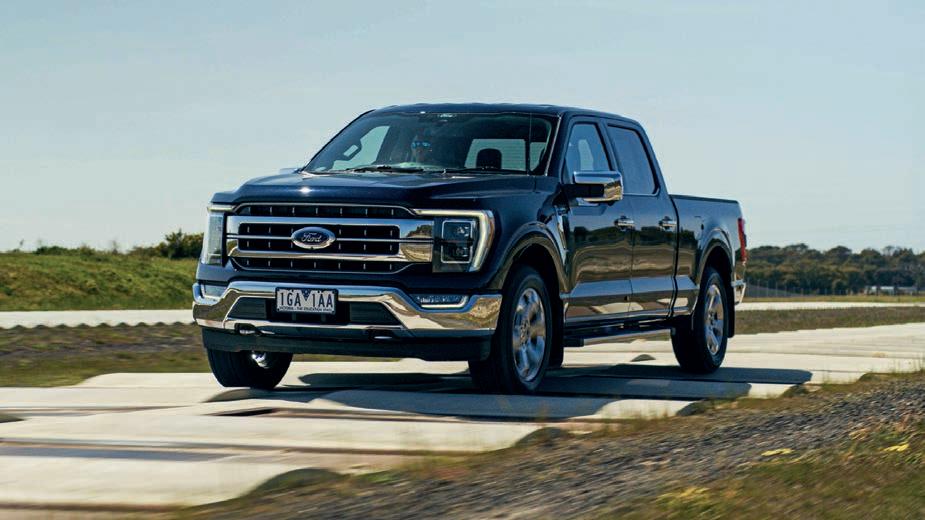
deliverymagazine.com.au 85
The F-150 undergoes kinematics and compliance testing.
This article describes the regulations and regulators that apply to heavy vehicles in Australia. I hope that it will provide a useful reference map for vehicle owners and vehicle suppliers. The Australian situation is complicated because we have been able to create new schemes that allow ‘non-standard’ vehicles to run on Australian roads. The complexity is evident to vehicle operators trying to make use of new schemes. The regulators are trying to balance road safety, efficiency and
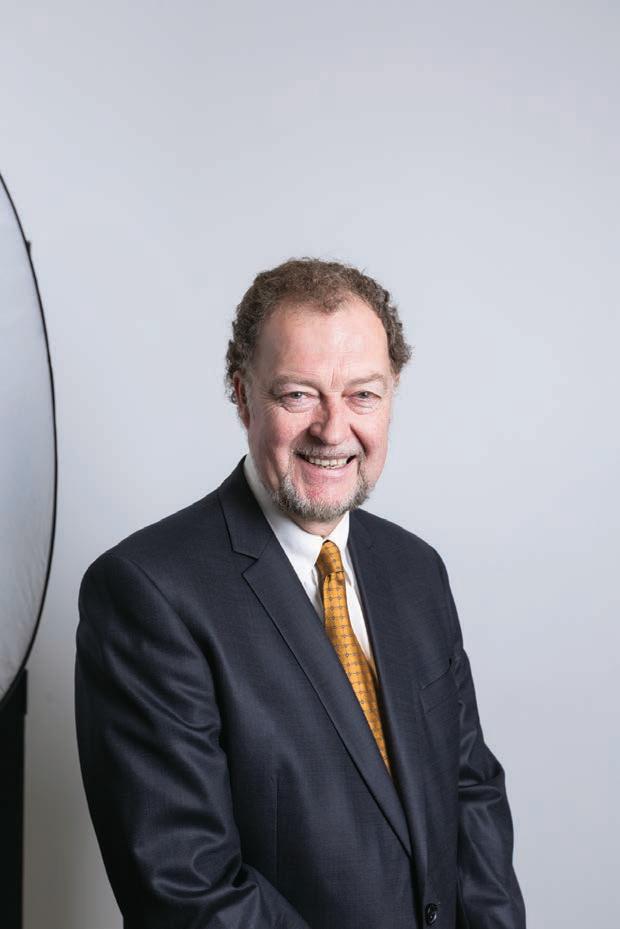
Regulations and regulators for heavy vehicles
community opinions. The following map shows the regulatory structure for conventional road vehicles. The manufacturer or supplier must obtain a Vehicle Type Approval from the Federal Regulator to supply to the market. This is an example of a machine that is Prescribed/Declared. Additionally, the owner must get the vehicle registered. The Australian Design Rules are a necessary but not sufficient technical standard. Additional requirements can be applied by the in-service regulator. For example, a trivial example is that rear marker plates are not mandated by the ADRs but are needed in some states by state regulation. Some vehicle types may require substantial additional features, such as passenger door interlocks on buses operating in NSW or IAP monitoring equipment
on construction vehicles that operate in the Sydney environs or defined oversize vehicles in some jurisdictions. The National Heavy Vehicle Regulator (NHVR) is the relevant regulator for in-service vehicles in much of Australia, but not in WA or the NT. The NHVR does not own any roads and it must obtain the permission from the road owners (states, territories or local governments) before it can issue permits outside above agreed general limits. Frustrations arise because this process can take time. Progress has been made in streamlining the permit process over the last five years. Many vehicle types operate under notices, which publish long or short-term decisions of state and territory governments. Applicable notices can be found on the NHVR website for participating

86 december 2018 INSTITUTE
april 2023
PETER HART
jurisdictions. For example, B-doubles run throughout Australia under notices because their lengths exceed the 19m general road access limit.
The second map shows the regulatory structure for off-road vehicles and for vehicles with plant equipment on top. Many types of off-road vehicle do not, and cannot, comply with the Australian Design Rules because they are not designed to be road vehicles. An example is a back-hoe-front-end-loader. This example cannot be approved but it can still be registered if it has technical features that are acceptable to a road agency or the NHVR. The NHVR website publishes the National Class 1 Agricultural Vehicle Notice. Road vehicle safety aspects are excluded from the scope of the work health and safety (OH&S) regulations in Australia. Plant equipment that might be attached to the vehicle is not excluded from scope; however, many vehicle suppliers fail to recognise this. There are some common plant equipment types that are commonly installed on trucks and trailers that are prescribed/declared equipment under OH&S rules. For example, vehicle loading cranes with a lifting capacity of 10 tonnes or more are prescribed. An approval is needed from an applicable OH&S regulator. Mostly vehicle loading cranes should be approved but seldom are.
Key points
There are three regulators for heavy vehicles: Federal (new vehicles), NHVR & State (in-service), and State Work Safety regulators (plant and workplace).


The vehicle expect that suppliers of vehicles will have a technical file that completely describes the vehicle, and a QA system that helps keep it consistent. The heavy vehicle is a workplace. The Work Health & Safety regulators require suppliers of plant equipment on vehicles to identify the hazards, classify the risks and control them. The risk assessment should be written down.
It is now uncommon for specific occupational registration of plant equipment to be required. For example, Victoria requires a dangerous goods tanker to have a design approval but there is no special DG registration, only road registration. The OH&S regulations do require that suppliers and operators of plant equipment will identify the hazards and control the risks. This procedure should be a must-do for risk management in any business, whether plant equipment is used or not.
A Hazard and Risk Assessment is basic business risk management. When it is done it must be documented. The key points in the box below give some guidance. It is usually straight forward to identify the hazards. For example, people falling off the top of a tanker or roll-away due to a driver forgetting to apply the parking brake with the engine running during load discharge are common issues. What is often harder to assess is the reliability of the protections that exist to control the risks of these hazards. There are tools readily available to guide suppliers and operators to do an adequate Hazard and Risk Assessment. I implore the reader to get such a tool and try it.
Dr Peter Hart, ARTSA-I Life Member
Operators should have a process that frequently causes operational safety to be reviewed. This should be documented.
Basic risk assessment needs detailed answers to the following six questions:
1. Realistically, what could go wrong? (“the hazard”)
2. Under what conditions could the hazard occur?
3. What is stopping the hazard occuring now?
4. How reliable are the hazard preventions and do they need improvement?
5. If improvement is needed, what is the priority?
6. What needs to change immediately?
High and Extreme risks cannot be put off until later. They need urgent action. If the risk is Extreme, stop the process. High and Extreme risks need multiple levels of safety. There should be three independent controls that will stop these hazards occuring. Document what they are. It costs virtually nothing to do a Hazard and Risk Assessment. The cost of not doing one might end your business.
primemovermag.com.au 87 ARTSA-I LIFE MEMBERS Powered by news COMMERCIAL ROAD TRANSPORT
In last month’s column I left readers with the message that in terms of heavy vehicle freight decarbonisation “reality must meet ambition” and suggested for this hard-to-abate sector the Government acknowledge the need for a transition plan.
Recapping for a moment, the Federal Government has set the ambition of 43 per cent reduction in CO2 emissions below the 2005 levels by 2030. Ambition is a good thing; reality however would suggest the need for a transition. I say this based upon known facts as they stand today and a reasonable interpretation of the what future sales of low zero emission vehicles could look like through to 2030.
Last year, 2022, rewrote the record books for new truck sales in Australia. Truck and heavy van sales for the calendar year totalled 44,379 units up almost three thousand units, or 7.2 per cent, over 2021. The increase in sales was due to the increased demand for freight across the country in particular, the customisation of home freight deliveries, a trend that will continue. It was also due to the previous Government’s Temporary Full Expensing incentive. Just 27 of these sales were zero emission vehicles; the figure for Hybrid truck sales was 72 trucks.
Reality Check One – 99 low zero emission sales out of 44,379 sales. Looking forward, the Truck Industry
What’s better, near zero or nowhere near zero?
Council (TIC) forecasts a year-on-year doubling of low zero emission truck sales to 2030. As policy settings stand now, TIC is expecting that approximately one in four new truck sales in 2030 will be low and zero emission vehicles. By 2030 there will be approximately 18,000 such trucks operating in Australia. This will equate to just two per cent of our truck fleet.
Reality Check Two - 98 per cent of the fleet will still be diesel; given the current average age of the Australian truck fleet, new diesel trucks sold today will still be in operation in 2050. Predicting beyond 2030 is difficult because beyond existing hybrid, battery electric and hydrogen fuel cell technologies, the reality is that OEMs are working on various technologies to satisfy the task at hand and the needs of customers, as no single current technology can achieve carbon neutrality across the freight sector.
Reality Check Three - All truck manufacturers around the world are working on a suite of carbon reducing technologies to meet the targets set by governments.
TIC’s National Low and Zero Emission Heavy Vehicle Strategy will include a transition plan that acknowledges there is a role for low emission trucks already in the market such as hybrid electric technologies which save between 20 to 30 per cent CO2 emissions. The transition is very much underway with OEMs voluntarily introducing Euro VI trucks into the market before being mandated by Government. With each new Euro VI truck comes advanced fuel saving technologies resulting in up to 7 per cent fuel savings, meaning an
equivalent reduction in CO2 emissions. Reality Check Four - The transition to a heavy vehicle low zero emission future has already started.
Future measures include:
• Paving the way for the use of Low Carbon (renewable) diesel blends for use across the existing fleet, an approach not receiving a lot of attention in policy terms by governments across the world.
• Removing regulatory impediments allowing for High Productivity Vehicles to access more of the Australian road network, in other words, carrying more freight with less trucks, emitting less CO2
• Allowing 7-tonne steer axle mass for Euro VI trucks; 2.55m vehicle width, essential for all future zero emission vehicles and further increases to axle mass for low and zero emission vehicles to compensate for the extra weight of these new technology vehicles.
The point also needs to be made that zero emissions cannot be achieved through technology only, society in general are part of the solution. This will require behavioural change: operators making the decision to renew old trucks; operators changing to low carbon fuels; consumers consolidating orders; and Government introducing meaningful incentives that encourage behaviour change.
In this hard-to-abate sector, what’s better, near zero, or nowhere near zero?
Tony McMullan CEO, Truck Industry Council

INSIGHT | TRUCK INDUSTRY COUNCIL 88 april 2023
With the 2023 federal political year well underway and Treasurer Jim Chalmers laying the groundwork for his second budget in less than a year, it’s worth reflecting on the tremendous opportunities that exist for genuine heavy vehicle reform after years of delay. The election of the Albanese Government last May, along with state elections in 2022 that saw Labor win or retain government in South Australia and Victoria, means the ALP now occupies the treasury benches federally and in six of the seven Australian states and territories. By the time this column goes to print, that number may have grown to seven of seven if Labor wins the New South Wales state election next month, as current polling suggests it will. This would see the same party in government in every state and federal jurisdiction, providing an opportunity for consensus and action in numerous policy areas, including heavy vehicle reform.
This opportunity presents in the context of state and federal transport policymaking that has generally been in a holding pattern for over eight years, particularly in the critical areas of heavy vehicle national law, licencing, and productivity.
The National Transport Commission’s latest review of national heavy vehicle law theoretically should be completed,

Stars align for heavy vehicle reform
with draft law due to be presented to state and federal ministers this year. This is essential to restore credibility and confidence in the NTC from transport groups frustrated by little to no decisions, direction, or development in years.
Licencing laws are also in a box seat for overhaul, with several transport groups aligned on the need to focus attention on skills and training as qualifiers for heavy vehicle licencing instead of experience alone.
While predominantly a state or territory issue, our licencing regulations and requirements must be changed to attract new and young people to the transport profession, with minimum thresholds introduced to require days – not hours –of practical, behind the wheel training by qualified instructors for candidates to be granted a heavy vehicle licence.
This is a key policy area for the VTA in 2023, with our time-based graduated Driver Delivery program licencing model validated through its extension by the Victorian Government, and funding for forklift and other drivers and logistics workers allocated involving a similar minimum threshold model when it comes to time spent in the classroom and under supervised, practical instruction.
It is essential that we change the narrative that experience alone makes a driver better or safer. This can only be achieved by introducing new licencing laws in as many jurisdictions as possible that prioritises skills and training over experience.
These years of delay by some state and federal bodies have had massive productivity implications for operators that are already being hammered by rising costs, chronic worker shortages, and a shrinking capacity to grow or at
least maintain slim margins. This is exacerbated by some of the safeguards in place to protect operators being under attack, such as what we saw earlier this month with the Grattan Institute’s short-sighted calls for the Fuel Tax Credit (FTC) to be halved to reduce the budget deficit and reach reduced emissions targets sooner.
As well as increasing prices for households already under pressure from higher interest rates and inflation, all such an FTC reduction would achieve is increase the tax burden on operators that already pay higher registration fees and a Road User Charge, forcing them to raise their prices, which ultimately gets passed back onto consumers through more expensive goods and services.
Often overlooked in discussions around heavy vehicle reform is that transport operators and the industry groups that advocate for them are the customers of the bureaucracy, and as customers we’ve generally been poorly served in recent years. Through all this we’ve continued to service the needs of our customers and Australian consumers, getting the job done and servicing the growing freight task.
With there now being general political consensus in place across the length and width of Australia, there has never been a better or more opportune time to attain the reforms that have evaded the transport industry for years. The results will be a safer industry that provides productivity, efficiency, and sustainability dividends for parties to every freight transaction including operators, customers, and consumers.
Peter Anderson CEO, VTA

Powered by news COMMERCIAL ROAD TRANSPORT VICTORIAN TRANSPORT ASSOCIATION | INSIGHT
STUART ST CLAIR
PETER ANDERSON
primemovermag.com.au 89
Deadwood Deadlines
last year and the YTD of 1,015 shows an additional 50 trucks for a growth rate of 5.2 per cent.
The Heavy Duty sector came just 56 trucks short of exceeding the Light Duty result in terms of units sold. The February total of 1,224 is 195 more than for the same month last year (+18.9 per cent) and the YTD of 2,168 added an extra 401 units for a growth rate for the year thus far of 24.0 per cent. It may be early in the year but with supply improving markedly already, the industry can expect another excellent year in 2023.
Interest rates, changes to taxation on superannuation and improvements in doing business with China have been in the news since the beginning of the year, but a potentially concerning factor which hasn’t received quite as much press is the Australian Taxation Office’s push to collect $33 billion in past tax assessments from what are going to be predominantly middle-sized and smaller companies, which by definition will include many transport operations. The BAS deadline at the end of February was possibly a factor in the decision by the owners of Scott’s Refrigerated Logistics to call in the administrators, which quickly morphed into receivership. The building and construction industry is facing its own problems with a number of home and apartment builders folding or in a position of serious financial embarrassment. Road transport is not immune from the problems in the building industry and extended payment terms should be a concern for many operators who will be forced to join the queue of unsecured creditors when the next big builder folds. However, the demand for new trucks and heavy vans continues on its surge, driven in a large part by the impending cessation of the immediate tax write off for new equipment and also the improvement in availability of vehicles, many of which were ordered some two years ago.
The Truck Industry Council’s statistics for February show 3,074 trucks and 425 Heavy vans were delivered during the month. The truck YTD total of 5,452 for the first two months of 2023 is 929 more than for the same period in 2022 (+20.5 per cent) and the Heavy Van sector continued its rebound which started mid-2022 and the YTD total for 2023 of 832 is an encouraging 335 more than at the end of February 2022 (+57.4 per cent).

Light Duty trucks provided 1,280 units of the month’s total, an increase of 257 trucks (+25.1 per cent) on February last year and the YTD of 2,269 represents an additional 478 units (+26.7 per cent).
The Medium Duty sector was steady at 570 units for the month being just 26 units (+4.8 per cent) more than February
PETER SHIELDS’ NUMBER CRUNCH 90 april 2023
Feb-23YTDChange ISUZU 1084198442.4% FUSO 389 690 2.1% HINO 410 659 -16.6% KENWORTH 251 448 19.1% VOLVO 269 447 62.0% IVECO 139 229 33.9% UD TRUCKS 114 185 59.5% MERCEDES-BENZ 84 165 32.0% SCANIA 57 115 16.2% MACK 48 101 -8.2% DAF 57 97 47.0% FIAT 37 87 -5.4% FREIGHTLINER 30 48 -14.3% RENAULT 13 47 67.9% MAN 33 46 2.2% HYUNDAI 16 41 20.6% WESTERN STAR 17 28 -40.4% VOLKSWAGEN 14 21 110.0% DENNIS EAGLE 7 9 80.0% SEA ELECTRIC 4 4 300.0% FORD 1 1 -80.0% CABCHASSIS/PRIME3074545220.5% M-B VANS 164 366 79.4% VOLKSWAGEN VANS 114 165 146.3% RENAULT VANS 60 117 5.4% IVECO VANS 41 93 138.5% FIAT VANS 44 88 137.8% FORD VANS 2 3 -92.3% VANS 425 832 67.4% TOTAL3499628425.2%

































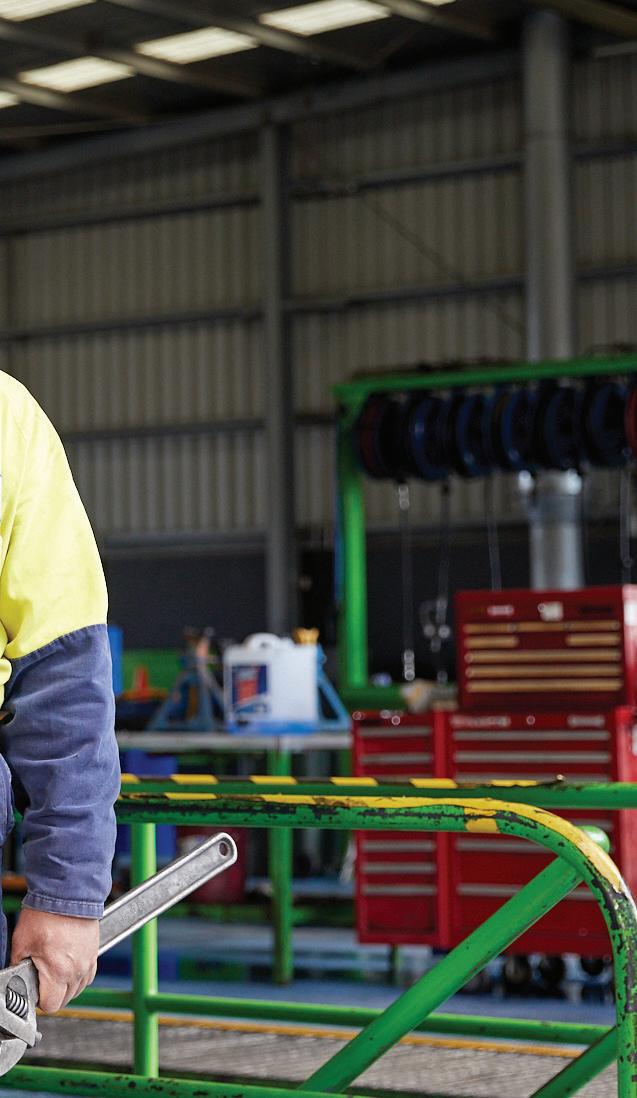

TWU Nominees Pty Ltd, ABN 67 002 835 412, AFSL 239163, is the trustee of TWUSUPER ABN 77 343 563 307 and the issuer of interests in it. TWUS 7267 TWUSUPER offers tailored insurance for our members so they have financial peace of mind should the unexpected ever happen. This insurance protection is available for members young and old in any occupation, even drivers, loaders and forklift operators. Through life’s ups and downs, we’re here to help and support the people who keep Australia moving. Choose the fund that’s got you covered If you work in transport, choose TWUSUPER. Your transport super fund covers ‘dangerous occupations’ Call 1800 222 071 Visit twusuper.com.au/insurance Payments approved by TWUSUPER in 2020-21 $58.5m Many super funds don’t cover dangerous occupations like transport jobs. TWUSUPER is different.
HIGH PERFORMANCE IN HIGH TEMPERATURES WITH SHELL RIMULA ULTRA

Shell Rimula ULTRA works harder to reduce your costs, with up to 2% increase in fuel economy*, so you stay on the road for longer.

Heavy Duty Diesel Engine Oil


*Compared with a typical 10W-40 oil over a 100,000 km oil drain interval. Scan here to find out more

































































































































































































































































































































